THE UNIVERSITY OF MELBOURNE

THE MAGAZINE OF TRINITY COLLEGE 2022 ISSUE #91
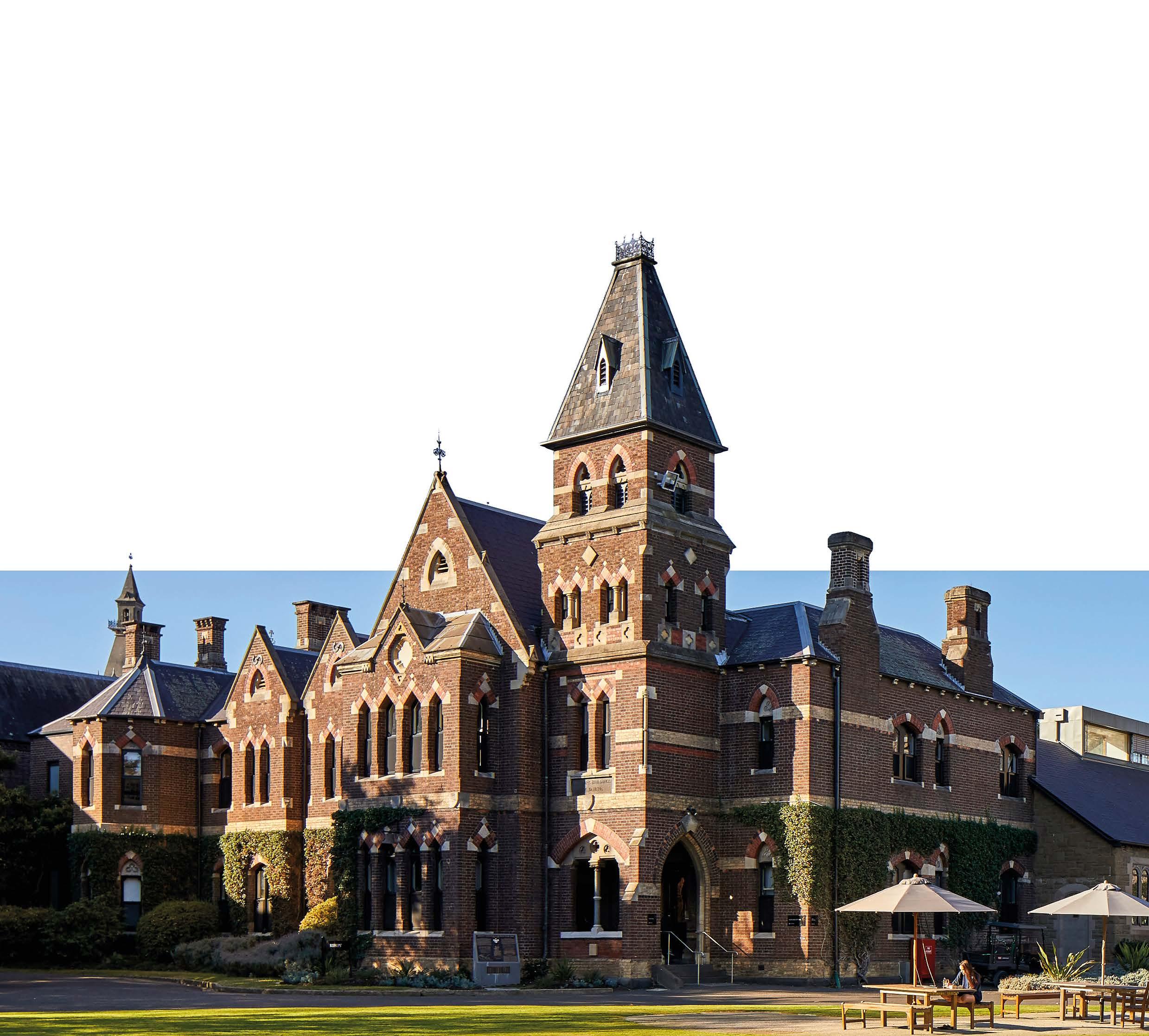

1876 Trinity College is affiliated as a college ‘of and within the University of Melbourne’. The first Warden, Dr Alexander Leeper, takes office and introduces a system of College tutorials to supplement University lectures, thereby establishing the College as a centre of academic excellence.

1877

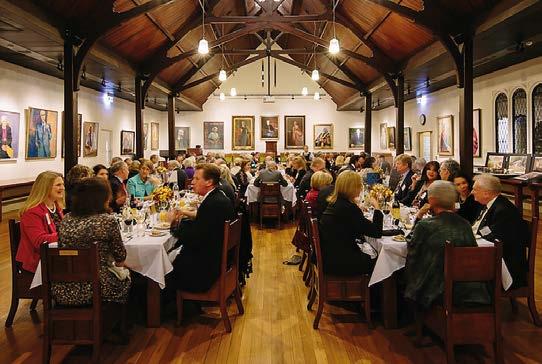
Trinity College Theological School is established by the second Bishop of Melbourne, James Moorhouse, to provide theological training and ‘a large and liberal education’ for Anglican clergy.

1878
The first residential building, designed by Frederick Wyatt and named Bishops’ (after Perry and Moorhouse), opens, with 23 bedrooms, 12 studies, a lecturer’s flat, four bathrooms, a billiards room and a lecture hall (Cripps Middle Common Room). This allows for the renovation of the original building to house a library, chapel and dining hall.
1921 The Trinity College Women’s Hostel is renamed Janet Clarke Hall.

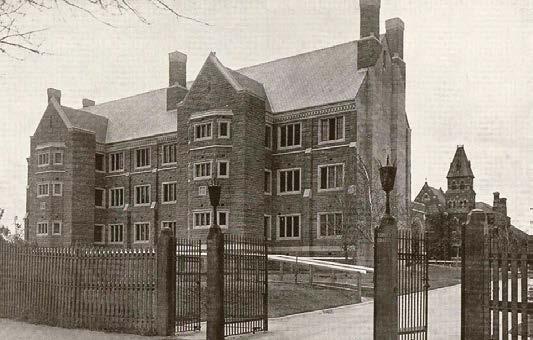
1924
The Trinity College Trusts Corporation is formed to manage endowment funds.
1935
The Behan residential building opens, providing larger rooms that serve both as bedroom and study. Behan is the only Trinity building to be based on the Oxbridge ‘staircase’ model.
1942
During World War II, the College is used as the headquarters of the Royal Australian Air Force School of Administration, and up to 225 Air Force trainees are barracked.
2011
The Trinity Institute is established to offer leadership programs for high school students, professional learning for teachers and open-learning opportunities for all.
1927
The first Trinity College Act is passed by the Victorian Parliament, under which the lands of the Crown grant are transferred from the trustees to the Trusts Corporation.
The first (temporary) Dining Hall is completed to a design by William Pritchard. The present stone structure and wooden furniture date from 1925, when extensions were made and new kitchen facilities added. The high table extension to the east was completed in 1955.
1880
2012

The Dining Hall is refurbished with an updated kitchen, heating and cooling added, lighting and acoustics upgraded and an informal dining space developed.
2014

The Theological School becomes an independent college of the new University of Divinity (formed from the Melbourne College of Divinity in 2012).
2015 Professor Kenneth Hinchcliff (TC 1976) is appointed as the eighth Warden.
2016 The Gateway Building opens, and is then formally opened by the Governor-General at the start of 2017.
2018
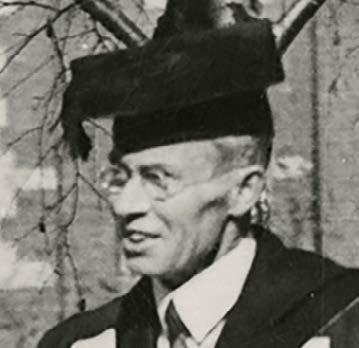

A new strategic plan called ‘Unlocking Exceptional Promise’ provides for an expanded College and generous scholarship program.
1914
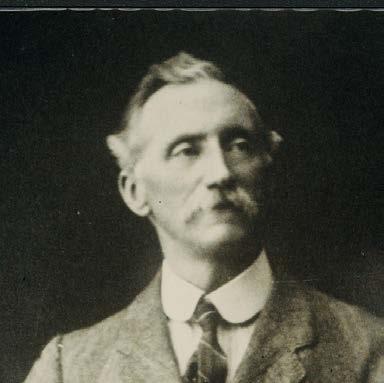
The foundation stone is laid for the College Chapel, built to a design by Alexander North. The building is completed in 1915 and the Chapel is consecrated on 24 November 1917.
1918 (Sir) John Behan (TC 1903) is appointed as the second Warden.
2020 A new residential wing is opened in the north-east precinct of Trinity’s main campus and is named the Dorothy Jane Ryall building (‘Dorothy’).
2020 -2021
The COVID-19 pandemic forces the Theological School and Pathways School to teach entirely online for the majority of a two-year period.
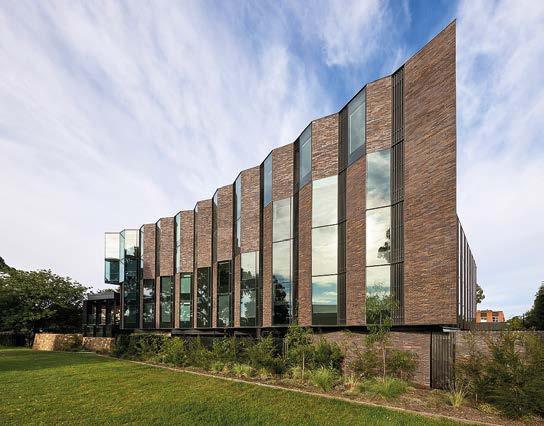
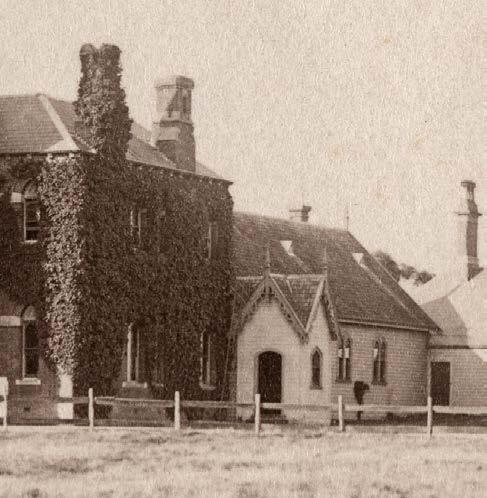
The first female student, Lilian Helen Alexander, is admitted to the College as a nonresident. Trinity becomes the first university college in Australia to admit women.
1883
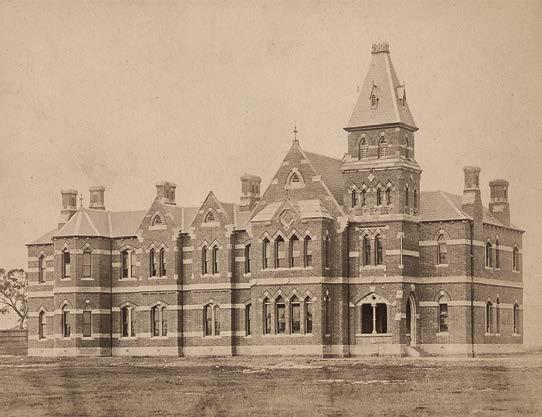
1886 Trinity College Hostel (later Janet Clarke Hall) is established as the women’s residential section of the College, Australia’s first residential college provision for women. The Revd Thomas Jollie Smith is appointed as the hostel’s first principal.
1888
The Clarke Buildings are completed. Designed by Edmund Blacket and named after the principal donors, Joseph Clarke and his brother Sir William Clarke, the building contains bedrooms and studies for 24 students, tutors’ flats, a new billiards room and a common room.
The Janet Clarke Building of the Trinity College Hostel opens.
1891
2022 T rini T y C ollege C elebra T es i T s 150T h a nniversary
TELL US WHAT YOU THINK
Email your feedback about this edition of Trinity Today to tt@trinity.unimelb.edu.au or write to us at:
Trinity Today
Marketing, Communications and Events Trinity College 100 Royal Parade Parkville VIC 3052
RECOGNISE ANYBODY?
If you recognise yourself or a colleague in a photograph that isn’t captioned, let us know at tt@trinity.unimelb.edu.au

MANAGING EDITOR
Emily McAuliffe
Communications Manager, Trinity College
SUBEDITOR
Mary Downes MediaXpress
DESIGNER Bill Farr MediaXpress
CONTRIBUTORS
Dr Calvin Bowman
Jerome Cubillo
Andrew Farran
The Most Revd Dr Philip Freier
Professor Ken Hinchcliff Warden and CEO, Trinity College
The Revd Dr Luke Hopkins Trinity College Chaplain
The Revd Jenny Inglis
Megha Kapoor
Gillon McLachlan
Pippa Skillington
Digital Manager, Trinity College
Dr Benjamin Thomas

Rusden Curator – Cultural Collections, Trinity College
IMAGES
Kit Haselden Photography, Trinity College
Archives, State Library of Victoria, Dan Rankin, Isabelle Napier, Sophia GawanTaylor, Terry Lane, Steve Morton, and supplied by alumni, students and friends of Trinity College.
Information in this magazine was understood to be correct at the time of printing. Views expressed in Trinity Today do not necessarily reflect the views of Trinity College.
Trinity Today is printed on Pacesetter Satin FSC®, which is manufactured using low environmental impact FSC® certified pulps in a facility that is ISO 14001 Environmental Management System accredited.

TRINITY ON TREND
ECLECTIC AND EVER EVOLVING
TRINITY TODAY ● 06 CONTENTS
We acknowledge the traditional custodians of this country and pay our respects to elders past, present and emerging.
TRINITY TIMELINE 03 WARDEN’S WELCOME 05
SNAPSHOT 08
TRINITY COLLEGE OAKLEAF AWARDS 12
TRINITY UP IN LIGHTS 16
ART AT TRINITY 20 DR CALVIN BOWMAN 24 TRINITY V ORMOND 26 TIGER WOO! 28 GILLON McLACHLAN 32 MERCURY RISING 34 ON BEING ‘EDUCATION PEOPLE’ 36 TAKING A HOLISTIC VIEW 38 JEROME CUBILLO 40 EXPRESSING ANGLICAN IDENTITY 42 A MATTER OF FAITH 44 THE REVEREND JENNY INGLIS 46 TRINITY ON TREND 48 MEGHA KAPOOR 54 A NEW ERA FOR OUR DINING HALL 56 THINK BIG, GIVE BIG 58 ANDREW FARRAN 60 WALKING THE ROAD TO SUCCESS 62 SIBLING SUPPORT 64 UNITED ON THE PATH TO ADULTHOOD 66 EVENTS GALLERY 68 OBITUARIES 76
MERCURY RISING
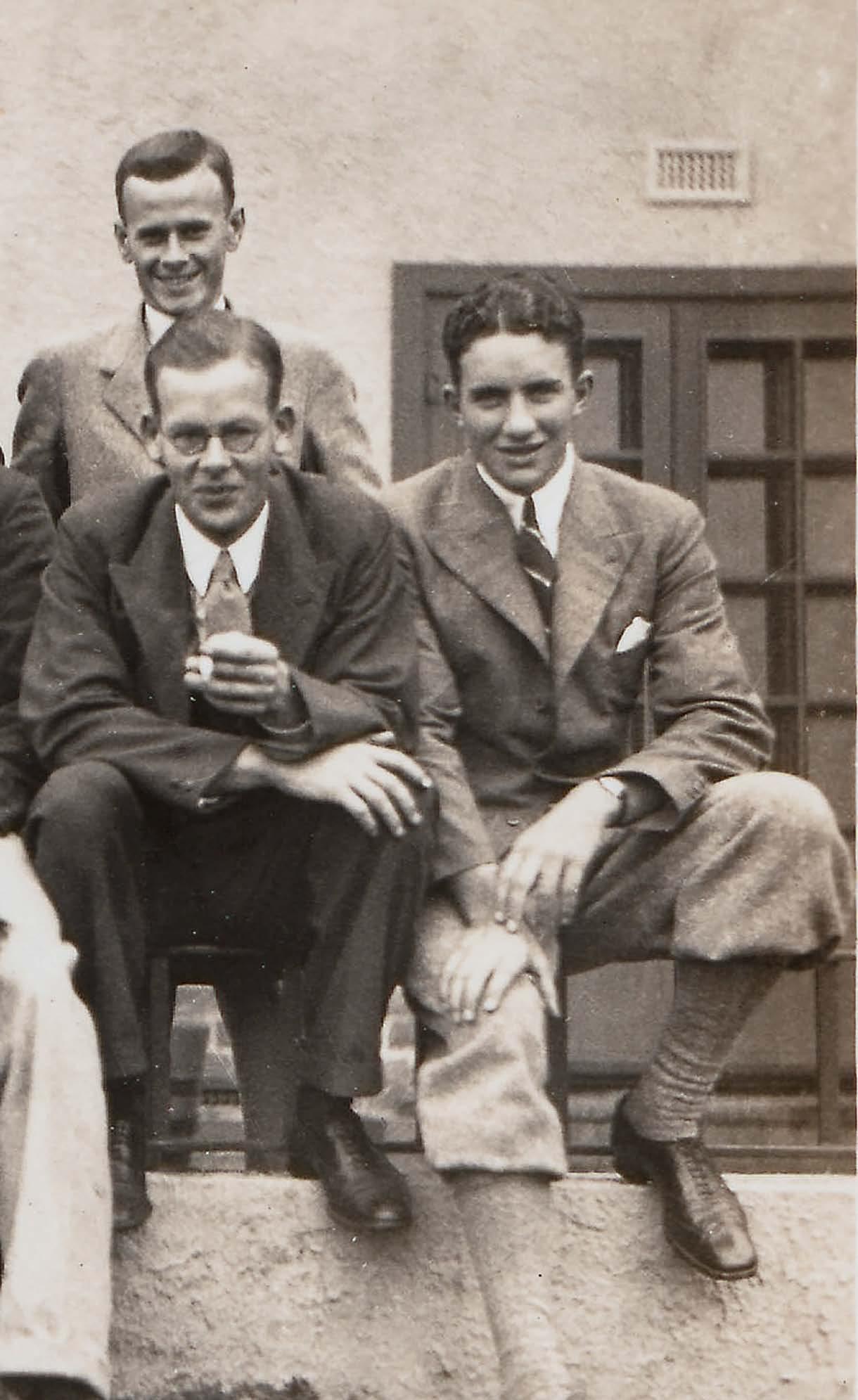
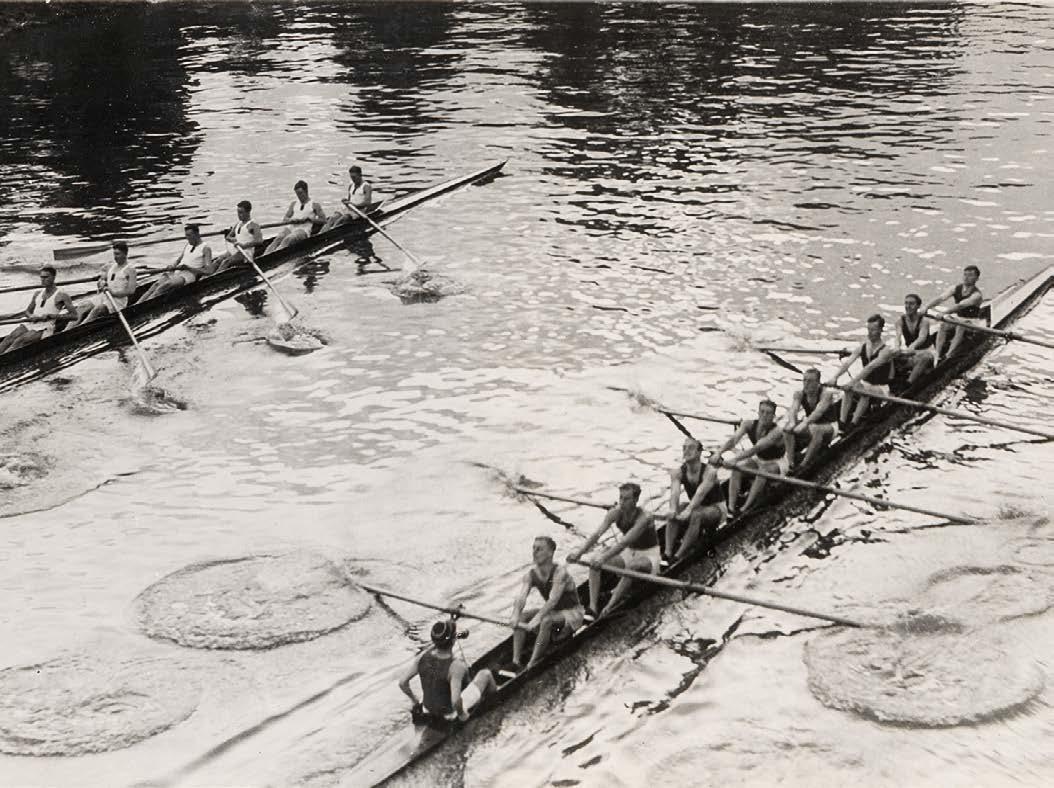

CONTENTS ● 07 TRINITY TODAY
ORIGINS OF ADVERSITY
take a look at the fashions seen
the
We
around campus over
years. 48
Long-time Trinity College staff member Dr Peter Campbell wrote a book on Trinity’s history, The Triumphs of Our Fleur-de-Lys: 150 years of Trinity College Melbourne. The book begins by outlining discussions about the foundation of a university in Melbourne in the late 19th century, then documents the College’s development to the present day, including photos and illustrations.
Purchase via Trinity’s online shop: shop.trinity.unimelb.edu.au

Residential College students and young alumni celebrated our 150th anniversary with a special ball at the MCG in August.


SNAPSHOT 2022
TRINITY TODAY ● 08 NEWS
In June, Theological School Dean Bob Derrenbacker co-led a group of 24 pilgrims to the Holy Land (Israel and the Palestinian territories), with the Rt Revd Dr Stephen Andrews, Principal at Wycliffe College, Toronto. Pilgrims included past and current students and staff, who visited Biblical sites along the Mediterranean Sea, the Galilee, the Jordan Valley and the Dead Sea, as well as the holy city of Jerusalem.
We held five fireside chats throughout the year, where distinguished alumni and friends of the College spoke to students about their vocation and other topics of interest. Pictured is the Hon. Stephen Charles AO KC Keeping Them Honest: the case for a genuine national integrity commission and other vital democratic reforms), who joined the Hon. David Harper AM QC in April to discuss the campaign for a genuine national integrity commission.





NEWS ● 09 TRINITY TODAY
We celebrated NAIDOC Week in August with an intercollegiate Buroinjin tournament (Trinity won!), a smoking ceremony and a screening of the late Archie Roach’s film Wash My Soul in the River’s Flow
We were pleased to announce Vincent Tjendra (TCFS 2007) as our FS Alum of the Year. Vincent is the co-founder and CEO of Astro, which helped provide an essential grocery-delivery service during the pandemic.
In September, we held the annual Archbishop’s Dinner, which helped raise valuable funds for Trinity’s Building our Future Appeal.
SNAPSHOT 2022


We held a Seniors’ Lunch in May, which doubled as a 50-year reunion. Pictured are Robin Murray, John Morgan and Andrew Prentice.
In August, we installed 14 new Fellows. A Fellow is the highest honour bestowed by the College. Congratulations to Syd Bone, Jim Craig, Sue Dahn, the Most Revd Kay Goldsworthy AO, Melissa Gray, Leith Hancock, the Hon. David Harper AM QC, Judy Munro, Dr Brendan Murphy AC, Charles Sitch, Michael Traill AM, the late Angus Trumble, Rick Tudor OAM and Hong Yi (Red).



TRINITY TODAY ● 10 NEWS
In June, the Choir of Trinity College went on a tour of the Northern Territory. The tour included a reception and performance at Government House in Darwin.
In October, we held a gala dinner at Palladium at Crown for almost 900 guests to celebrate our 150th anniversary.
The annual Barry Marshall Lecture in Church Law was held in September. Our guest lecturer was the Ven. Dr Hirini Kaa – Archdeacon for Mātauranga (Aotearoa) and author of Te Hāhi Mihinare, The Māori Anglican Church – pictured with the Revd Canon Dr Bob Derrenbacker.




From 22–27 May, five former Gourlay business ethics visiting professors and our 2023 Gourlay professor travelled to Australia from around the world to participate in a series of events in Melbourne as part of the Gourlay Ethics in Business Week.
In August, Lucie Griffin was elected as our incoming Senior Student for 2023. Lucie says that, as Senior Student, she’s excited to make the most outstanding Trinity experience possible for every Trinitarian. ‘It’s especially important to me that we celebrate everyone’s individuality so we can be the most genuine, welcoming college imaginable,’ she says.
The program included debates, Q&As, panel discussions and hypotheticals that addressed complex ethical issues. Pictured is the panel that discussed the ethics of the COVID-19 vaccine, from left to right, Professor Andrew Cuthbertson AO, Dr Norman Swan, Associate Professor Margie Danchin, Jon Faine, Professor Barbara McPake and Professor Jeremy Moon.
NEWS ● 11 TRINITY TODAY
In May, we held a special Evensong at St Paul’s Cathedral in the CBD, sung by the Choir of Trinity College, to commemorate Trinity’s 150th anniversary.
Trinity College Oakleaf Awards
To commemorate Trinity’s 150th anniversary, a committee of 13 members, representing our three College divisions and chaired by the Warden, was tasked with selecting 150 living alumni and supporters who have made a notable contribution to Trinity, the broader community, or both, within Australia or globally. Our Oakleaf awardees represent many fields and were deemed to be making outstanding voluntary contributions or contributing to the community over and above what might be reasonably expected through employment.

SAMUEL ALLCHURCH for services to music.
JAMES ALLEN for accomplishments in mountaineering.
MARTIN ARMSTRONG for services to the broader community through philanthropy.
PHILLIP ASPINALL AC for services to the Anglican Church.
NICHOLAS AUSTIN for services to the environment.
JOEY AZMAN for entrepreneurship and innovative business in Southeast Asia.
TIMOTHY BAIN for services to the creative arts and entertainment.
CAMPBELL BAIRSTOW for services to the College through leadership.
ROSS BASTIAAN AM RFD for commemorating Australia’s war history.
ANNE BEISCHER for services to health and the community through philanthropy.
EMMA BELCHER for endeavours promoting nuclear disarmament.
JACK BEST AO for services to advancing the health of Australians and for philanthropy.
TRINITY TODAY ● 12 OAKLEAF AWARDS
CONGRATULATIONS
PHOTO: KIT HASELDEN PHOTOGRAPHY
CONGRATULATIONS
SIMON BIRKETT for services to the environment.
ROSEMARY BLIGHT for services to the College through innovative teaching.
NGAREE BLOW for services to Indigenous health education.
CALVIN BOWMAN for services to music.
GRAHAM BROWN AM for leadership of programs to control infectious diseases.
JANNIE BROWN for services to music and the advancement of young Australians.
LISA-MARIE BROWN for services to veterinary medicine.
CHLOE BUITING for services to wildlife veterinary medicine and conservation.
BARBARA BURGE for services to the College and medicine.
GEORGINA BYRON AM for services to the community through philanthropy.
ANDREW CANNON AM for services to international relations and philanthropic causes.
NICHOLAS CARTER for services to music.
STEPHEN CHARLES AO QC for services to the law and integrity of public institutions.
ANTHONY CHEONG for services to the community through philanthropy and trade in Southeast Asia.
ISABEL CHEONG for services to the Singaporean people.
IAN CHESTERMAN AM for services to sports administration.
XIN YI (RONNY) CHIENG for services to the dramatic arts.
WU CHUN for services to the performing arts.
JANE CLARK for services to the visual arts.
SANDY CLARK AO for services to viticulture and the arts.
RAYMOND CLEARY AM for services to theological education and the Anglican Church.
HAMISH COATES for services to higher education in Australia and China.
REBECCA COATES for services to the visual arts.
STEPHEN CORDNER AM PSM for services to medical sciences.
JAN CRIPPS for services to the community through philanthropy and voluntary work.
JEROME CUBILLO for the promotion of Indigenous business.
ANDREW CUTHBERTSON AO for services to medical sciences.
BRYAN CUTTER for services to the community through philanthropy and to advancing the health of Australians.
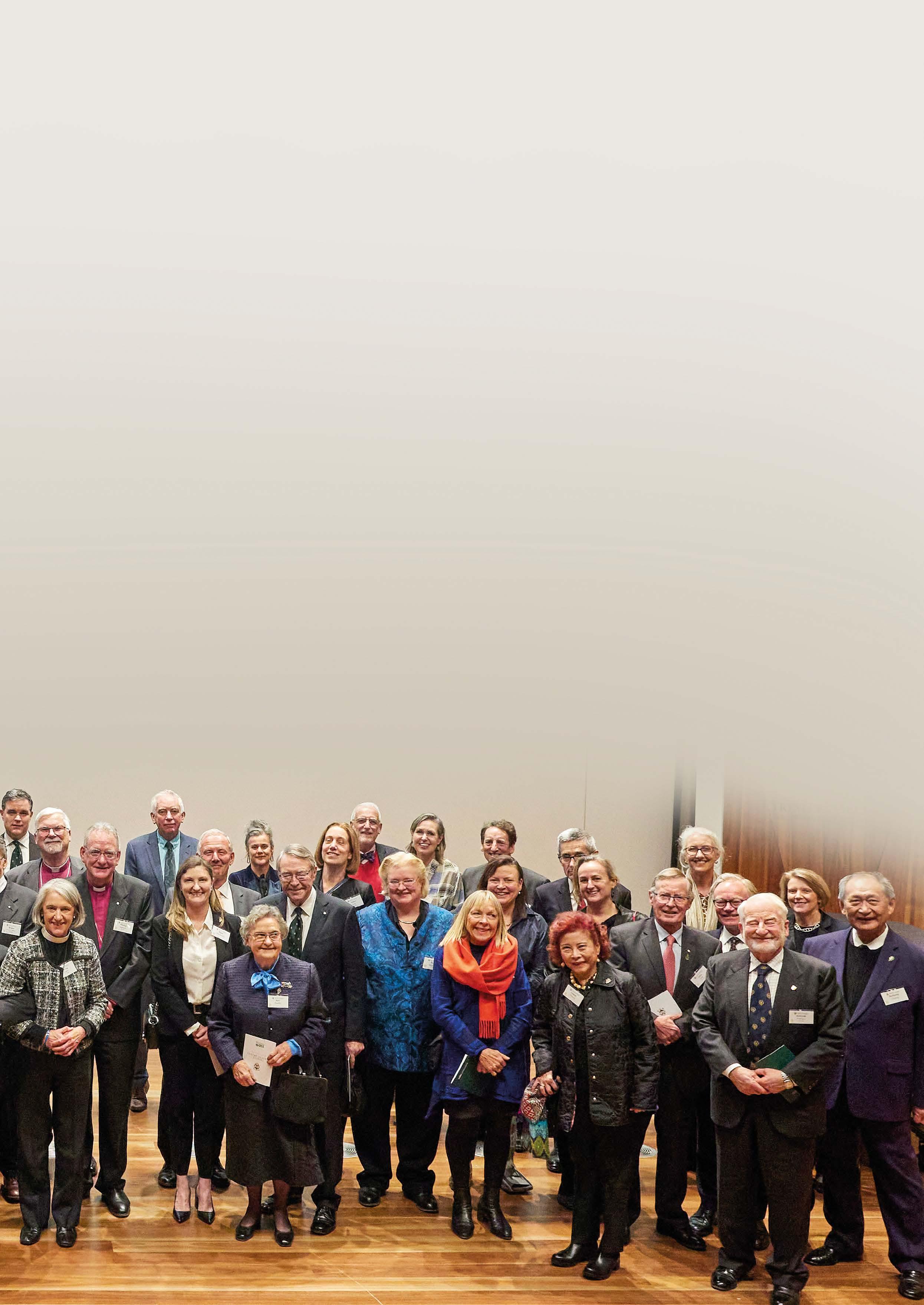
ROSEMARY CUTTER for services to the community through philanthropy and voluntary work.
JOHN DALEY AM for services to public policy.
THUY TRANG DANG for services to social enterprise in Vietnam.
KATHARINE DRUMMOND AM for services to medical science.
PHILIPPA DUFFY for the promotion of women in management consulting.
THOMAS ELLIOTT for services to broadcast media.
ANDREW FARRAN for services to public policy, law and the community through philanthropy.
SASHINI FERNANDO for services to marine conservation in Sri Lanka.
WAI HONG FONG for business innovation in Southeast Asia.
JANE FREEMANTLE OAM for services to medicine and the Anglican Church.
PHILIP FREIER for services to the Anglican Church.
CARRILLO GANTNER AC for services to the arts.
JAMES GARDINER OAM for services to the LGBTIQ community.
RONA GLYNN-McDONALD for the promotion of Indigenous culture.
LISA GORTON for services to literature.
SIMON GRIFFITHS for services to social enterprise.
RICHARD GUY OAM for services to regional communities.
DAVINA HANSON for services to the community and education through philanthropy and voluntary work.
STEVE HASKER for services to global journalism and media.
DAVID HAWKER AO for services to the Australian government.
HAIDA HAZRI for services to economic development in Malaysia.
TIMOTHY HEATH for entrepreneurship and innovative business in Europe.
OAKLEAF AWARDS ● 13 TRINITY TODAY
ROSE HISCOCK for services to museums and galleries.
SHONAE HOBSON for the promotion of Indigenous art and fashion.
ROMAYNE HOLMES for services to medicine.
CHLOE HOOPER for services to literature.
HUGH HUNT for services to engineering and higher education.
JENNY INGLIS for services to the Anglican Church.
ROBERT JOHANSON AO for services to charitable causes supporting India.
FLEUR JOHNS for services to tertiary education and the law.
AMELIA JONES for services to the community through entrepreneurship and innovative business.
FIONA JUDD AO for services to women’s mental health.
MEGHA KAPOOR for services to the fashion industry.
BRYAN KEON-COHEN AM KC for services to Indigenous land rights.
JOHN KING AM for services to medicine.
THOMAS KING OAM for accomplishments in sailing.
DAVID KOCZKAR for services to the health insurance industry.
ROBERT KOCZKAR for services to social enterprise.
MILES KUPA for international diplomatic service.
ROBERT LEAN for humanitarian activities in Nepal.
IVAN LIM for services to the community through entrepreneurship and innovative business.
MICHELLE LIM for services to mental health.
TIMOTHY LINDSEY AO for services to the law and higher education.
MARGARET LUSH for services to medicine and the community through philanthropy.
MAYATILI MARIKA for the promotion of Indigenous culture.
THORNTON McCAMISH for services to the dramatic arts and homelessness.
DUNCAN McFARLANE for services to engineering and higher education.
SIMON McKEON AO for services to science.
GILLON McLACHLAN for services to sports administration.
MIKE McLEISH for services to the performing arts.
JULIAN McMAHON AC SC for services to human rights.
GLEN MOLA for services to women’s health in Papua New Guinea.
ALI MOORE for services to broadcast journalism.
JOHN MORGAN AM for services to higher education.
MARGARET MORONEY for services to Indigenous education.
GEOFFREY NETTLE AC for services to the law.
KATHERINE LI PEI NG for entrepreneurship and services to the community.
AMY NISSELLE for advancement of medical science through education.
COLLEEN O’REILLY AM for services to the Anglican Church and the College.
LIZZIE O’SHEA for services to the performing arts.
LENORE PARKER for services to the Anglican Church and Indigenous theological education.
ANTHONY PARKES AM for services to the Anglican Church and the College.
DAVID PARSONS for services to the law and support of Indigenous legal services.
JENNIFER PEEDOM for services to the film industry.
JOHN PETTIT for services to the community through philanthropy and to the Anglican Church.
MURIEL PORTER OAM for services to the Anglican Church.
ANDREW PRENTICE
for services to mathematics and science.
CHRISTOPHER RENWICK AM for the promotion of Indigenous education.
CATHERINE RIGBY for services to higher education.
BRIAN ROBERTS for services to education for young Australians through philanthropy.
JUNE ROBERTS for services to education for young Australians through philanthropy.
HELEN ROFE for services to the law and intellectual property.
CHRISTOPHER ROPER AM for services to canon law.
ANN RUSDEN for services to education and public institutions.
GEOFFREY SABA for services to the performing arts.
JANINE SARGEANT AM for services to medical sciences and to the community through philanthropy.
CLARE SCOTT AM for services to medicine.
JOHN SEVIOR for services to education for young Australians through philanthropy.
LYNDSAY SHARP for services to regional development.
PETER SHERLOCK for services to theological education.
ROBERT SITCH for services to the performing arts.
ALEXANDRA SLOAN AM for services to broadcast media.
MICHAEL SMALLWOOD for services to the performing arts.
ELIZABETH SMITH AM for services to the Anglican Church.
TOM SNOW for leadership in the marriage equality campaign.
JANTO SO for services to international education.
ANDREW ST JOHN DD for services to the Anglican Church.
SIOBHAN STAGG for services to the performing arts.
ELSDON STOREY AM for services to medical research.
DAVID STUDDERT for services to the law, medicine and higher education.
DAVID TAN for services to the arts, law and education.
MIMI TANG for services to medicine.
GEORGINA TAYLOR for services to primary healthcare.
AMY TENNENT for services to the education of young people in Cambodia and Australia through philanthropy.
MICHAEL THWAITES for international diplomatic service.
MATTHEW TILLEARD for the promotion of sustainable development.
TRAN NHAN HAU (BELLE) TO for entrepreneurship and services to the community.
KATHERINE TREBECK for the advancement of environmental sustainability and social justice.
SUNYA VIRAVAIDYA for services to medicine in Thailand.
ANNE WARD for services to public institutions.
NICOLA WATKINSON for services to international relations.
BRENDAN WELSH OAM for services to Indigenous education.
BRUCE WILSON for services to health and the community through innovative business and philanthropy.
MARY WOOLDRIDGE for services to the Victorian community.
PHOEBE WYNN-POPE for services to human rights.
EE JUEN HANNAH YONG for services to medical sciences.
SERENE YONG for services to international education.
BOON YOONG for services to medicine.
TRINITY TODAY ● 14 OAKLEAF AWARDS
CELEBRATING 150
YEARS
OF ART AND CULTURE
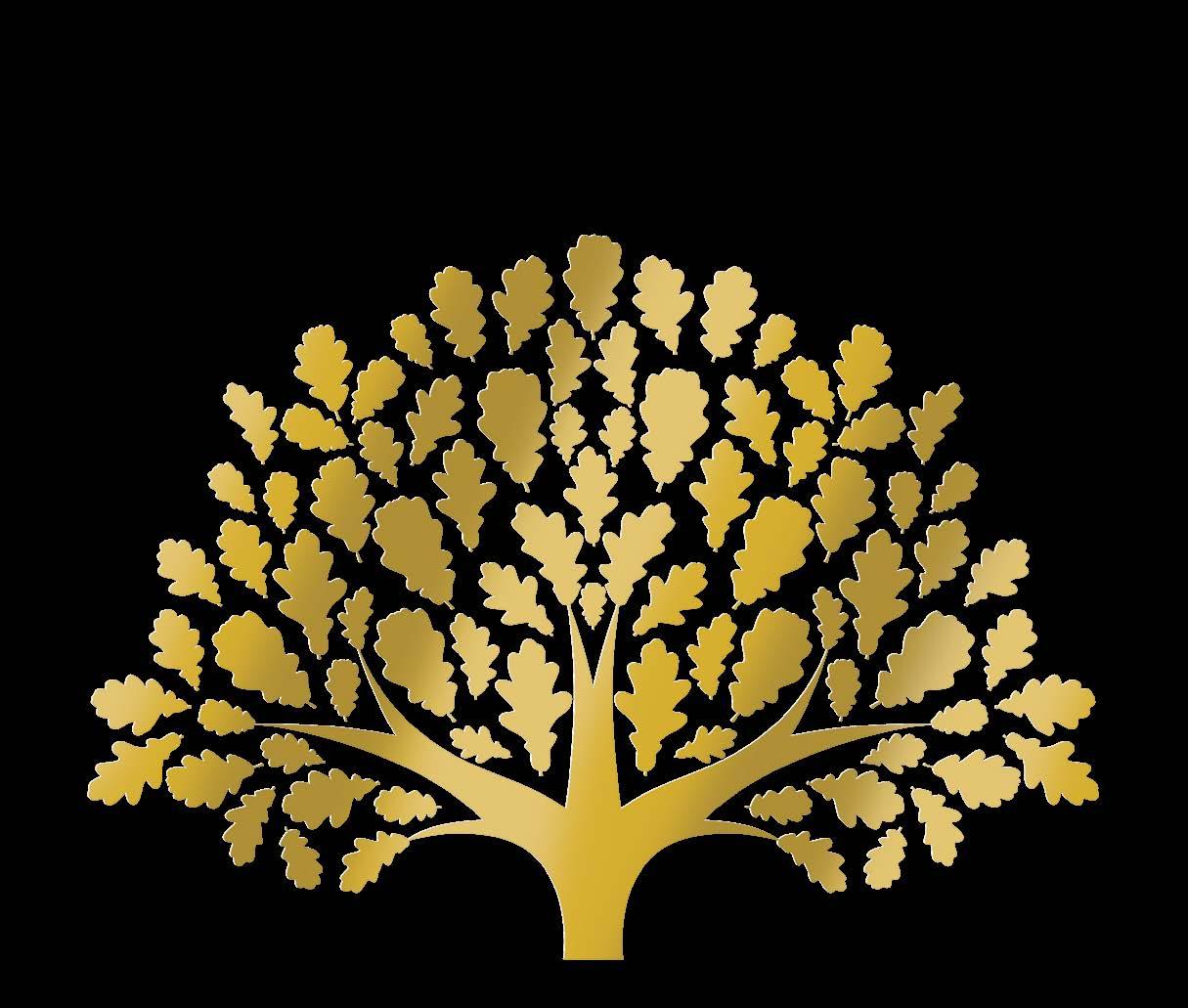
● 15 TRINITY TODAY
TRINITY UP IN lights

TRINITY TODAY ● 16 ART AND CULTURE
BY DR BENJAMIN THOMAS
‘S
eneca cannot be too heavy nor Plautus too light for the keen apprehension of dramatic necessities possessed by the students of Trinity College, Melbourne,’ praised the Herald in 1881, citing Polonius’ utterances to Hamlet. What made Mostellaria (The Haunted House), a comedy by the Roman playwright Ticus Maccius Plautus (254–187 BC), even more notable to its Melbourne audience was that it was the inaugural play presented by students of Trinity, and the first performance of its kind in Australia – a classical play performed in its original language, Latin.
Mostellaria was performed in Trinity College’s original timber Dining Hall, which was decorated for the event by John Hennings, a scenic artist at Bourke Street’s Theatre Royal, with flags, wreaths and sprigs of evergreens – the whole serving as a backdrop to the set of an Athenian street. The main driveway was lined with Chinese lanterns, which formed a graceful arc around the eastern edge of the Bulpadock.
The classics
Trinity favoured classical plays for much of the 1880s, as young College thespians presented more works by Plautus: Rudens in 1884, followed by Aulularia in 1887. Performed in April at the Masonic Hall on Collins Street, Aulularia was produced as a fundraising event in support of the Trinity College Hostel, the women’s residential hall that had opened the previous year in a two-storey terrace house on Sydney Road. ‘The lady students apparently are not yet strong enough in classics to assist their

Trinitarians have been taking to the stage since the late 19th century. From classics to comedies, these student productions have reliably showcased exceptional talent and have, for better or worse, often attracted media attention. We look at the trajectory of Trinity’s performing arts scene.
Jack Wright (TC 2014) with cast performing the College musical, Cabaret, Union Theatre, University of Melbourne, 2015.
ART AND CULTURE ● 17 TRINITY TODAY
PHOTO: ISABELLE NAPIER (TC 2014)
brethren of Trinity in the production of a Latin or Greek play,’ Melbourne’s weekly rag Table Talk suggested, ‘though we hope at some not very distant date to see the “Aulularia” revived or some other comedy of Plautus given.’
As it turned out, the women would not make their on-stage debut with a Plautus comedy, but rather, the tragedian Euripides. In 1898, Trinity moved from the Romantic to the Hellenic, putting on a grand performance of Alcestis (which was performed again in 1998 to mark its centenary) at the Melbourne Town Hall in the original Greek. A decade earlier that would itself have been newsworthy, but, according to The Weekly Times, ‘undoubtedly the most interesting feature of the coming play is that for the first time the students of Trinity will have the assistance of the “sweet girl graduates” of Trinity Hostel.’

In the lead role of Alcestis herself was Florence Towl from Ballarat who had come into the hostel two years earlier (she was the first woman to be awarded the College’s residential music scholarship while studying voice at the University’s conservatorium under the tutelage of feted Viennese soprano Elsie Wiedermann-Pinschof). Following her impressive university performances, Towl forged a musical career and gained international recognition as ‘Madame Ballara’, a homage to her home town of Ballarat.
Finding a new direction
When war erupted, collegiate life – in all forms – was reduced to a shadow of itself. Returning servicemen recommencing earlier studies and new, fresh students had to re-establish pre-war student culture and the College traditions that had been left languishing for almost a decade.
In the early 1890s, a Dramatic Society was formed at Trinity and, together with the College’s Glee Club, they produced HV Esmond’s three-act comedy, One Summer’s Day, in the Jubilee year of 1922.
CLOCKWISE
FROM TOP LEFT:

The Latin Play at Trinity College by David Syme and Co, 1881; Alcestis of Euripides performed by students of Trinity College in 1898 at the Melbourne Town Hall; Trinity students performing the musical Urinetown in 2019; And Then There Were None, performed at Melbourne University’s Guild Theatre in 2012.
The following year, another new element was introduced, with the Dramatic Society’s production of Robert Marshall’s comedy, His Excellency the Governor, with proceeds going towards the ‘aid of the wives and children of the unemployed’.
War would then pause activities once again and production resumed in 1949 with American playwright William Saroyan’s The Time of Your Life, first performed on Broadway a decade earlier. Held at the Union Theatre in May, attendance was good for all three nights of the production, with The Age newspaper most impressed with the cast of almost 30 players.
Highs and lows
The following years saw a revival of established English and Irish playwrights on the stage: George Bernard Shaw’s story of protagonist Blanco Posnet, Shakespeare’s The Tempest in 1954 and The Winter’s Tale in 1956, and 17th-century John Vanbrugh’s comedy The Provok’d Wife in 1957. But it was the ambitious production of James Flecker’s Middle Eastern-themed Hassan, staged in 1955, that loomed large as one of the most memorable productions of the decade.
lights TRINITY TODAY ● 18 ART AND CULTURE
IMAGES: ILLUSTRATED AUSTRALIA NEWS, TRINITY COLLEGE ARCHIVES
Not all productions met their mark, however. This seemed to be particularly so throughout the social revolutionary years of the 1960s and early 1970s. In a critical review of the 1969 production of The Cherry Orchard, by Russian playwright Anton Chekhov, a withering George Myers (TC 1965) deemed the joint Trinity-Janet Clarke Hall production ‘a failure’ and declared that comments heard from audience members at the play’s conclusion ‘revealed that far from catching up with the kitchen sink the general Trinity College milieu doesn’t even copy with the 19th century values which it claims to be familiar with.’
And the criticism came not only from within the Trinity student community, but beyond. Journalist and collegian Michael Cathcart, who was in the cast of Ormond’s So Many of Them Aren’t in 1975, was condemnatory of the College environment of the 1970s because:
‘The colleges are such sites of privilege, often what would happen is that someone who would enjoy being in their school play at Melbourne Grammar or at Scotch or at PLC would come in and want to do more theatre.
‘So they would become the efficient, private, privileged secretary of the drama committee in their college and they’d want to go on doing The Boyfriend or some sort of activity for ruling-class boys and girls to put on funny clothes and to sing and dance. That was always a problem and Trinity was always doing that. They did it shamelessly, tirelessly and enthusiastically over decades.’
Despite Cathcart’s stance, by the mid-1970s there was a discernible shift. Student theatre, particularly around the University, had been ‘growing and developing over the past two years in a way that could not have been foreseen at the beginning of the 1970s’.

By 1980, a new genre was being pursued in addition to the traditional plays – the musical. ‘Musicals are more of a pain in the neck than usual as far as risks are concerned but this play had a number of things in its favour,’ read a passage in the Fleur de Lys about the 1980 production of Joan Littlewood’s 1963 critique on war, Oh! What a Lovely War. Much to the students’ relief, it was praised as ‘a success, at the box office, to act in, to watch’.

Let the music play
Musical theatre was here to stay. A string of classics followed: Grease (1986), Chicago (1987), West Side Story (1990), Sweeney Todd (1995), Little Shop of Horrors (1998 and 2007), The Producers (2008, and again in 2018).
One hundred and forty-one years after Trinity’s inaugural dramatic performance, audiences were this year left astounded by the talent on display in student Jem Herbert’s (TC 2020) production based on Paul Gallico’s 1966 novel, The Man Who Was Magic. Two years in the making, Mageia: A Musical Fable was a marvel that encapsulated the fullness of dramatic creativity at Trinity. As lockdowns eased and audiences could once again return to campus, Jem reflectively points to the sage observation of the late, great American composer and lyricist Stephen Sondheim: ‘Musicals are plays, but the last collaborator is your audience, so you’ve got to wait ’til the last collaborator is in before you can complete the collaboration.’
lights ART AND CULTURE ● 19 TRINITY TODAY
ECLECTIC AND EVER

TRINITY TODAY ● 20 ART AND CULTURE
ABOVE: The late Nicholas Harding’s Be Brutal exhibition in Trinity’s Burke Gallery.
Having grown from humble beginnings as a cluster of curios to a large, sophisticated array of old and new works, Trinity’s art collection now reflects the College’s status as a world-class, 21st-century educational institution with a rich history. The diverse acquisitions span the genres from heritage portraits and Indigenous memorial poles to thought-provoking work by Australian contemporary artists.

EVOLVING
ART AND CULTURE ● 21 TRINITY TODAY
PHOTOS: KIT HASELDEN PHOTOGRAPHY AND EMILY McAULIFFE
BY DR BENJAMIN THOMAS
In the 1960s, Trinity’s fourth Warden, Robin Sharwood, had a vision for art at the College. ‘I firmly believed that the College was an institution which should, and could, develop a fine art collection over a period of time. I was encouraged in this belief by the Oxford and Cambridge collections.’

With that, Trinity’s art collection began to grow.
The early days
Some of Trinity’s artworks are almost as old as the College itself. In 1895, College Council member George William Rusden gifted an eclectic personal collection of largely Asian curios and objets d’art to the College – carved Japanese ivory okimono, stone teapots, items of lacquerware, and an oil painting, Nicholas Chevalier’s Lake Mavora, New Zealand (1867). The following year he donated £50 to help Trinity establish a dedicated exhibition space in Clarke, known as the Rusden Museum. An influx of students after World War I saw the museum packed away, but Rusden’s philanthropic gesture and legacy continues in the title of Trinity’s current collection role, the Rusden Curator.
A growing collection
It was the establishment in the early 1980s of the Trinity College Art
Committee that propelled the art collections forward. Under the chairmanship of Professor AGL Shaw (TC 1935) and subsequently Sir Andrew Grimwade (TC 1949), Trinity’s art collection grew, particularly the notable portrait collection shown on rotation in the Dining Hall.
A student art collection was established in 1990 and, a decade later, the first Indigenous artworks were acquired. A purpose-built gallery space – the Burke Gallery – was added to the campus in 2016.
Indigenous art
A new century and a new Warden in 1997 saw a renewed engagement with Indigenous Australia. Building on some earlier steps throughout the 1990s, in 2001 Trinity established two dedicated scholarships to support Indigenous students coming into residence. At the same time, the earliest works of Indigenous art were acquired to augment Trinity’s existing art collections.
The student art club, the ER White Society, led the way with their purchase in 2000 of Yorta Yorta artist Lin Onus’ Michael and I Are Just Slipping Down to the Pub For a Minute (1992). That same year, Ray Vincent, of the Dunghutti people from the coast of northern NSW, visited as an artist in residence.

From this point, it was the development of relationships, especially with the Marika family of Yolngu artists, that shaped and
strengthened the College’s Indigenous art collection, with a particular focus on north-east Arnhem Land.
In 2007, the ER White Society commissioned Rärriwuy Marika to produce a work as the society’s annual student acquisition. A decade later, the group purchased acclaimed Yolngu artist Nongirrnga Marawili’s wooden larrakitj pole, Yathikpa. It is one of a stand of three Yolngu larrakitj poles that greet visitors to campus entering through the Gateway Building.
Around these notable additions, the College itself has strengthened the representation of a range of artists from the community, among them the late Mr W Wanambi, his sister, the late Boliny Wanambi, Langani Marika, Dhuwarrwarr Marika, Ms B Marika and her daughter Ruby Alderton, Mawalan 1 and Mawalan 2 Marika, and Yanggarriny Wunungmurra.
The Marika family themselves have entrusted the College to act in a custodial arrangement to exhibit a beautiful suite of felt pen on paper drawings by the late Wandjuk Marika OBE, shown as a complete body of work in the Senior Common Room. Wandjuk’s granddaughter Mayatili, one of our Oakleaf Award recipients, has been an invaluable adviser to Trinity, most recently in the preparation of the exhibition Revealed: Arnhem Land Barks from the Anita Castan Collection: Yirrkala and Milingimbi, held in the College’s Burke Gallery in 2019.
TRINITY TODAY ● 22 ART AND CULTURE
FAR LEFT: The Revealed exhibition in Trinity’s Burke Gallery (2019).
LEFT: Trinity College’s portrait collection in the Dining Hall.
BELOW: The brass Bulpadock Bull by Pamela Irving was acquired by the ER White Society in 1993.

A fine portrait
In 1911, after 27 years living in Europe, artist Rupert Bunny returned to Australia for a visit. He was promptly approached and engaged by a group of Trinity alumni to paint a portrait of Alexander Leeper, then in his 35th year as Warden.
The alumni body, the Union of the Fleur-de-Lys, opened a fund and called for philanthropic subscriptions from alumni and students. On 2 May the following year, the completed painting was unveiled in the Dining Hall. It was, as reported in the 1912 Fleur de Lys and as time has upheld, ‘not only a splendid portrait of the Warden but also a fine work of art’.
Trinity’s portrait collection grew primarily through the commissioned addition of wardens during the last century, until the formation of the Trinity College Art Committee in the early 1980s brought expertise, intent and direction to the College’s visual art collections.
The collection has since become one of the finest privately held collections of portraiture in Australia. The inaugural painting by Rupert Bunny now sits alongside other noteworthy works by Arthur Boyd, Judy Cassab, Rick Amor, Julia Ciccarone, Evert Ploeg and past Archibald Prize winners Yvette Coppersmith, Peter Wegner and Nicholas Harding, among many others.
The ER White collection
Established in 1990, the ER White Society’s collection is an exciting opportunity for residential students to play an active role in the acquisition and growth of the College’s art collections.
In 1958, a painting by emerging young artist John Brack was gifted to the College in memory of former Senior Student Edward Rowden White (TC 1901). Bold and unconventional, Brack’s The Breakfast Table proved a little too avant-garde and was underappreciated. With the consent of the donors, it was put to auction in 1989.
A fund established from the proceeds of the sale has since enabled the ER White Society, an elected body of residential students, to annually select and purchase a work of contemporary Australian art to enrich the College art collections.
More than 30 years on, the ER White collection comprises an impressive array of artworks by established Australian artists including Bill Henson, Jon Cattapan, John Kelly, Nongirrna Marrawili and Polixeni Papapetrou, among others that adorn the campus grounds.
And what of The Breakfast Table?
After almost two decades in a private collection, it again appeared at auction in 2013 where it was acquired by the Art Gallery of NSW.
The Professor Sir Joseph Burke Gallery
With the opening of the Gateway Building in 2016, Trinity gained a new space in the form of the Professor Sir Joseph Burke Gallery (the Burke Gallery).

The gallery is named after Englishman Professor Sir Joseph Burke (1913–1992), a much-valued resident art tutor and Fellow of Trinity, who lived for a time in Trinity’s Vatican building. Burke was the University of Melbourne’s first Herald Chair of Fine Arts, a position he held from 1947–1979.
Since opening, the gallery has presented a number of exhibitions, among them:
• Balnhdhurr – A Lasting Legacy (2020), celebrating more than 20 years of works by Yolngu artists from Yirrkala (Northern Territory)
• Revealed: Arnhem Land Barks from the Anita Castan Collection: Yirrkala and Milingimbi (2019)
• Be Brutal: Nicholas Harding (2019), presenting portraits by 17-time Archibald Prize finalist and 2001 winner the late Nicholas Harding
• Baring-bul (2018), curated collaboratively with the Melbourne Indigenous Transition School
• Beyond Woop Woop (2017), a suite of works produced by renowned Australian-Irish artist John Kelly.
ART AND CULTURE ● 23 TRINITY TODAY
Dr Calvin Bowman

(TC 1990)
“
I’m quite sure that my musical inclinations come from the German line on my mother’s side, hence my fondness for Bach. My parents were always very supportive of my musical studies and made sure that I had every opportunity to flourish.
It was Trinity College that kickstarted my church music career, and, for this, I’ll always be grateful. When I look back, the experience provided the foundation for everything else I’ve since become as a musician – pianist, accompanist, ensemble member, and, perhaps most importantly in my case, composer.
I owe a lot to former Trinity Music Director Peter Godfrey. He was the loveliest man and introduced me to repertoire I could only have dreamt about. He also let me present some of my fledgling compositions at the annual carol services, which we all worked hard at to ensure we performed to the best of our ability.
Overall, the impact of being a part of the Choir of Trinity College is considerable. More than 30 years down the track, I still hear choir members of my vintage speaking fondly about the experience. In other words – it’s something that travels with us long after we’ve left.
TRINITY TODAY ● 24 OAKLEAF AWARDEE
CALVIN BOWMAN is the Director of Music at St Andrew’s, Brighton, in Victoria. He lived at Trinity College from 1990 to 1992 and initially sang tenor in the Choir of Trinity College, before being appointed as the inaugural N Bruce Munro Organ Scholar. Calvin’s career highlights include graduating with an Ivy League doctorate in 2005 with the assistance of a Fulbright scholarship, and being exclusively signed to Decca and Universal Music Australia as both composer and performer.
PHOTO: TERRY LANE
CELEBRATING 150 YEARS OF SpoRT

● 25 TRINITY TODAY
Origins of adversity
BY DR BENJAMIN THOMAS
had officially opened only eight weeks earlier. The two colleges almost immediately took to the river in friendly competitiveness. An intercollegiate football match followed two months later, held at the East Melbourne cricket ground. Having bested Ormond on the river, it was a bitter defeat for Trinity; at 2 goals, 11 behinds to a single goal, 4 behinds, the older college had to swallow its pride, surpassed by the recent arrivals around the college crescent.

‘T
his afternoon the young oarsmen of the Trinity and Ormond Colleges will meet in friendly rivalry for the eighth time. An annual four-oared race was started between the two colleges in 1881 … With the exception of last year’s race the Trinity College crews have been victorious on each occasion,’ wrote the Leader in May 1888.
For almost the entirety of its first decade, Trinity College remained the single residential college affiliated with the University of Melbourne, holding sway over the sprawling paddocks and dotted manna gums that extended away to its north. Something of a curiosity, this neo-Gothic pile of Tasmanian sandstone was left to its own devices, standing in isolation among the unkempt grasses. As Theyre à Beckett Weigall (TC 1875) later recalled, ‘In our time we knew no fear of Ormond. Like the Spanish fleet, it was not yet in sight.’ That all changed in 1881.


On 26 May that year, an adversary presented itself on the waters of the Yarra in the form of a crew from the neighbouring Ormond College, which

In 1886, a 150-yard ‘College Race’ was established and opened to members of the two colleges, the prize to be awarded by Trinity’s Warden, Dr Alexander Leeper. It was won by Ormondian Albert Coulson. More than a century later, when Ormond reacquired this early piece of sporting memorabilia after it had somehow made its way over the fence to Trinity, they could not help but quip, ‘it can only be hoped that Dr Leeper, in handing over this beautiful little trophy, parted with it in good grace!’ Intercollegiate rivalry across these founding decades was undoubtedly formative in shaping the two institutions’ relationship.
Still, the student community approached such intercollegiate competitiveness warmly. When Trinity lost the football in 1907, a gracious Fleur de Lys extended the College’s congratulations to ‘Ormond on their victory, and we recognise that their team is the best team that ever played in intercollegiate football contests’. Or the following year, when Trinity students attended the Ormond College dance held at the St Kilda Hall; the occasion
TRINITY TODAY ● 26 SPORT
As the first two colleges of the University of Melbourne, Trinity and Ormond have had their fair share of rivalry from the get-go, especially on the sporting field.
Trinity v Ormond
was declared ‘a great success by the many Trinity men who were present.’ Enmity in sports did not diminish cordial, and indeed warmly hospitable, relations between the two student communities at a social level.
‘the final grudge match against Trinity’, who had beaten them the previous two years running by a single point. The motivation to settle the score carried Ormond over the line, 28-0 in their favour.


FROM TOP: Rowing final between Ormond and Trinity on the Yarra in 1932; Nick ‘Womba’ Treweeke (TC 1995) holding the ball during the Trinity v Ormond 1996 rugby grand final; Trinity v Ormond women’s rugby match in 2021; Trinity v Ormond football match 1903.
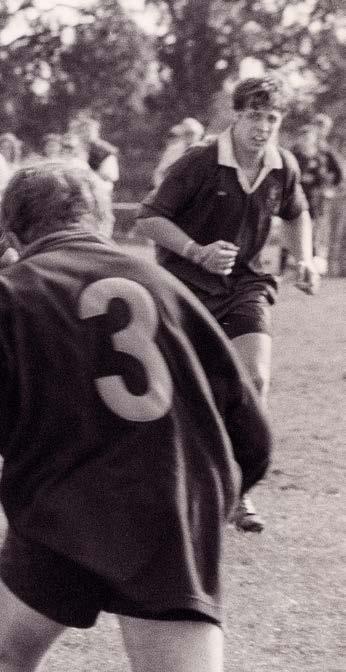

And not just among students. The late Governor of Victoria, the Revd Dr Davis McCaughey, recounted arriving in Melbourne in 1953 with his large family to take up residence in the grounds of Ormond, during Ron Cowan’s wardenship of Trinity. He recalled ‘the warmth of welcome and kindliness with which we were greeted by the Cowan family.’ When McCaughey was appointed Master of Ormond six years later, Cowan became his mentor. ‘I knew – and I think other Heads of Colleges knew – that I had only to pick up the telephone to ask his advice and be given wise if sometimes disconcerting counsel.’
All the same, the sports field has remained the field of battle. For more than a century, the Fleur de Lys has reported on the intercollegiate sporting results either with enthusiasm or grim determination to settle scores the following year. And the reverse can equally be said on Ormond’s side. In 1990, the captain of Trinity’s All-Stars football team spoke of the match against Ormond, ‘the arch-enemy’. The current Anglican Dean of Melbourne, in his time as College Chaplain, recalls one College alumnus reflecting on the 2010 victory against Ormond in the rugby final as, ‘A clear victory of Anglicanism over the scheming Calvinists!’ While in 2014, having narrowly beaten St Hilda’s in Women’s AFL, Ormond looked ahead to
Sports-field determination has at times spilt across the fences. When Trinity’s seeing-eye dog in training, Urchin, had a chance encounter in 2020 with Master of Ormond College Lara McKay’s own pooch, Reggie, Ormond surmised the two canines were ‘holding peace talks’. They were a year too early. In the dead of night in mid-2021, a group of Ormondians jumped the fence to make off with artist Pamela Irving’s commissioned bronze sculpture, Bulpadock Bull (1993). Given a late-night tour of the University campus, it was subsequently returned home and left, somewhat unceremoniously, next to the hole from which it had been unearthed hours earlier. Was it retaliatory then that, having claimed victory in the rowing in our 150th year, the Trinity crew brazenly marched into Ormond’s Dining Hall unannounced to carry away the Mervyn Bourne Higgins trophy to its rightful side of the fence before the official handover took place?
In spite of it all, Davis McCaughey said it best when he reflected that the ‘Colleges of the University have been strong when they have stood together. They have been happy when, inside the healthy rivalry, they have helped each other.’
One thing remains certain: After 150 years of friendly competitiveness, the gauntlet has been thrown down.
SPORT ● 27 TRINITY TODAY
PHOTOS: TRINITY COLLEGE ARCHIVES, SOPHIA GAWAN-TAYLOR
TIGER Woo!
From early morning training sessions to the victorious thump of spoons on wooden tables, sport has played an integral role in the lives of many Trinitarians.
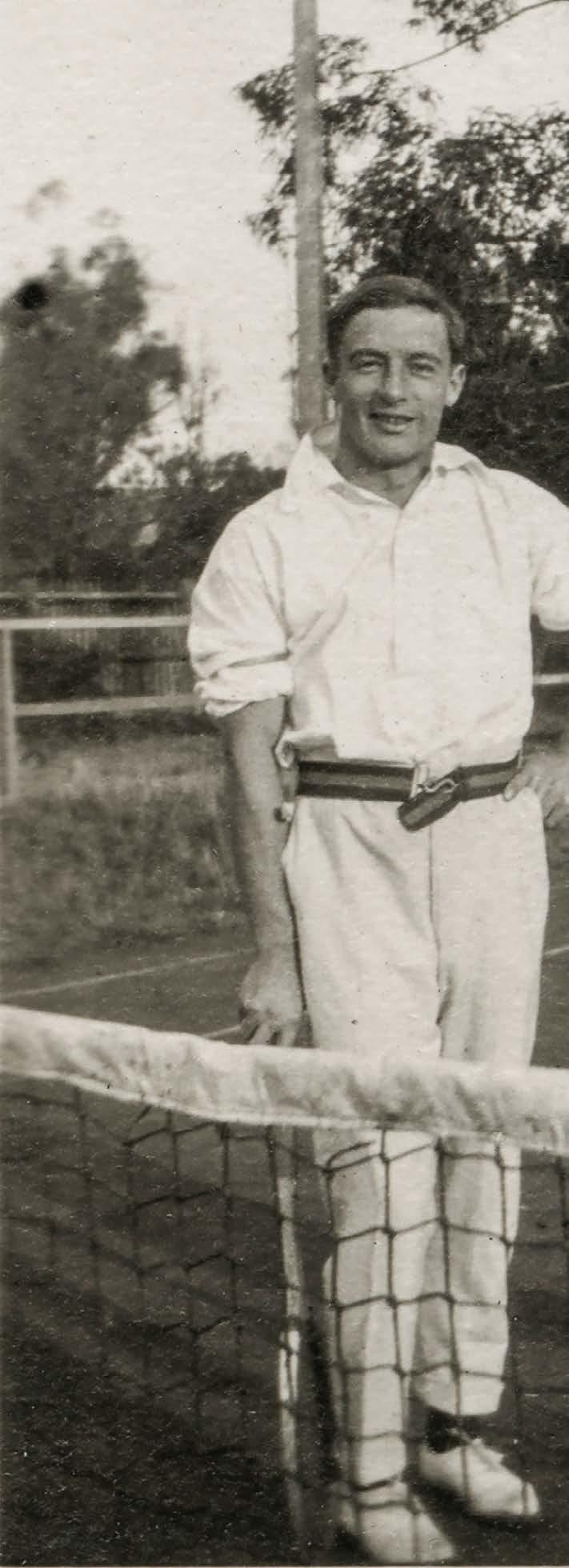
It doesn’t matter if you’re a champion athlete or the type who works out rules on the fly, there’s a place for everyone on the Trinity team.
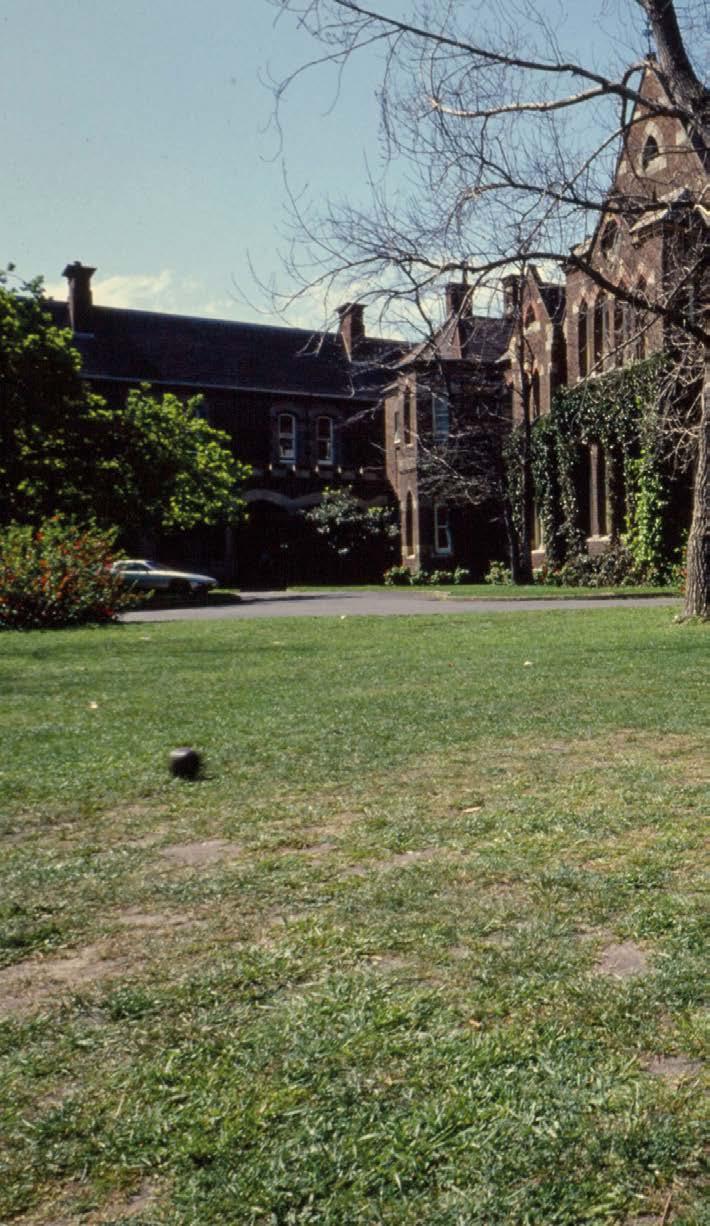
TRINITY TODAY ● 28 SPORT
Students playing lawn bowls on the ‘bowling green’, at the northern end of the Bulpadock in the 1980s.
A couple of Trinity students formed part of the University rowing crew that competed at the Australian University Championship’s Oxford and Cambridge Cup held in Penrith, NSW, in 1933.

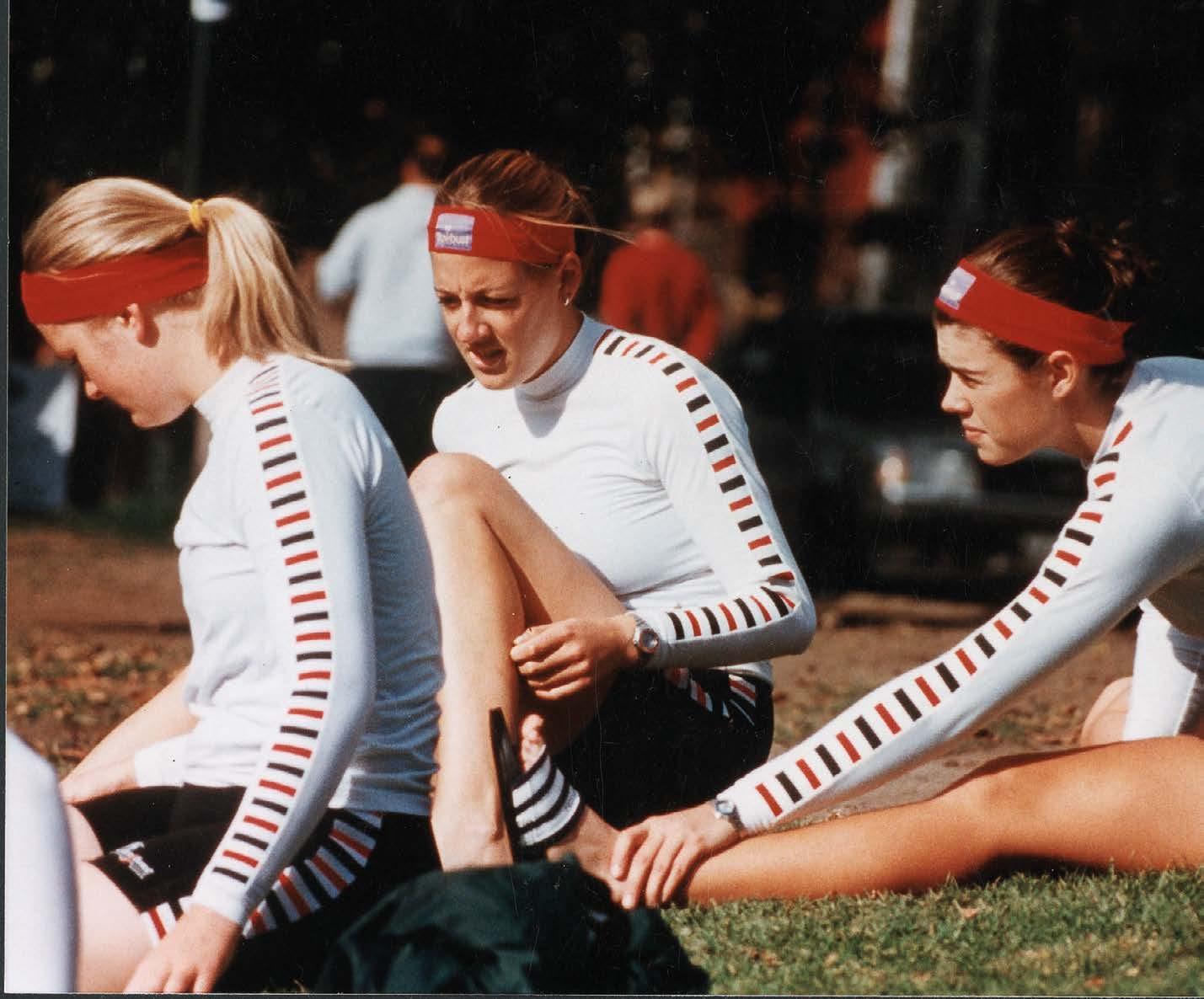
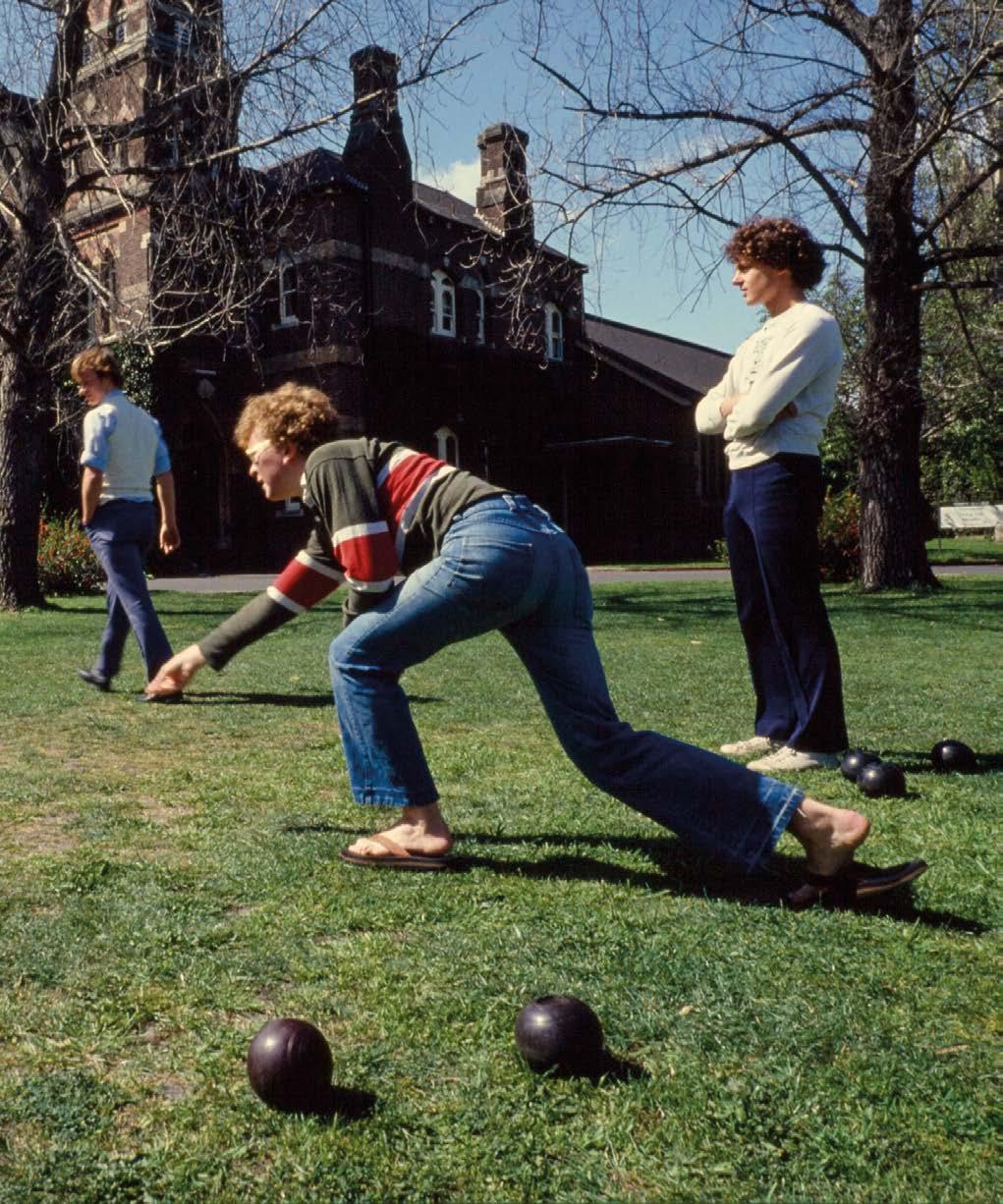

Two College ‘gentlemen’ pose for the camera on the old tennis court along Tin Alley, c. 1920.
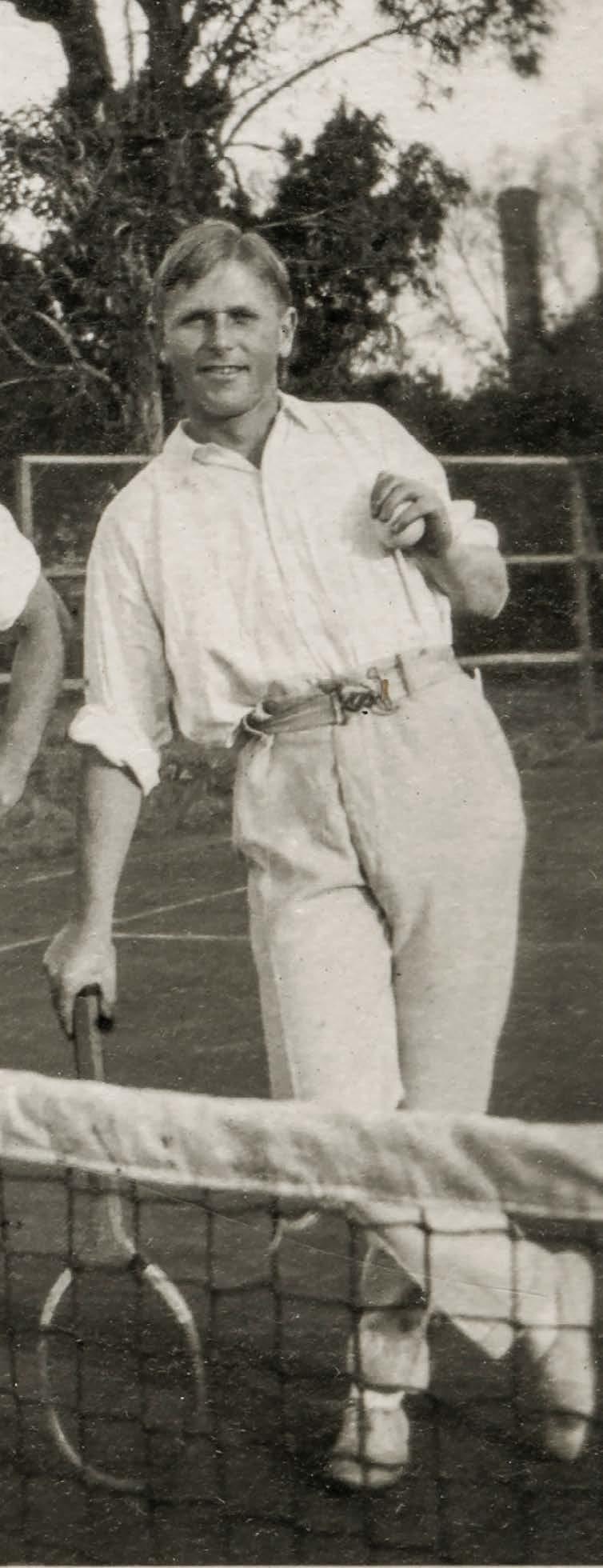
SPORT ● 29 TRINITY TODAY
Alex Dean (TC 2019) takes to the field during the women’s cricket match against Newman College in 2020.
Trinity oarswomen stretching on the banks of the Yarra River in 1999.
TIGER Woo!

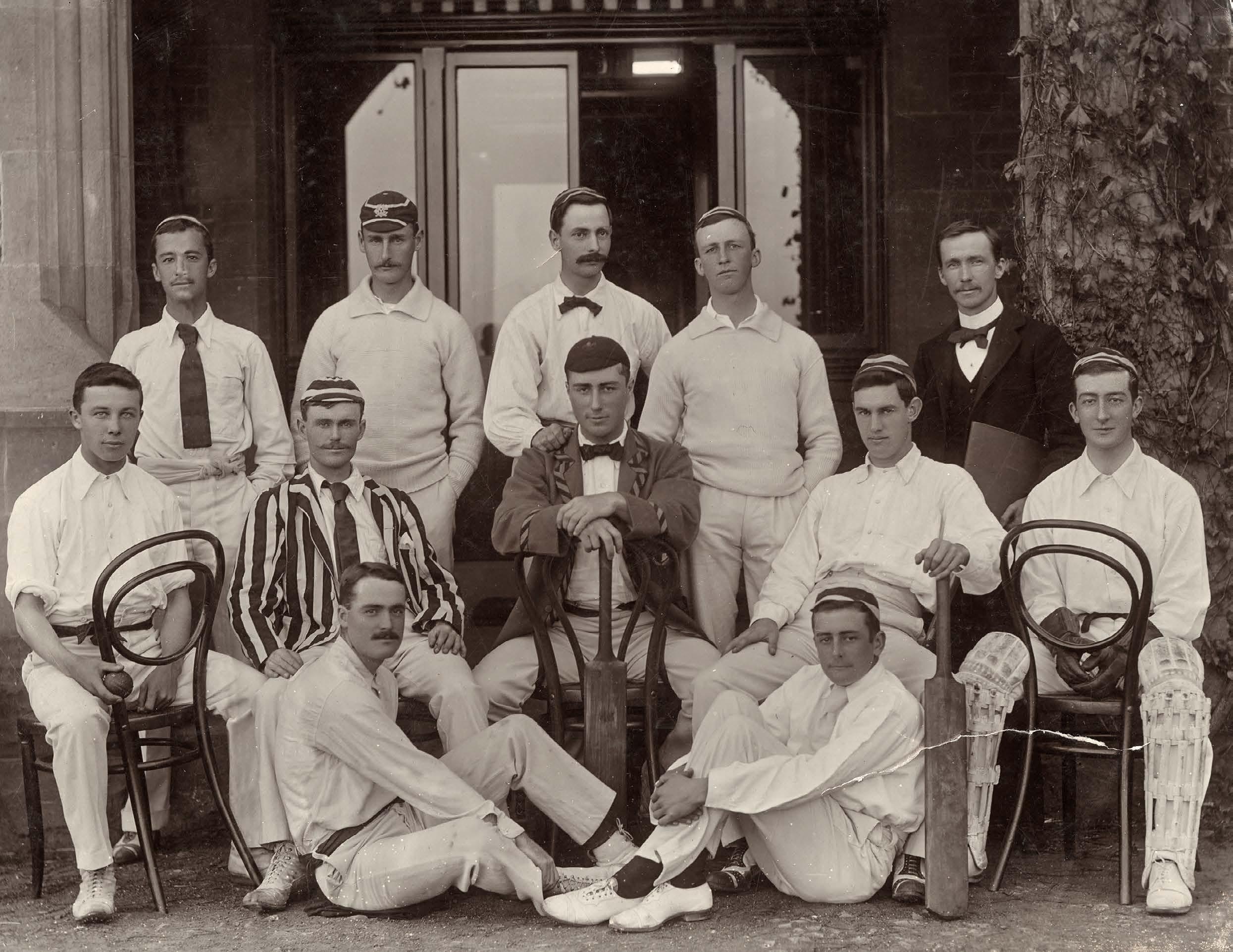
Jack
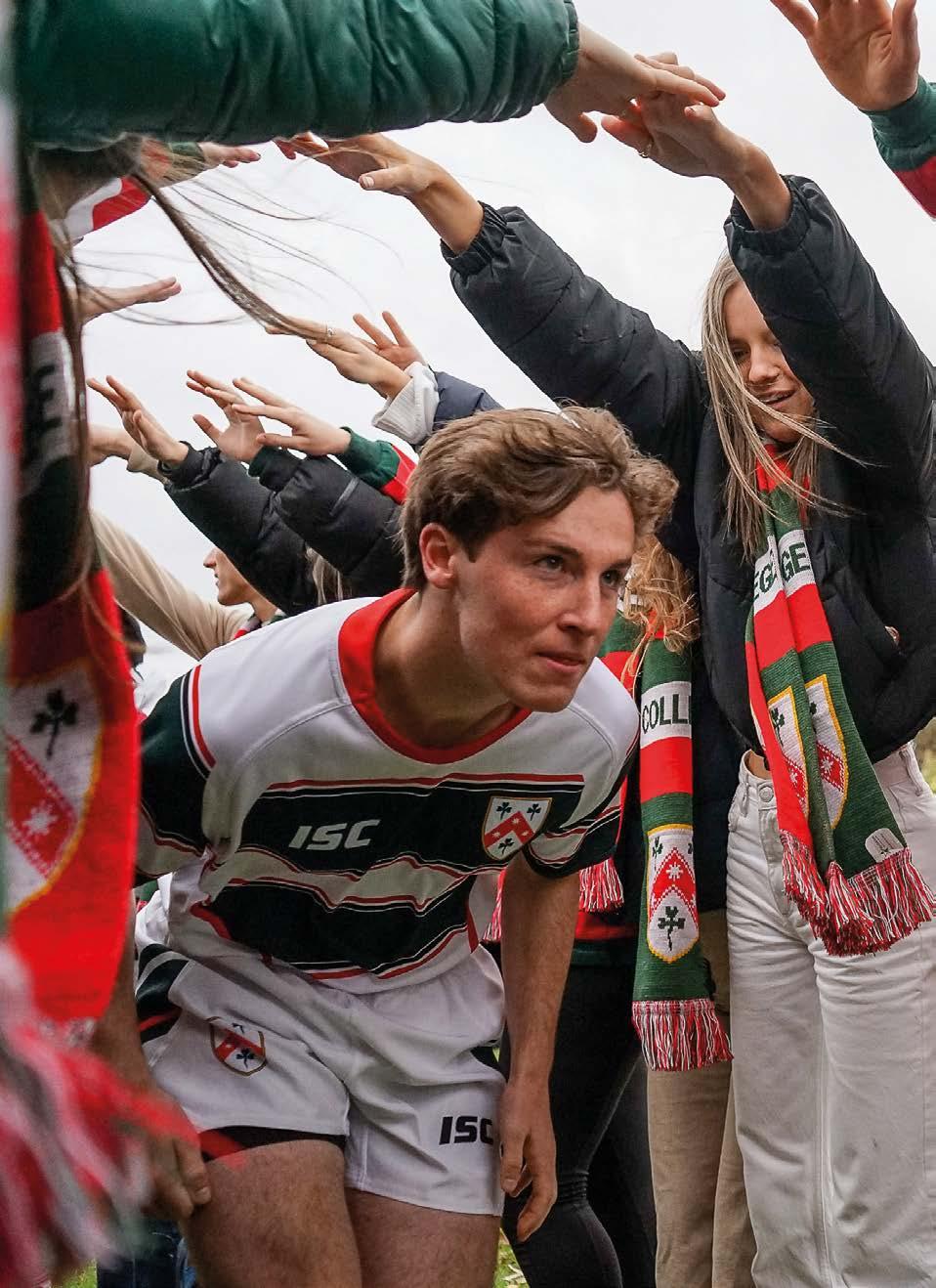
TRINITY TODAY ● 30 SPORT
The Trinity College cricket team in front of the Clarke Buildings in 1897.
PHOTOS: TRINITY COLLEGE ARCHIVES
Reddrop (TC 2021) crouches to pass through a tunnel of supporters’ arms before Trinity’s victorious men’s rugby match against Ormond in 2021.
The winning women’s first eight rowing crew in 1983.


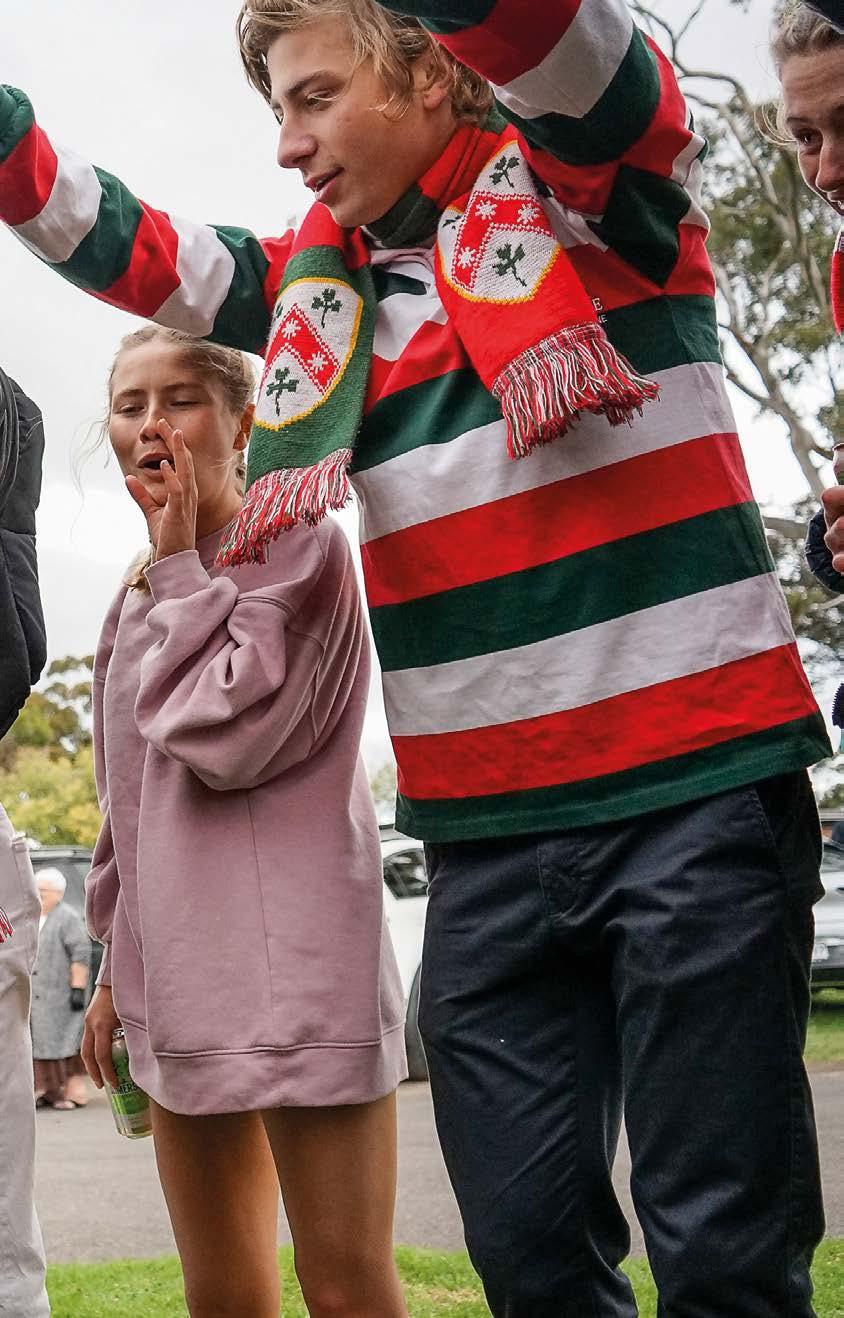
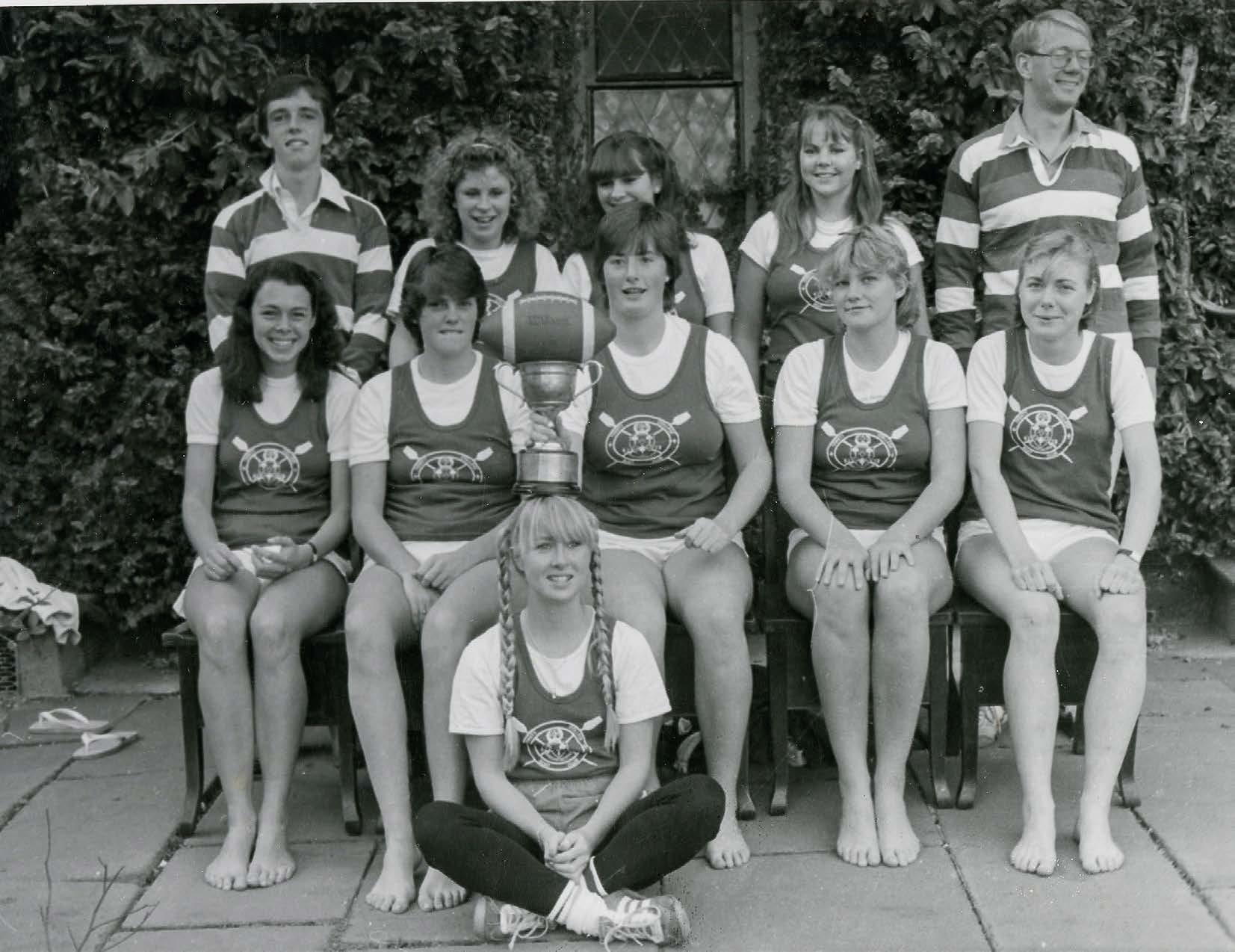
Queen’s was seen as the greatest threat, but Trinity ended up going head to head with Ormond to take victory.
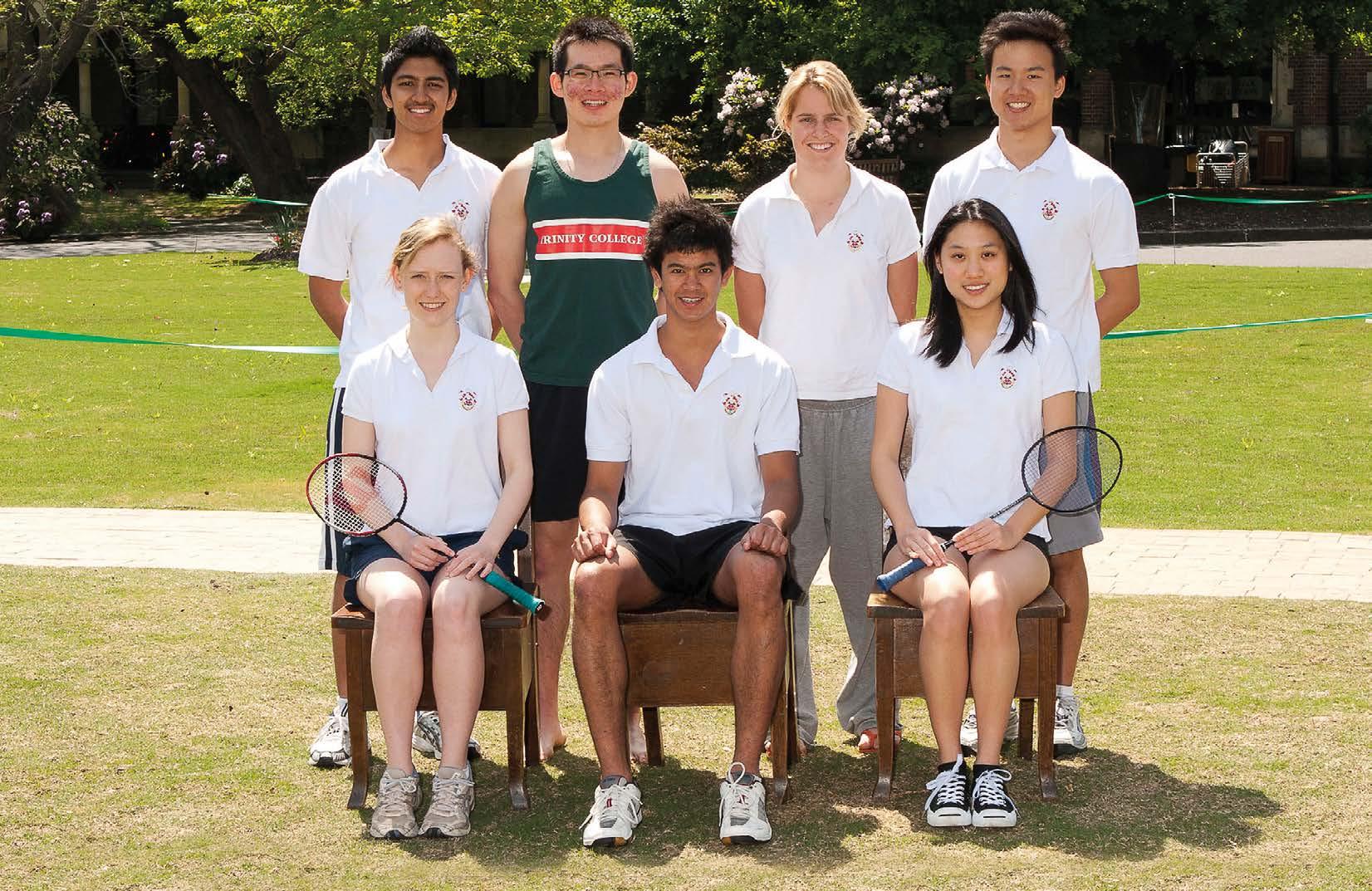
Members
BACK: Nash Atchu (TC 2010), Victor So (TC 2008), Claire Sutterby (TC 2010), Dannel Yeo (TC 2009).
FRONT: Caroline McBride (TC 2010), Chris Kelly (Captain) (TC 2008), Su Yin Lai (TC 2010).
SPORT ● 31 TRINITY TODAY
of the Trinity badminton team.
The Trinity College rifle team in 1909. The team won the first intercollegiate contest held at the Williamstown rifle butts in September. All five members would subsequently serve in World War I – two of them were killed in the conflict.
The men’s football team celebrate their drought-breaking premiership win in the Dining Hall in 1994. Gill McLachlan is on the far right.
Gillon McLachlan (TC

1994)
“College sport and sport in general has a huge impact while you are at university as it builds friendships, networks, resilience and discipline. It also requires teamwork, and this provides the framework you need to advance professionally.
Sport was an important part of my College experience – I played cricket and football at Trinity. One great memory is winning the intercollegiate Firsts Football final in 1994, the first time Trinity had won it since the 1960s. It was a special day as I remember we won by only a goal. Of course, winning was great. But when I look back, I was playing with many teammates who would turn out to be lifelong friends; on reflection, that’s even more special than the match itself.
Though I loved my sport at College, when it comes to my career, I stumbled into it. I was working as a management consultant when I was offered a job at the AFL and went as a secondee. I could never have imagined the career I would have or the change I would see during my time there.
The AFL is a completely different competition to what it was when I was a student at Trinity. It’s now a national game with world-class stadiums. It’s fully professional for men, and, importantly, now has a women’s league that sees 540 women playing. It’s a leader in the community on many issues such as racism, gender and sexuality. It’s an organisation that I hope represents everyone.
There have been plenty of highs throughout my time at the AFL – I’ve loved the responsibility and the privilege of leading a game that means so much to so many, whether that’s at the national, state or college level. Sport really can strengthen and unite us.
the
TRINITY TODAY OAKLEAF AWARDEE
GILLON McLACHLAN is the outgoing CEO of the Australian Football League. He has worked for the AFL since 2000, initially as a consultant in strategic planning, then General Manager of Commercial Operations, Chief Operating Officer and Deputy Chief Executive Officer, before being appointed as Chief Executive Officer in 2014. Key outcomes in Gillon’s roles within the AFL have included the largest sports rights media deal in Australian history, the establishment of AFL Media, and the establishment of two new clubs, including raising
funding for and building their stadiums. Gillon has a Bachelor of Laws from Melbourne University, a Bachelor of Commerce from Adelaide University and completed the Senior Executive Program at Stanford University.
PHOTO: SUPPLIED
Congratulations to Gillon for being named our 2022 Bill Cowan Alum of the Year for his work expanding the AFLW and ensuring AFL games continued during the pandemic.
CELEBRATING 150 YEARS OF LEADERSHIP

● 33 TRINITY TODAY
Iwonder how many sausages I would have to stack, one on top of the other, to reach the moon?
mused a six-year-old Andrew Prentice as he watched his mother put away a string of sausages from the butcher. He had always been intrigued by how far away the moon was but struggled to find the right metric to quantify it.
While some children would have briefly stared at the sky before shifting their attention to dinosaurs or the ocean or volcanoes, Andrew’s fascination with the night sky never dissipated. And he got quite good at measuring things.
Andrew is sharing these childhood memories from his home office, where books and papers are stacked high in front of framed pictures of Jupiter and Saturn. He picks up one of the books on his desk and opens it to reveal neat lines of mathematical formulae in blue, red and black ink. Some are highlighted, some are tabbed with coloured sticky notes.
He then holds up a series of loose papers scrawled with the thoughts and ideas that were too impatient to make it into a notebook. ‘Now, the disadvantage of this is that I’ve got several of these scratch pads and pages fall out,’ he says, catching a loose page that slips onto his desk. As he shuffles the papers into a more orderly pile, he adds, ‘I do find that, to be successful, you really have to be quite disciplined in keeping track of things.’
BY EMILY M c AULIFFE
studied mathematics and physics as an undergraduate. After completing a Master of Science and winning a Royal Commission for the Exhibition of 1851 science research scholarship, he travelled to Oxford in 1967 to study for a Doctor of Philosophy in theoretical physics under the supervision of Dirk ter Haar, a well-known Dutch theoretical physicist.
Ter Haar encouraged Andrew to investigate a theory developed by French scientist Pierre-Simon Laplace about how the solar system had formed that had lain discredited and discarded for 200-odd years. ‘Laplace obviously didn’t have access to computers and what we have now,’ says Andrew, ‘so I wanted to reawaken Laplace’s model and see if it
could be brought back to life, and to see if the objections that were cast on it could be overcome.’
After Oxford, Andrew took up a postdoctoral position at the Carnegie Mellon University in Pittsburgh, where he had access to the fastest computer in the United States – the ‘UNIVAC’. It was about 3 o’clock one morning, after successfully running his computer code for the first time, that Andrew had an ‘aha’ moment, discovering that the physical concept of supersonic turbulence, which he and ter Haar had devised in Oxford, could overcome all the objections that had been thrown at Laplace. The discovery led to Andrew’s development of the ‘modern Laplacian theory’ of solar system formation, with which he could explain the emergence of all the planets and their properties. It sounds impressive, and it was, yet the underpinning premise of supersonic turbulence was written off as farcical by Andrew’s contemporaries.
As a young man, just shy of 30, with ‘much more energy and bright red hair’, Andrew pressed for his findings to be reported, submitting to, and being rejected by, many academic journals. ‘I had one dickens of a problem getting my paper published,’ he says with a chuckle, now having the benefit of knowing how the story ends. He realised that the only way he would ever be able to convince other theoreticians that he was
MERCURY RISING

‘pushing the right wheelbarrow’
Mathematician Dr Andrew Prentice (TC 1962) is considered a world leader when it comes to explaining the formation of the solar system, though, as Andrew found out the hard way, when your ideas are bold and your calculations sharp, it can be hard to be taken seriously.
TRINITY TODAY ● 34 LEADERSHIP
though he had his sceptics, his theory drew curiosity. Throughout the 1980s, he was subsequently able to predict and confirm various features of the moons of Jupiter and Saturn and new families of moons around Uranus and Neptune.
In 1989, Nature magazine published an article about him, citing a quandary. Andrew surmises the article as: ‘Here’s this guy, Prentice. We don’t want to describe him as a maverick, but he’s got this theory, which we all regard as suss. However, how is it that he’s been able to make these successful predictions based on it?’
The simple answer is, Andrew was on the money. Gradually, the opinion of his theory shifted from ludicrous to luminary, and Andrew is now considered one of the world’s leading experts on the formation of the solar system.
After 40 years as a reader in applied mathematics, Andrew retired in late 2010. At the time, his department at Monash was being restructured, his grandchildren were arriving, and he ‘didn’t want to hang around the maths department like a bad smell’. Although he had officially packed up from the maths department, he became an affiliate of Monash’s School of Physics and Astronomy and an adjunct professor at the University of Southern Queensland. Ever humble, he’s thankful to still be able to use the university’s specialised computers.
Despite Andrew’s pioneering research and many decades in the university sector, he notes that he never became a full professor. This is largely because, as a self-confessed single-task person (‘just ask my wife’), Andrew’s research took a back seat when he began teaching, largely because he discovered he was very good at it. How many lecturers can claim a Facebook group titled ‘[Insert teacher name] Appreciation Society’, managed and joined by throngs of adoring students? And how many can top that with a Vice-Chancellor’s award for teaching excellence?

Though Andrew tells tales of awkward teenage years, when he realised that
being able to recite the value of pi to 20 decimal places was not sufficient to win over a girlfriend, he is a skilled and good-humoured communicator, known for in-lecture commentary like, ‘Now I’m going to take the delta x outside – not outside the lecture theatre, just outside the brackets’, and ‘I’d better shut the door – we’ll get distracted if an emu walks by’, as catalogued among his most memorable quips, or ‘Prenticisms’, noted by his students on Facebook. While humour was part of his secret sauce in the classroom, Andrew also put great emphasis on ensuring his students felt cared for. ‘I find that it does mean a lot if someone takes a personal interest in you or cares about you … My primary motivation is the welfare of other people.’
As well as supporting his students on a personal level, Andrew began donating to scholarships to help financially disadvantaged students as soon as he was able to do so, noting that he himself
received several scholarships, including one from Trinity College.
As both a student and teacher, Andrew came to understand the importance of giving students the opportunity to study without significant financial burden and with adequate support. He credits Trinity’s scholastic environment for allowing him to flourish in his formative years, and recognises that today’s youth have many modern stressors to deal with, including climate change and technology (which didn’t bother Isaac Newton, he notes).
‘Whenever I’m feeling emotionally well, I perform so much better … You can’t do that if you have financial worries and things like that.’
In addition to donating to scholarships, Andrew also supports several other causes and institutions, including Trinity’s Theological School. Though some may wonder whether evolutionary science and religious faith are contradictory, from Andrew’s point of view, they complement each other nicely. ‘Coming from a religious background, there are so many hymns that talk about the starry heavens and the planets and the sun and the moon. It all seemed to fit together to me.’ Andrew says his faith also helped him push through the many rejections that tested him early in his career. ‘My Christian background really has stood me through some pretty difficult times … I found that having faith really does give you a basis for trying to make sense of everything.’
Despite his distinguished career to date, Andrew is still on a quest to make sense of certain things. While some may take to sudoku and crosswords in their older years to keep the synapses firing, Andrew, now 79, is revisiting his reports and calculations on Mercury, because ‘I haven’t focused on Mercury for a while,’ he says, patting a thick book next to him.
‘I have been fortunate with my research work and the music hasn’t stopped – I mean, the big lady hasn’t sat down – but I’m pretty certain that what I have done will endure and I just have to hang in a bit longer.’
Mercury, it’s your time to shine.
LEADERSHIP ● 35 TRINITY TODAY
‘I have been fortunate with my research work and the music hasn’t stopped – I mean, the big lady hasn’t sat down – but I’m pretty certain that what I have done will endure and I just have to hang in a bit longer.’
PHOTO: STEVE MORTON
On being ‘education people’
Dr Denis White served as Executive Director of Trinity College’s Foundation Studies program from 1991 to 1998, during the program’s foundational years. Denis’s vision for the program and thoughtful leadership played an integral role in setting our Pathways School up for the success it has enjoyed for the past 30 years. Here, we share Denis’s forward-thinking process and leadership philosophy when he took on the directorship.
 BY EMILY M c AULIFFE
BY EMILY M c AULIFFE
TRINITY TODAY ● 36 LEADERSHIP
PHOTOS:
KIT HASELDEN PHOTOGRAPHY
Denis White took up the position of Executive Director on 1 January 1991, having been told that there were 70 overseas students lined up to start Trinity’s new foundation program in February. When he studied the offers that had been made, however, he discovered that there were only 35 actual acceptances, and that all the other offers were dead in the water. ‘This was a nightmare discovery,’ he says.
To boost enrolments at the eleventh hour, Denis joined the Careers Exhibition in Singapore. He sat in the Trinity booth from 10am to 8pm for four days, while 250,000 people passed through the exhibition. He noticed that all the other exhibitors had seemingly endless boxes of brochures to give away.
‘We only had 20 brochures in total, so our prospects did not look good,’ says Denis. ‘But early on the second day, I made eye contact with a man who was looking towards our booth. He came over and said, with some acerbity, “They are just used car salesmen.” I must have looked startled, because he waved at the nearby booths and said: “Look at them, they look like used car salesmen.” I must have still looked startled, because he then said, “You are different, you look like an education person.” I sensed this recognition signalled a turning point in our fortunes.’ (The man’s daughter, Yu Lin, did indeed enrol, and went on to live at Trinity College as a resident. Then, the man himself, Anthony Cheong, and his wife, Isabel, became great supporters of the College and are both Oakleaf recipients for their services to philanthropy.)
Denis says that he has always felt that being seen as ‘education people’ was the key to Trinity’s success. On top of that, he had the advantage of being a university academic, as well as a keen reader of Asian literature, philosophy and politics. Being the former director of the prime minister’s private office in the early 1980s, and having been present at many of Malcolm Fraser’s meetings with the heads of government from countries including China, India and Malaysia, certainly helped too.

‘My familiarity with Asian cultures
helped me recognise the style of program that we would need to appeal to and develop young international students coming to Australia with aspirations of studying at the University of Melbourne.’

Denis firstly noted that a disciplinebased curriculum (including subjects like Accounting, Mathematics and Chemistry) was going to be important to the success of Trinity’s foundation program. ‘I regarded this as essential for Asian students who had, by their own admission, been brought up on rote learning,’ he says.
‘I also understood that international students generally want to move fast, so we developed accelerated programs for students who could make it to Melbourne University faster. We then devised extended programs for students who could make it to Melbourne if given some extra teaching, and offered a range of starting dates and mid-year intakes to fit in with overseas education timetables.’
‘The self-confidence of the Foundation Studies students received its finest expression in a valedictory speech when one of the student speakers said: “We are the future leaders of Asia. But we are also the black sheep of Asia, because Trinity has taught us to think for ourselves”,’ remembers Denis.
A lot of it was about identifying what Trinity’s target market both wanted and needed, then moulding a program to suit.
However, Denis knew Trinity couldn’t operate in isolation. He understood that building a strong relationship with the University of Melbourne would be integral to the program’s success. ‘I put a prodigious amount of time into this relationship and ensured we provided the type of students that the University wanted,’ says Denis. ‘We matched our supply with their demand. And while students may have come to Trinity because it gave access to Melbourne University, few of these students would have made it to Melbourne without going through Trinity.’
At its simplest, Denis says that much of the program’s success came from having a clear focus. ‘Our job was to enable our students to get into the University of Melbourne. I blocked ideas that did not contribute to this objective; this streamlined many things and saved a lot of money.’
But then there were some things that the students didn’t necessarily know they would need to succeed in the Western tertiary and corporate environments – like the skills and confidence to speak up, share their opinions, and challenge the ideas of others, including their teachers (something many would never have dared do in their home country). This is where somewhat left-of-field subjects like Drama and the History of Ideas came in. They helped students look inward to find their confidence, then outward to engage with the people and world around them.
Throughout Denis’s tenure, student numbers jumped from 53 to 560, but he is quick to point out that he can’t take all the credit. ‘One of the greatest strengths I had as Executive Director was a superb board of management. This board, long since abandoned, was head and shoulders above any other board I have known or heard of.’
And, because of them, Denis can look back on those early years with fondness and gratitude. It’s proof that being a great leader is one thing, but being part of a great team is really something else.
Dr Denis White’s book The University Dream: Creating Trinity Foundation Studies can be purchased from the Trinity College shop: shop.trinity.unimelb.edu.au
LEADERSHIP ● 37 TRINITY TODAY
Isabel and Anthony Cheong have been strong supporters of Trinity College since Anthony met Denis White at an exhibition in Singapore in 1991.
Taking a holistic view

TRINITY TODAY ● 38 LEADERSHIP
It started more than 15 decades ago when Bishop Perry, William Torrance and Trinity’s first Principal and Warden, Alexander Leeper, had a vision for an Australian college – an antipodean interpretation of the residential colleges of their youth at Cambridge, Oxford and Dublin. They wanted to create an academically minded institution that offered a well-rounded education, not just in the classroom but in life – a ‘large and liberal’ education, as they called it.

It was on this basis that Trinity College – Australia’s second university college, and the first in Melbourne –welcomed its first student, Jack Stretch, in July 1872. Stretch, and the many thousands of men and women who followed him, benefited from this large and liberal education in life.

But what exactly is this ‘well-rounded education’ that we have fixated on for more than a century and a half?
In some ways it’s tangible – it’s the tutorials, the wellness programs, the extracurricular activities and the comfort of shared meals. It’s a bed to sleep in and the convenience of having classes close to home.
It also means being a part of an institution that values scholarship and academic success, that acknowledges our debt to Australia’s First Nations people and endorses the Uluru Statement from the Heart, that works to extend to more members of our society the kinds of opportunities that many of us, and our children, have had, and that respects tradition yet evolves to meet contemporary demands.
The real power, however, comes from having a group of intelligent young people share the same space during a formative period in their lives. Trinity alumni, including me, frequently speak of how the College changed our lives, by setting us on a path that inspired,
challenged and nurtured our goals. It opened our minds to new possibilities and showed us the value of community.
How does Trinity achieve this? Once these students get together, interesting things start to happen. The person who grew up in inner Melbourne learns about the life of the person who grew up on a farm in Western Australia. The student from regional NSW learns about the culture of an Indigenous student who grew up on country. Through Dining Hall chatter, the science student learns about the arts, and the literature student learns about economics. The theology student learns about the journey of an ordained alum, and the Foundation Studies student grows in confidence as they navigate a new culture with new friends. Almost all try something they haven’t done before, whether it be drama, a sport or a musical pursuit.
Conversations about politics, climate change, gender equality and First Nations rights buzz across campus –perhaps inspired by a fireside chat with an alumnus, like that of Professor David Tan (TC 1991), who this year talked about the complexities of copyright in the Metaverse; or upon learning that in 1877 the first debate of our Dialectic Society was on women’s rights; or by the portraits of prominent leaders that feature around the College, such as that of the first woman to be installed as an archbishop in the Anglican Church of Australia, the Most Revd Kay Goldsworthy AM (TCTS 1981), and anthropologist and advocate of Aboriginal issues Professor Marcia Langton AM.
It’s through these conversations that beliefs are challenged, bonds formed and ideas brewed, and, in turn, confident, compassionate and wellrounded leaders are born. And that’s what offering a holistic education is all about.
LEADERSHIP ● 39 TRINITY TODAY
From its earliest days, Trinity College has aimed to offer students a wellrounded education. Warden and CEO Ken Hinchcliff (TC 1976) explains what this means and the impact it has on our future leaders.
JEROME CUBILLO is an Indigenous man of Larrakia and Wadjigan
He grew up in Darwin and spent many school holidays camping at
Jerome
Cubillo (TC 2009)
“
Living at Trinity College definitely contributed to the development of my leadership skills.
It was amazing to be surrounded by people from all walks of life and to learn about their cultures and religious beliefs. The experience opened my mind and taught me to be inclusive and conscious of people’s different journeys.
In 2011, I was Trinity’s Community Rep, and being on the TCAC taught me how to lead and set a vision, but also assign ownership to others and trust them to fulfil their roles. I now use those same skills as Chair of the Larrakia Nation Aboriginal Corporation, where I determine the vision of the organisation, then empower others to help us achieve our goals.
At Trinity, I was also part of the team selected to hike the Kokoda Track in 2011, which turned out to be one of the most challenging and rewarding experiences of my life. In the same year, I was part of a group that went on a cultural immersion trip to the remote Minyerri community in the Northern Territory. Being able to travel to the NT with a group of Trinitarians and host them on my traditional land (Larrakia and Wadjigan country) was incredible and seeing other students engaging with my community made me especially proud of my culture.
Looking back, all those experiences played a part in building my confidence and shaping my leadership style, and helped me work out who I wanted to be and what I wanted to achieve. Though I haven’t always seen myself as a leader, I have always strived to lead by example and hope that what I’m doing is impactful, supports my community and inspires others. I want people to be part of the journey I’m on and to see themselves as part of the change I want to make.
and Ngaragi
his elders and siblings. Jerome is now Chair of the Larrakia Nation Aboriginal Corporation, a community service organisation and one of the largest private sector employers of Aboriginal people in Darwin. Jerome is also the CEO of the Northern Territory Indigenous Business Network, a member-based association that represents and advocates for Aboriginal businesses to unlock and grow Aboriginal people’s economic independence. You may also recognise Jerome as runner-up of the 2019 season of The Amazing
Wadjigan

TRINITY TODAY ● 40 OAKLEAF AWARDEE
(Northern Territory)
(Torres Strait Islands) descent.
Bulgul on
country with
Race, in which he participated with wife Jasmin Onus.
PHOTO: KIT HASELDEN PHOTOGRAPHY
150

OF FAITH
YEARS
● 41 TRINITY TODAY
Expressing Anglican identity

Over the past 50 years, there has been a decline in the proportion of Australians who report an affiliation with Christianity. Census data released in 2021 showed that the number of people identifying as Christian decreased by more than 1 million compared with 2016 data, though it is still Australia’s most common religion.
This sharp drop is disappointing, of course, but not a crisis. Those who have stopped identifying as Christian are mostly people who had only a cultural connection with the church, which they have now lost.
For those who want to explore, deepen or reinvigorate their faith within a supported academic setting, whether they identify as Christian or not, I’m thankful they can turn to institutions like the Trinity College Theological School, where diversity is celebrated, and engaged and research-active teachers ensure theological concepts are examined with academic rigour.
The variety of perspectives these students and teachers bring reflects the breadth and diversity of our church, and, to me, a commitment to social justice, critical thinking, access and equality. (It is notable that Trinity’s students are split almost 50/50 between women and men, and many women have gone on to be ordained.) This is a true expression of the Anglican faith and should be found in any college or school that identifies as Anglican.
TRINITY TODAY ● 42 FAITH
Looking back, I know that the Rt Revd Charles Perry – founder of Trinity College and the first Anglican Bishop of Melbourne – imagined that Trinity would be a Church of England institution that provided religious instruction to university students. It’s only natural that this model has evolved over time, and though the late Bishop might not recognise the College in its present form, I think he would be glad to see how Trinity has flourished.
Trinity College has grown, expanded and changed over the years, all in good ways and consistent with its Anglican values and identity. I think Bishop Perry would be pleased that the College has, for example, a Pathways School for international students, which provides a valuable route into the University of Melbourne for many students from overseas. I think Bishop Perry would also be pleased with the increase in numbers at the Residential College and that it has been co-educational since the 1970s. And finally, I believe he would be very supportive of what the Theological School has become, as it continues to serve Anglicans and non-Anglicans, those preparing for ministry, and those who are working to become theologians in their own right across the Diocese of Melbourne, the larger ecclesiastical province of Victoria and beyond. Importantly, these people come from all walks of life and represent all of God’s people. Bishop Perry would surely be happy with that.
FAR LEFT: The Right Revd Charles Perry c. 1857.
RIGHT: The Most Revd Dr Philip Freier.
PHOTOS: BATCHELDER AND O’NEILL, AND SUPPLIED

FAITH ● 43 TRINITY TODAY
Reflecting on the history of the Trinity College Theological School, the Archbishop of Melbourne, the Most Revd Dr Philip Freier, recognises the inevitability of change but the perpetuity of Anglican expression.
matter
BY EMILY M c AULIFFE
During the 19th and early 20th centuries, Anglicanism played a key role in the lives of Trinitarians. A student’s voluntary attendance at the institution signified their commitment to the Anglican faith.
At first, religious service and education at Trinity College was ingrained yet informal. Following an influx of new students in 1883, however, Canon Henry HP Handfield was appointed as the first Chaplain of Trinity College to help guide and develop the collegians’ faith. Primarily, the Chaplain’s role was to offer spiritual instruction to the entire College community and oversee the training of theology students.


It was during Reginald Stephen’s tenure as sub-Warden and resident Chaplain that students procured the first petition to end compulsory Chapel attendance. It was signed by 38 students, but quickly rejected by the Board.
In 1919, the second petition that called to abolish compulsory attendance
at Chapel was put forth to the College executive. The Council at the time consisted of many former students, prompting the Warden to take discussions with the petitioners seriously. This time, the petition was successful, on the grounds that there was a desire among the student body to disassociate the concepts of compulsion and faith, in turn enriching the religious experience for all students. The relaxed stance on Chapel attendance lasted only two years, however, and in 1921 fines were issued to those who did not attend Chapel services.
The Chaplain’s role and influence during these years of flux was often hinged on the student body’s sentiment towards religious education and practice at the time.
A
TRINITY TODAY ● 44 FAITH
The ever-changing role of chaplaincy at Trinity College reflects the dynamism of religious instruction over the past 150 years. We look at the influence of chaplaincy and religious worship throughout Trinity’s history.
RIGHT: The Revd Dr Luke Hopkins, Trinity College Chaplain. BELOW: The Revd Henry HP Handfield, 1862.
PHOTO: KIT HASELDEN PHOTOGRAPHY DRAWING: SAMUEL CALVERT
of faith
One Chaplain who managed to inspire a positive attitude towards religion among the students was Robert Sutton (TC 1913), who was appointed in 1925. His charming and sociable personality, combined with his commitment to raising the standard of worship at Trinity, resulted in a long and fruitful seven-year tenure. It is said that Sutton referred to his on-campus lodgings as ‘the Vatican’. In recognition of Sutton and his achievements, Vatican Lawn remains a popular common space for students, staff and alumni today.
Despite fluctuating attitudes towards religion throughout Trinity’s history, Anglicanism has always been and will continue to be significant to life at Trinity, not only through our Theological School, but also through the values the College upholds.
Chaplains still play an important role at Trinity, providing guidance and counselling to all students, regardless of their faith background – whether it be helping students work through academic or life issues or helping to marshal resources in times of need.
In 2022, we welcomed the Revd Dr Luke Hopkins as College Chaplain. Fr Luke undertook his doctorate at the Trinity College Theological School between 2015 and 2018, and has returned to provide pastoral care to the entire College community.

‘The role of the Chaplain has manifested itself in different ways throughout Trinity’s history, although there are a lot of commonalities. Past Chaplains at Trinity have influenced my own spiritual journey, especially my first parish priest, Fr Roger Sharr, who was a Chaplain at the College during the 1970s. I have seen for myself that supporting and nurturing the spiritual wellbeing of all students has long been a priority at Trinity and is something that drew me back to the College as Chaplain.
‘In 2022, I see my vocation as one that assists the College in continuing to express its Christian identity, as the chaplaincy helps staff and students alike to navigate the highs and lows of university life. Through prayer, academic involvement, pastoral care and coordinating the activities of the Chapel, I also have the privilege of helping to strengthen Trinity’s sense of community and foster our Anglican values with a new generation of students.’
FAITH ● 45 TRINITY TODAY
The Reverend Jenny Inglis

(TCTS 1984)
“
I’ve always been impressed by the faith people invest in ensuring great opportunities for future generations at Trinity College. People’s generosity puts ‘legs’ on that faith – making it possible, tangible.
I’m just one of hundreds who have been fortunate to experience the quality theological education, formation program, observances of liturgy, meaty discussions and fellowship at Trinity’s Theological School that equip our lay and ordained people for the church’s ministry and the wider world.
I’d just completed teacher education studies in Bathurst when I joined the College in 1984. Through my involvement at Bathurst’s Cathedral parish, I sensed women would have so much to offer the church. That’s when I first discerned an opportunity to explore that call and offered myself for whatever might be ahead. Trinity then gave me an opportunity to test and deepen the kind of faith that can adapt within our ever-changing church and society.
My preaching and leading often explores the challenging message of Jesus, especially about women and status-shifting. Sometimes there’s a measure of doubt with faith – grappling with holy scripture and contemporary issues, which needs to be supplemented with respectful and adaptive pastoral care and liturgy.
As a priest I hope to help people from all walks of life on their journeys –whether difficult or joyous – by shining a light on God’s hopes for flourishing. God and the church may seem to have become less relevant for many in Australia, but it’s good to be reminded that we remain relevant to God.
TRINITY TODAY ● 46 OAKLEAF AWARDEE
JENNY INGLIS was ordained deacon in 1987 and priest in 1992 (the first year possible for women in Australia). She has served parishes in the Melbourne and Bathurst Dioceses, and her honorary ministry has included serving as secretary and board member of faith-based groups and committees. She is currently acting Priest-in-Charge in the Anglican Parish of Pascoe Vale/Oak Park.
PHOTO: KIT HASELDEN PHOTOGRAPHY
150 YEARS OF FASHION

● 47 TRINITY TODAY
Trinity On trend
Mullets, shoulder pads, suits on the Bul and knee-high socks at Juttoddie. Trinity has seen its fair share of fashions come and go … and come back again (Mr Mullet, is that you parading around our Dining Hall in 2022?). Here are some of the fashions we rocked and some we’d rather forget.
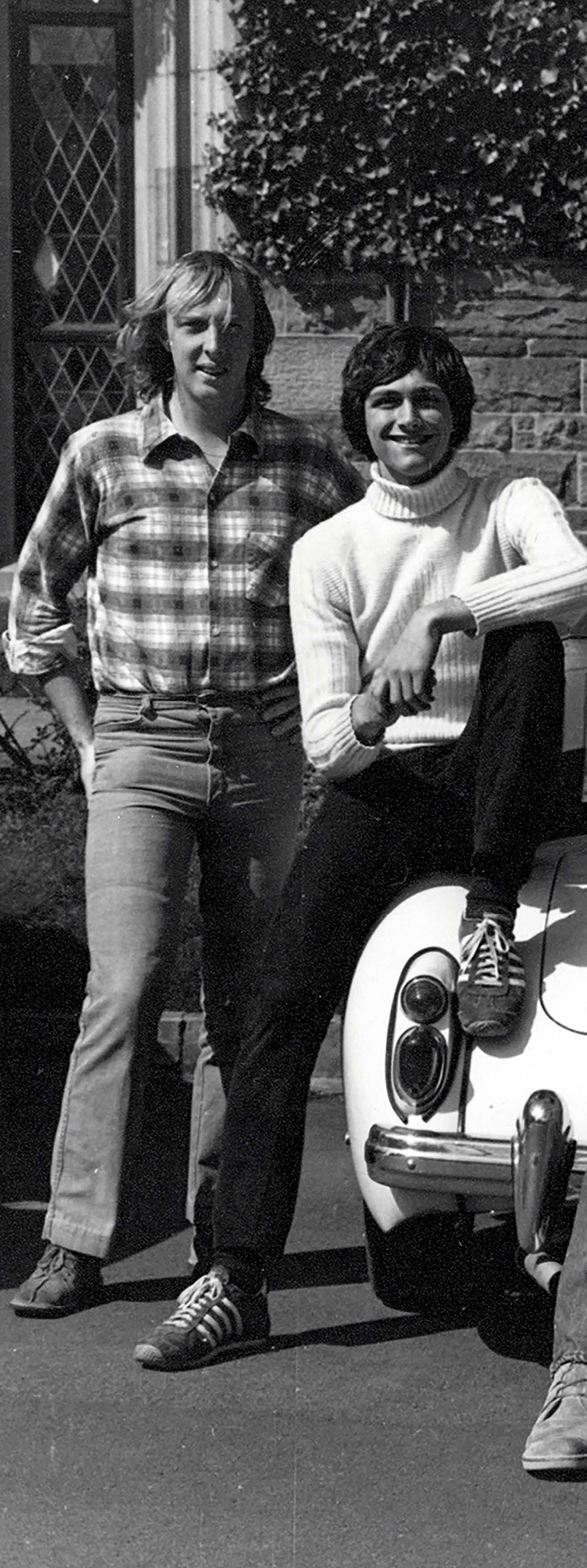

TRINITY TODAY ● 48 FASHION
 In 1980, the men’s basketball team did a great job of accidentally representing all four eras of The Beatles.
In 1980, the men’s basketball team did a great job of accidentally representing all four eras of The Beatles.
● 49 TRINITY TODAY
LEFT: The College jester and fresher outfits burst with colour in 2021.
FASHION
Trinity On trend
Short dresses and knee-high socks or boots were flavour of the day at Juttoddie in 1968.
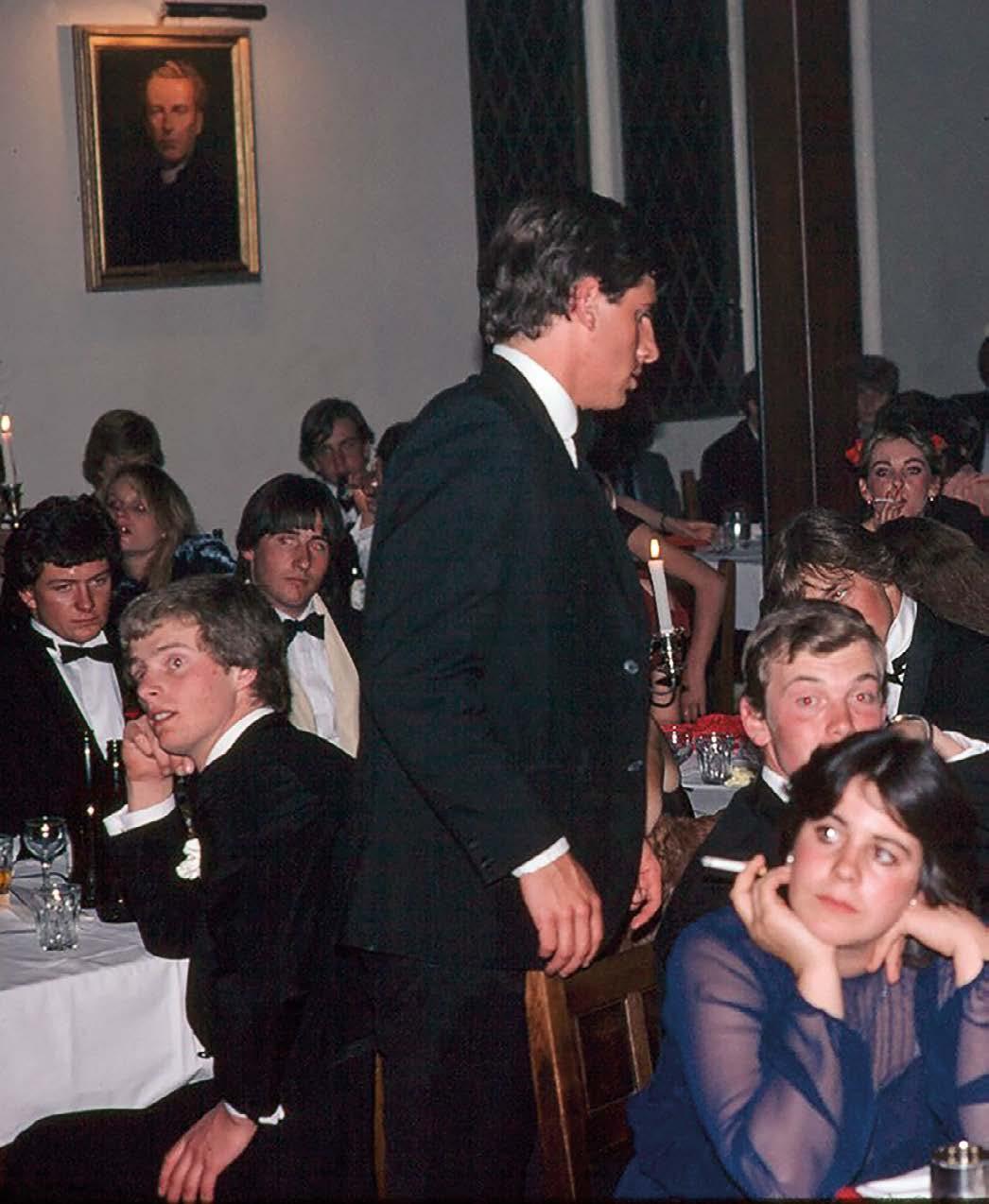

1978: vests, oversized jumpers and the fluffier the hair, the better.
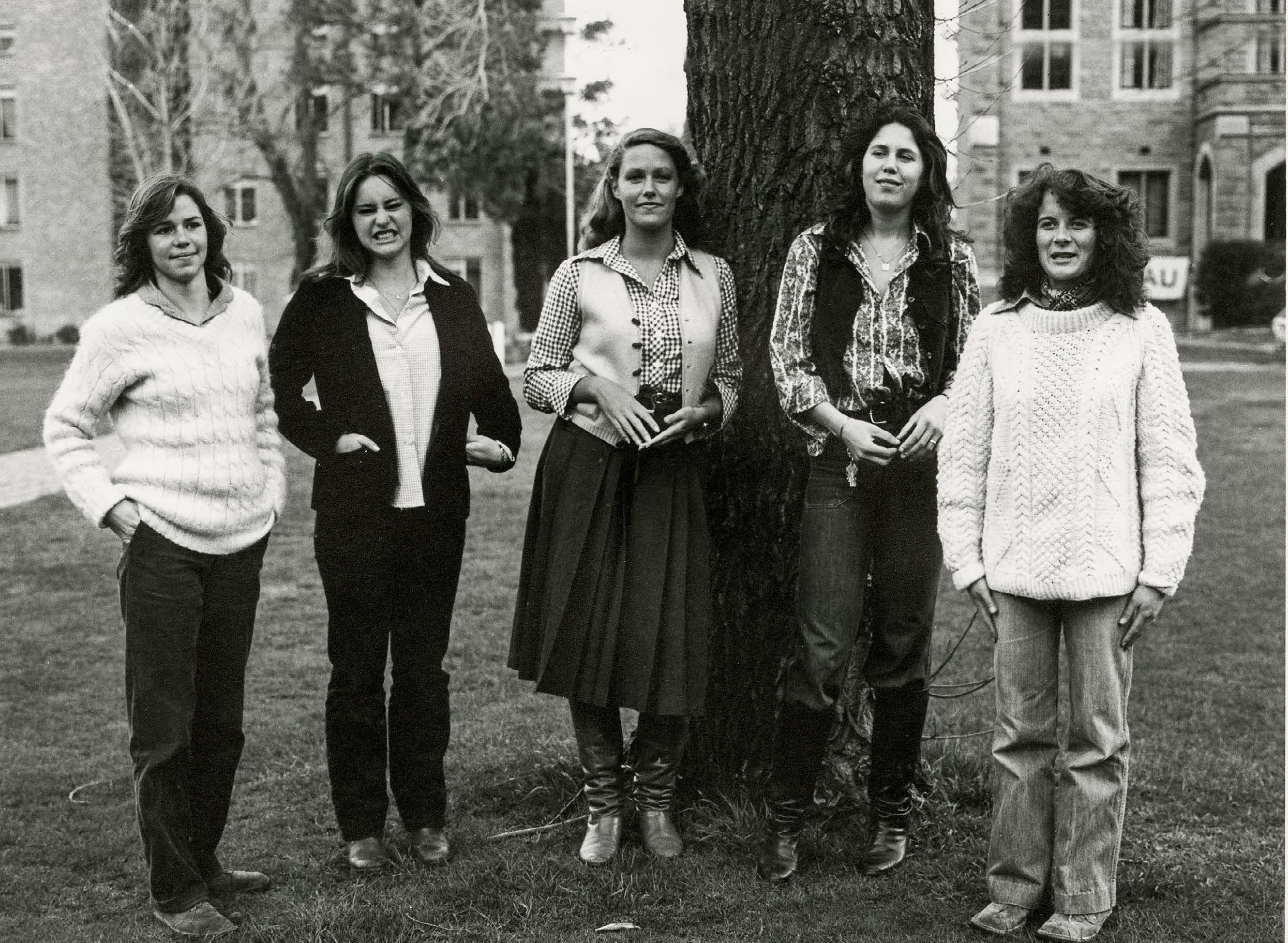
TRINITY TODAY ● 50 FASHION
1920:

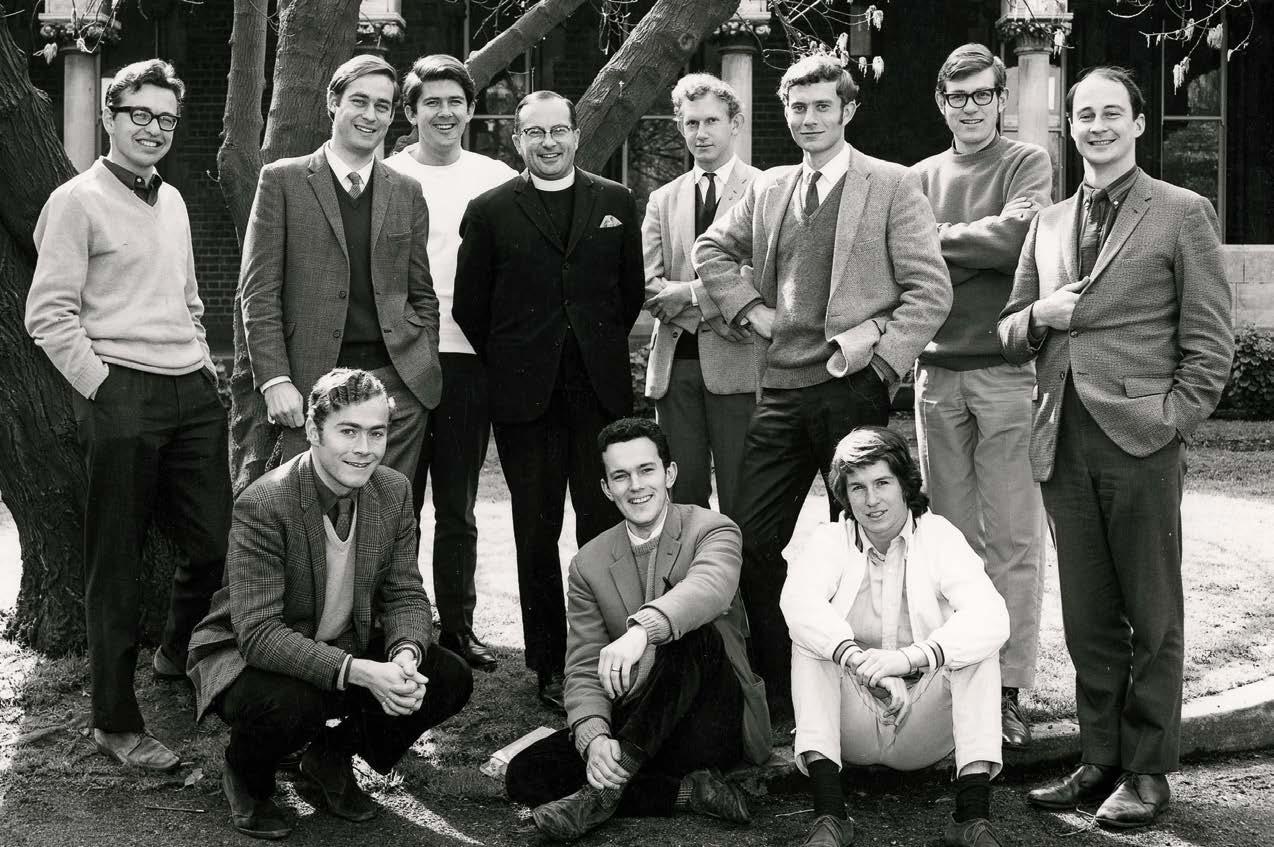
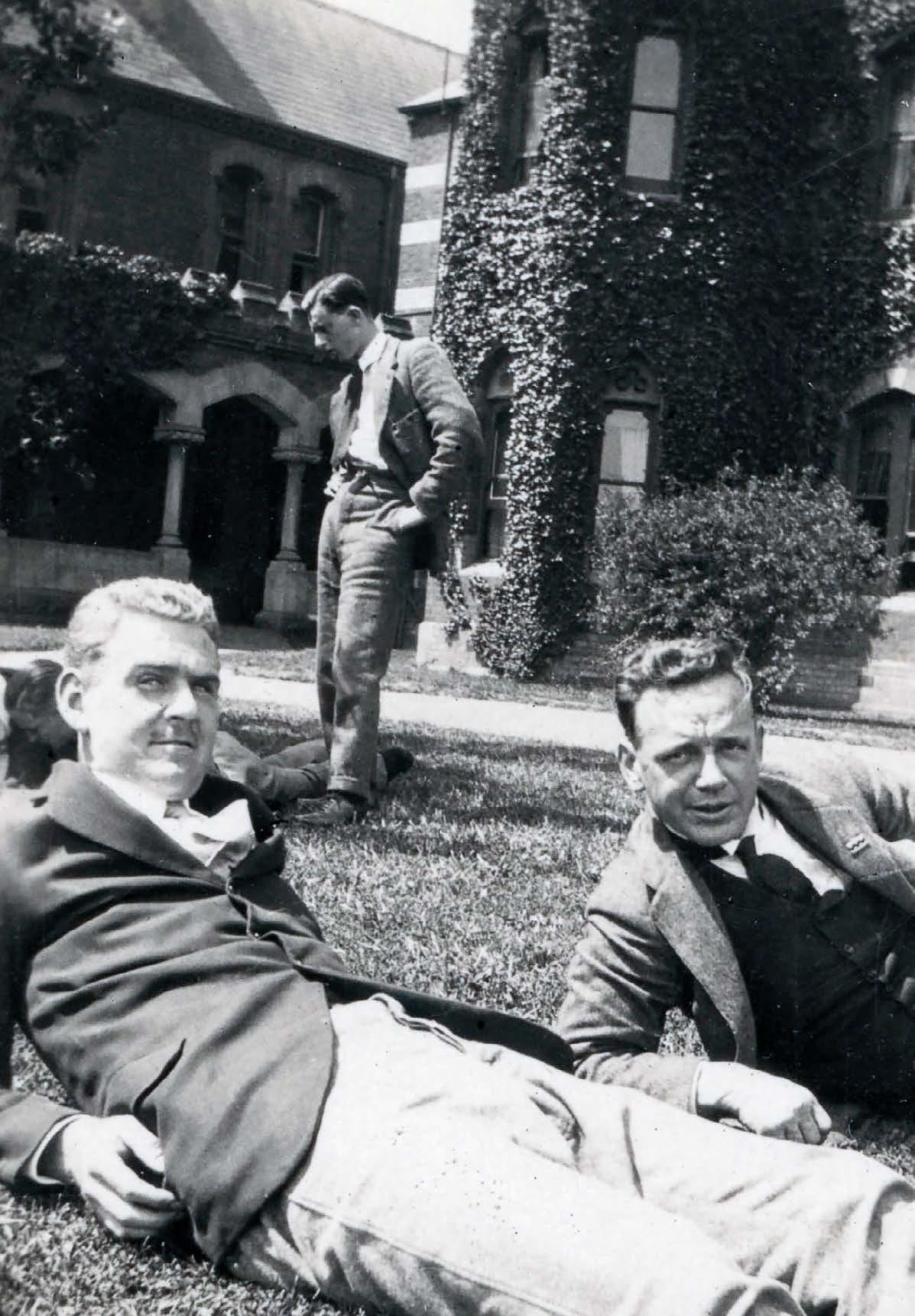
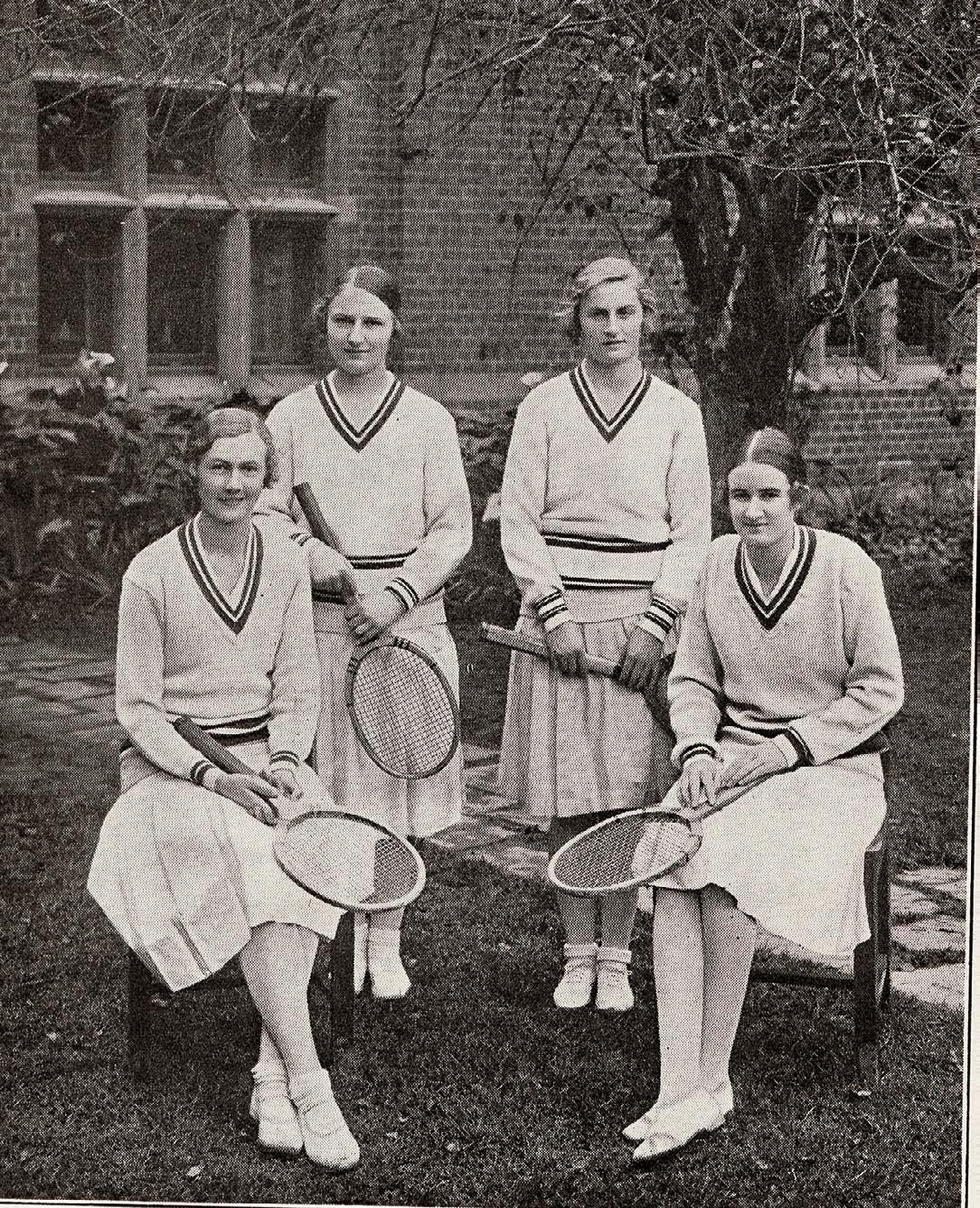

FASHION ● 51 TRINITY TODAY
Dinners in the Dining Hall looked a bit different in the ’80s - you could wear your taffeta and light up a ciggie while waiting for your meal to arrive.
The Janet Clarke Hall tennis team in 1931, wearing woollen jumpers and long skirts: the perfect attire for a summer sport in Australia.
The student rowing crew in 1933. Note the pipe and on-trend plus fours.
Former Chaplain the late Barry Marshall with theology students in 1969, when suit jackets, ties and vests were considered ‘everyday’ wear for young men.
Posing for an album cover before albums even existed.
Trinity On trend
Tradition has long been upheld by our Theological School, as shown by the Trinity staff and supporters at the Chapel centenary in 2016.
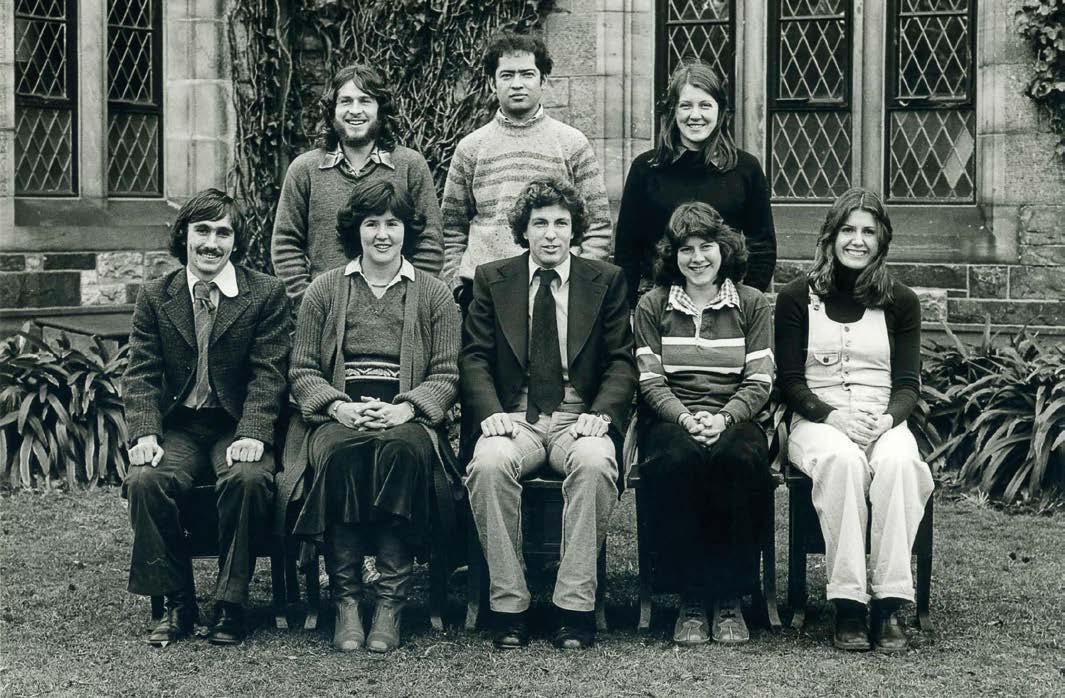

The official party portrait in front of the Leeper building following the laying of the Chapel foundation stone in 1914 was a formal affair.
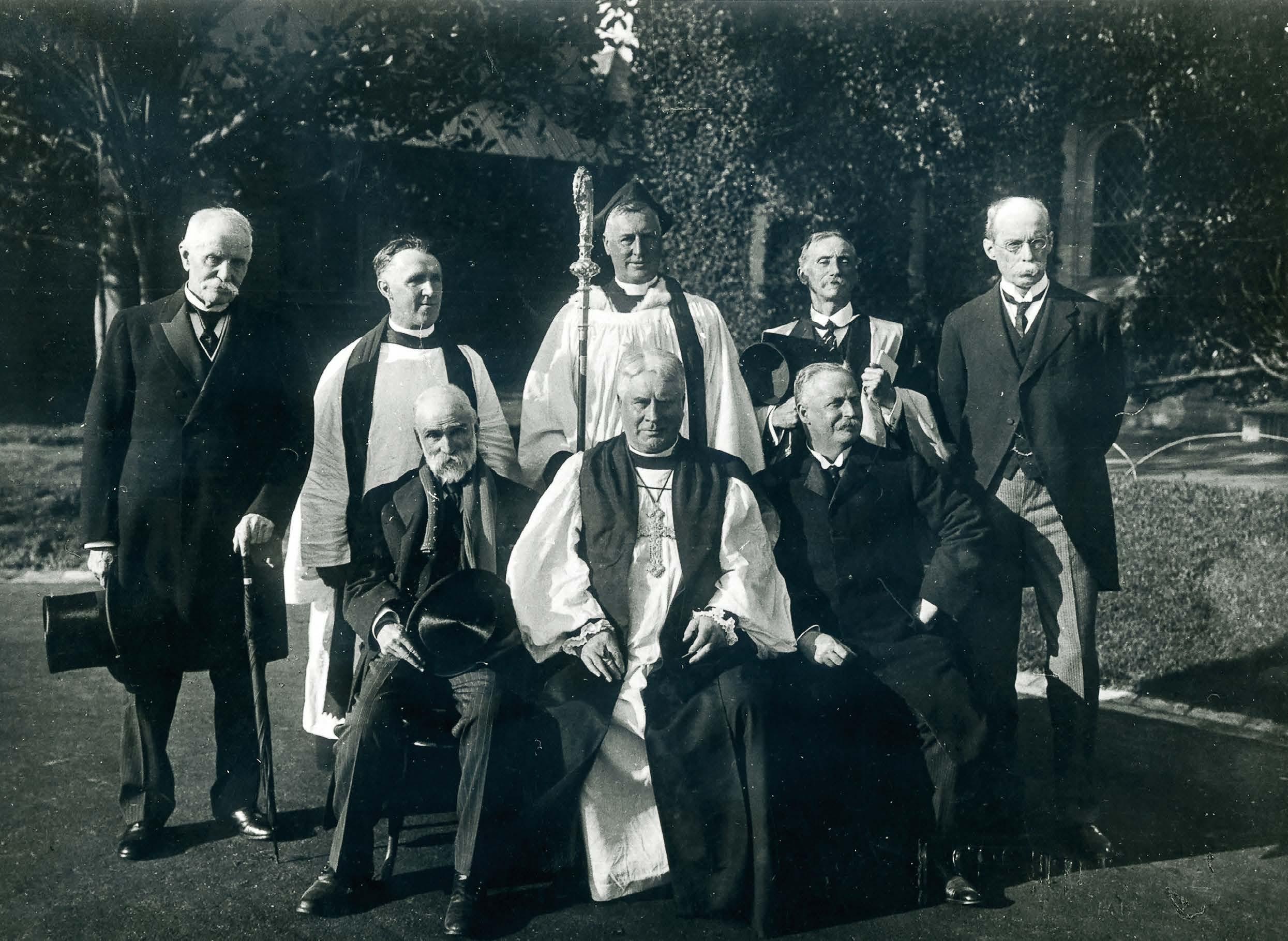
TRINITY TODAY ● 52 FASHION
The 1977 swimming team, proving that Farrah Fawcett was a hairstyle icon for both men and women.
PHOTOS: TRINITY COLLEGE ARCHIVES, KIT HASELDEN PHOTOGRAPHY
If you can believe it, the 1898 rowing crew regarded this as their ‘casual’ attire.




Some strong ’90s fashion vibes here: the white jeans, the patterned jumper, the soft-wash leather jacket. These Foundation Studies students understood the brief.

FASHION ● 53 TRINITY TODAY
Principal Dr Alexander Leeper with Vice-Principal John Winthrop Hackett and students in front of the Warden’s Lodge in 1876. You can probably find their doppelgängers wandering around Northcote today.
Variations of the ‘candystripe’ in the ’90s.
Megha Kapoor
(TC 2004)
“There’s not really a particular moment when I became interested in fashion. I’ve always expressed myself via sartorial means and some of my earliest memories are of drawing dresses and designing things.
At Trinity, I had a lot of fun with fashion. I loved to dress up, planned my outfits well in advance and took a lot of risks. I wore blue eyeshadow, went through a phase of dressing like a Gothic Mary Poppins, and loved to wear colour, including in my hair (I was a lot more expressive then than I am now).
When I look back, I wasn’t just experimenting and having fun, but was also trying to create a sense of belonging and cut through casual racism. People love to trivialise fashion, but, for me, growing up as an immigrant in New Zealand and being a woman of colour at Trinity made it important for me to use fashion to feel a sense of power and to find myself a place within the community.
Though I’ve always been drawn to fashion and used it to my advantage, while at College I couldn’t have fathomed a career in the industry; I was studying law and politics and didn’t have any connections in the industry. I worked in commercial law firms for a while but eventually the fashion industry drew me in and proved to be complex and rewarding. There’s often a misconception that the fashion industry is just about glamour, but, from my experience, the fashion industry attracts some of the hardest-working people.
Another thing that some people don’t realise is that everyone is connected to fashion, whether they think they are or not. Fashion is self-expression. Fashion is storytelling. Fashion is art. I feel so lucky to be a part of it.
in Australia and India. Born in India, Megha moved to New Zealand with her parents when she was two years old. After finishing school in Auckland, Megha moved to Melbourne and graduated with a Bachelor of Law and Arts (Honours) from the University of Melbourne. She decided to pursue a career in fashion and moved to Mumbai to take a Condé Nast journalism cadetship at Vogue India, where she worked as a junior fashion writer. She later joined Vogue Australia, then indie publication Oyster magazine, where she was Fashion Director and Content Leader for digital fashion, music and the arts. In 2015, she founded the modern luxury publication INPRINT. At Trinity College, Megha was on the Fleur de Lys magazine team and captained the squash team.
MEGHA KAPOOR is the Head of Editorial Content at Vogue India. She is also a creative director and

TRINITY TODAY ● 54 OAKLEAF AWARDEE
stylist
PHOTO: SUPPLIED
150

YEARS
OF ARCHITECTURE
● 55 TRINITY TODAY
DINING HALL A new era for our

The beating heart of Trinity College will undergo major renovations in 2023.

TRINITY TODAY ● 56 ARCHITECTURE
The opening of the Dorothy Jane Ryall building (‘Dorothy’) in 2020 enabled additional residential students to join the Trinity community, taking our total number of residents to 380.

Our Dining Hall now requires increased capacity to be able to seat all students simultaneously, as communal dining is one of the things that make the Trinity College experience so special. It’s over a meal that many achievements are celebrated, inspirational speakers heard, notices communicated and friendships made.

To this end, we have begun a redevelopment of the Dining Hall and surrounding facilities, known collectively as the Kitchens Precinct. The renewed space will honour the existing design aesthetic, which is well recognised as a defining feature of the College.
Read more about the Dining Hall’s evolution since its inception in the 1870s and the current redevelopment plans.
ARCHITECTURE ● 57 TRINITY TODAY
MAIN: An artist’s impression of the renovated Dining Hall. INSET: An artist’s impression of the new servery.
BY DR BENJAMIN THOMAS
In April 1881, less than a decade after Trinity had welcomed its inaugural student and a mere three years after Bishops’ building had swung open its doors, the College found itself in desperate need of more accommodation. Applications for rooms at Trinity were so numerous a nearby house had to be rented to meet demand.
Ormond – Trinity’s first competitor – had opened a month earlier, and given the ‘new’ college had all the trimmings, Trinity was under pressure to produce an equally (or more) appealing offer. The College Council estimated that £5000 would be needed to fund a new wing, on top of a similar sum that was required to pay off debts.

Melbourne merchant Richard Grice was the first to step forward to assist, offering £250. An anonymous donor then pledged a similar amount, and other smaller amounts were gifted thereafter. This was not nearly enough, but the College’s fortunes changed when pastoralist and businessman Joseph Clarke came forward with £5000.
‘Mr Clarke has not given his present grudgingly, but in the spirit of the freest generosity,’ The Australasian newspaper told its readership.
To help put this sum into perspective, in 1881, residential fees, including tuition, were about £80 a year, and the average annual wage for a bricklayer in Melbourne was about £125. Relative to today’s prices, the gift was in the order of $2 million.
A generous duo
Born in 1834, the youngest of three sons to William ‘Big’ Clarke, Joseph had moved to Melbourne from Tasmania with his family in 1876 and bought a comfortable mansion in Toorak. He had inherited his father’s sizeable pastoral interests in Tasmania (in excess of 70,000 acres), held pastoral runs in Queensland, was director of the Hobson’s United Railway Company – in which his older brother William was also a major shareholder – and later had business interests in insurance and mining. William himself had earlier supported Trinity and, with Joseph’s contribution, there was broad consensus that the two brothers should be jointly
Think big, give big
recognised in name with the proposed new building.
Despite the scale of Clarke’s munificence, a sum of £6000 was still urgently required to balance the College’s heavy debts. Warden Alexander Leeper pointed to a College that was ‘overflowing with students’ and one that had inadequate accommodation. The hardest pill to swallow was the fact some students had to be sent to Ormond.
The Warden continued to plea for donations, and in November, William E Stanbridge offered £600 to go towards the new building, and by May 1882, a further £6500 had accumulated through smaller gifts.
Building on the College’s 1869 master plan, the Sydney firm of Edmund Blackett devised a design for the new wing. A neo-Gothic building would be constructed at right angles to Bishops’, in corresponding Hawthorn brick, and would give form to the intended quadrangle proposed in the original master plan (although it would take
almost 80 years for that notion to be realised, with the completion of the Cowan building in the late 1960s).
Built under the supervision of Melbourne architect William Pritchard, the new wing housed its first students in mid-1883. The building contained a club room (later to become the Junior Common Room), a billiards room (which is still popular to this day), bedrooms, and sitting rooms facing the quad, and brought Trinity’s residential capacity to 50 students (up from 30).
The construction cost £11,000, with Joseph adding £1000 to his earlier gift, and Sir William Clarke gifting a further £3000. This reinforced the College Council’s earlier decision to honour both brothers by naming the new wing the ‘Clarke Buildings’ (later referred to as Clarke’s).
In 1888, The Argus wrote: ‘None perhaps, except those immediately connected with the management of the College, know exactly how much it owes to the liberality of Sir William and Mr Joseph Clarke.’
TRINITY TODAY ● 58 ARCHITECTURE
Among many valued donors, the Clarke family has made significant contributions to Trinity College’s built environment, and in turn, its educational offering.
The Clarke family’s generosity only increased from there, and it fundamentally shifted the College’s educational offerings by bringing women into the fold.
Enter Lady Clarke
The first female student joined Trinity in 1883 and, as interest in the College from women grew, a terrace house was rented on Royal Parade to house the Trinity College Women’s Hostel. Janet, or Lady Clarke – Sir William’s wife – had grander aspirations, however. Following a gift of £5000, the foundation stone was laid on 17 March 1890 of what would initially be known as the ‘Janet Clarke Building’. It was the first stage of what Lady Clarke envisaged as an eventual quadrangular block immediately north-west of the building named after her husband and brother-in-law.



At the foundation stone laying ceremony, Warden Leeper identified several types of supporters of the College. One group, he noted, possessed great wealth but ‘gave very little and very grudgingly’ during their own lifetime, leaving a significant sum as a bequest. Not to be discredited, he nonetheless expressed some reservations towards those who ‘only left to others what they could not take away with them.’ However, another category, he said, ‘gave large sums for public purposes and still larger sums in private charity, and gave time and sympathy with them.’ To rapturous applause, he acknowledged it was to this category that Lady Clarke and Sir William belonged.

The Janet Clarke Building, housing the Trinity College Hostel, formally opened a year later. Not only had Lady Clarke funded the initial construction but she had subsequently contributed a further £1000 to cover the building’s fittings and furnishings. In 1921, the building’s name was changed to ‘Janet Clarke Hall’, but decades of female students would pass through as collegians of Trinity. In 1961, Janet Clarke Hall became an independent, women-only college, then became co-residential a little over a decade later.
The power of giving
The sentiment of the Clarke family’s incredible generosity throughout Trinity’s seminal, founding decades was perhaps best described by the Governor of Victoria, the Earl of Hopetoun, in 1891: ‘They not only have the power to give, but they are not afraid of giving, and they are satisfied to live in the country in which their money has been made, and to spend it with those among whom they have been brought up.’
This notion has since been repeated many times over as Trinity has been the beneficiary of countless donations from generous supporters, who, like the Clarkes, have played – and continue to play – a significant role in helping the College offer the best educational opportunities to its students.
ARCHITECTURE ● 59 TRINITY TODAY
FROM TOP: Lady Janet Clarke, Joseph Clarke and Sir William Clarke.
IMAGES: KIT HASELDEN PHOTOGRAPHY, AUSTRALIAN WOMEN’S REGISTER, THOMAS FLINTOFF AND COURTESY OF THE CLARKE FAMILY
Andrew Farran (TC
1957)
“
As I discovered in 1957, the transition from boarding school to College residency is immense. And possibly the most transforming experience of your life – unless you have to go to war (heaven forbid).

During my four years in residence, it became clear that Trinity’s integral centre was the Dining Hall. It was where high days and feast days were celebrated, where one met and got to know new friends, and where experiences were consolidated in ways that lasted a lifetime. Some may have thought the requirement to wear academic gowns to dinner was a bit of an imposition, but its purpose was to make a statement about being a student in a special universe of study and intellectualism, as seen in the other world-renowned universities from which our deep academic traditions have been derived.
The Dining Hall hypostasised the notion of being part of a corporate entity, a community of scholars like no other previously experienced. In this regard, it was important that College residents could meet as one body and not be divided into groups. In my time this was not a problem. We could all fit in comfortably. But resident numbers are now twice what they were then, and the Dining Hall has not expanded commensurately. But not to worry, plans are afoot to rectify this and before long, residents will be able to celebrate important events in a setting appropriate for all occasions.
ANDREW FARRAN was a skilled cricketer at Trinity and was welcomed into the cricket team, which went on to win the intercollegiate cricket championship for three of the four years he was in residence. As well as getting involved in sport, Andrew became well acquainted with the university sector throughout his college years. In his first year, he was approached to support an appeal on behalf of the World University Service to provide better services for tertiary students in developing countries. Over the following two years, he acted as university correspondent for The Age and considered journalism as a career. However, the associate editor pointed out that The Age at that time had only one university graduate and that Andrew should pursue his other interest, law. Upon graduation and admission to the Bar, Andrew served as an Australian diplomat and Commonwealth public servant in Canberra and abroad over the next decade. Other career options (academic and business) were taken thereafter. Andrew has long been a supporter of Trinity College and has made a generous gift to facilitate the renovation and expansion of our Dining Hall.
TRINITY TODAY ● 60 OAKLEAF AWARDEE
PHOTO: TRINITY COLLEGE PHOTOGRAPHER
150 YEARS OF RELATIONSHIPS

● 61 TRINITY TODAY
David Elliot-Jones, Louis Dai and Lachlan McLeod met at Trinity College during O-Week in 2007. At the time, they could never have foreseen that one day they would own a video production company together.

Walking the road
TRINITY TODAY ● 62 RELATIONSHIPS
PHOTO: SUPPLIED
BY EMILY McAULIFFE
‘H
mm, I can’t remember.’ Dave’s eyes dart behind his glasses as he looks skyward, searching for the memory of meeting Lachlan for the first time.
‘Really? You can’t remember our first moment?’ Lachlan retorts, with a disappointed shake of his head.
‘Well, can you?’ Silence.
and a short course in videography, completed after he finished high school. Louis, who was intent on becoming a journalist, and Dave, a fellow media and communications student who was cutting his teeth in student radio, say they simply liked watching films, and didn’t have a desire to make them until they started playing around with a Handycam at Trinity.
for two years on a working holiday and used the time to make the documentary Big in Japan, which was picked up by Amazon Prime upon its 2018 release and screened on Qantas flights.
‘That’s when we got the confidence to get into corporate work and charge for our services,’ says Lachlan. In 2019 they quit their side hustles and went in full time.
Of course, running a full-time business with your best mates has its pros and cons.
The initial meeting of Lachlan McLeod and David Elliot-Jones – who would later become business partners – seemingly wasn’t very memorable.
‘The College environment enabled some of those early film projects, like the pigeon one, for example,’ says Dave. ‘There was the competition run by the film club, plus, at College, you’ve got all

to success
On the other hand, Lachlan’s first interaction with third business partner, Louis Dai, is memorable, because Louis fell asleep mid-conversation. They were on a College boat cruise, it was late, and either Louis was tired or Lachlan was boring. It depends on who you ask.
With the three reminiscing about their O-Week experiences, Dave suddenly pipes up, having recovered an early impression of Lachlan, who lived directly opposite him in Upper Cowan. ‘Actually, I remember Lachie being very polite, kind of like my dad or something.’
Despite their less-than-inspiring first impressions, the three freshers gradually found more things in common and bonded over their shared love of music, The Office (‘The UK version, of course’), and their interest in making short films around campus.
The trio’s first ‘big’ film was made for the Trinity film festival and was about their mutual friend’s obsession with pigeons. ‘It was a strange film,’ Lachlan reflects.
Following on from this, the first film that brought the students notoriety outside Trinity College, with a screening at the Brunswick Film Festival, was a short film about Dave having nobody to celebrate his birthday with him. The twist? He was thrown a surprise party by a collection of soft toys. Lachlan: ‘Yeah, that was strange as well.’
Lachlan’s interest in films came from making home videos while growing up
this free time on your hands and you’re surrounded by people with similar interests and are encouraged to give things a go. If it wasn’t for that environment, we probably wouldn’t have done any of this.’
The friends say that if they had to pin down the moment their filmmaking became more serious, it was when they created a documentary about Australia’s student migrant crisis, circa 2010. They each pitched in $300 to buy a camcorder off eBay, then set off overseas.
‘We had this really hack set-up, but got cheap tickets to India and decided to follow Indian students, trying to capture the entire process of applying to study abroad, to landing in Australia,’ says Louis. ‘We shot way too much stuff and didn’t know what we were doing, but when we came back to Australia, we had a side of the migration story that the mainstream media didn’t have – the student perspective.’
The resulting film, Convenient Education, was pitched to and accepted by SBS in 2012, which led to another project with the broadcaster. At that point, funding became involved, and this provided the impetus for setting up a business. Walking Fish Productions (named after two pet axolotls the boys had in their first share house out of College) was born, and the trio started exploring the stories of interesting people and topics that were ‘bizarre or intriguing’.
The next big break came when the guys and their partners moved to Japan
‘I think the pros are that we trust each other and we know we can always rely on each other,’ says Louis. ‘But in the early years we were trying to figure out where we fit into the bigger picture. We all fell into it at the same time and none of us had any particular industryspecific skills, so it took us a while to work out what our strengths and weaknesses were. Now we comfortably have roles that we’ve assigned to each other and that’s helped us work more cohesively as a unit.’
As well as content for channels like VICE, The Guardian and Al Jazeera, the Walking Fish portfolio includes several videos created for Trinity College, which the team says are always enjoyable and bring back fond memories. ‘It’s always fun doing Trinity shoots because you get different perspectives of your own experience,’ says Louis.
‘Plus, the reality is, the production company wouldn’t exist without Trinity College … [Going to Trinity] is such a unique experience that not a lot of people get to have and we’re all very privileged to have had it. We’re very grateful.’
Clean, a Walking Fish documentary about a woman working in the trauma cleaning business, was the closing film at the 2022 Melbourne International Film Festival and screened on SBS.

Watch
Hall.
RELATIONSHIPS ● 63 TRINITY TODAY
a video made by Walking Fish about Trinity’s Dining
SIBLING SUPPORT when you’re a long way from home
How would you describe your upbringing in Colombo?
SASKIA We grew up in a bilingual household where we spoke both English and Sinhala. I’d say we come from a privileged background in that our parents worked really hard to ensure my brother and I received a good education and had the best opportunities possible. Our parents also made sure we didn’t forget our nationality, our culture, and the little things that make us Sri Lankan.
AQUINNE I agree that we have been very lucky in that sense, and we were also taught to care for other people and learnt the importance of doing charity and being compassionate.
Were you close growing up?
SASKIA We fought a lot … [laughs] … about literally anything. ‘I’m not touching you, you’re touching me’, ‘You’re still too close!’, ‘You’re eating too loud!’ – that kind of thing.
AQUINNE We fought a lot but that changed as we got older, and once we started living in Melbourne, we became a lot closer.
SASKIA Now we live less than two minutes away from each other on campus and I would 100 per cent say he’s my best friend … And I love how he hasn’t said anything back … [laughs]
AQUINNE No, we are. We definitely are.
Was studying overseas always part of the plan?
SASKIA Yes, always.
Why did you choose Melbourne?
SASKIA My parents didn’t want me going to the US and I didn’t want to go to the UK because it’s too cold. I actually applied for a liberal arts university in Abu Dhabi but was waitlisted, then I found out about a ‘fantastic foundation studies program in Melbourne’ from a guidance counsellor. I was told it would let me take foundation classes for one year while I decided what to study at uni, as I wasn’t sure what I wanted to do when I left school. I’m so happy I ended up in Melbourne. Then he just followed as he saw how good I was having it.
AQUINNE I thought it would be convenient to have us both in one place and when I visited Melbourne to drop Saskia off in 2019, I knew it was a place I wanted to live. But, really, after leaving school, everything’s been guided by Saskia. She’s like my guidance counsellor, she’s everything to me.
SASKIA Well, we were in lockdown for a long time and Aquinne lived in the city, so he would cycle up to the gate and bring me snacks, as nobody was allowed on campus. Once the lockdowns eased we would go and see each other, and now we make sure to go for coffee at least once a week to catch up.
AQUINNE It gives both us and our parents a bit of relief, knowing that we’re safe and well in Australia. Though you do feel a bit guilty because you’re here, halfway across the world, and have all the privileges, whereas in Sri Lanka at the moment, they don’t have fuel, they don’t have electricity. We have both been to visit but then we can come back to our airconditioning and nice food.
SASKIA I agree with that sentiment. I felt really guilty watching the protests and hearing that my parents were lining up overnight just to fill up on fuel. But, for our parents, they now know that everything they worked for, everything they did to ensure we had the opportunities to have a good life, have paid off.
TRINITY TODAY ● 64 RELATIONSHIPS
Saskia, what was it like knowing Aquinne was studying at the Pathways School while you were living in the Residential College?
What has it been like having each other close given the current economic and humanitarian crisis in Sri Lanka?
Aquinne, how much did you know about the Residential College before you joined?
AQUINNE Because we were in lockdown, nearly everything I knew about the Residential College was from Saskia. I sort of went in blind. She said to apply, so I did, and here we are.
Is there anything that has surprised you about each other since being in College?
SASKIA He’s a very strong debater. I hadn’t realised this.
AQUINNE She’s a bit quieter than I imagined, because, growing up, she always had to have the last word. I remember on our drives home from school, she used to talk and talk, and I used to just sit and look out the window because I couldn’t get a word in.
SASKIA I have the potential to keep my mouth shut. Who knew?
What’s the best thing about having a sibling at College?
SASKIA Often when you have a sibling at College, you know that they’re always going to be there for you, especially if, like us, you’ve travelled across oceans and are far away from family. It’s nice to have each other.
AQUINNE Being the good brother that I am, I’ll let her have the last word.

RELATIONSHIPS ● 65 TRINITY TODAY
Aquinne Wijewardene followed in older sister Saskia’s footsteps to Trinity’s Pathways School, and then Residential College. The duo, who are 18 months apart in age, grew up in Colombo, Sri Lanka, and moved to Melbourne in 2020 and 2019 respectively. We talk to them about their journey and what it’s like to attend Trinity with a sibling.
PHOTO: SUPPLIED
United on the path to adulthood
The worlds of Georgina Ridley and Charlie Kemp collided in 2014 when they joined Trinity as freshers. Here, the couple reflect on how their relationship evolved amid the ‘quirky’ College environment.


Georgina’s story
Charlie was the first person I saw when I arrived at Trinity in 2014. As I drove through the Gate B entrance – alongside my father, sister and nervous tummy – there stood one Mr Charlie Kemp and Mr (now Dr) Cale Dobrosak, both members of the 2014 TCAC, dressed in academic gowns and friendly smiles. In a statement that has not aged well, my sister, taking one look at Charlie, remarked, ‘That boy looks like Grandpa!’, which was a bit freaky given my grandpa, Brian Roberts (TC 1945), lived at Trinity almost 70 years ago.
Kemp (as I refer to him) is a kind, compassionate, tolerant, sensitive but also very silly individual. Our relationship – as I’m sure all do – has changed over the years, but what’s most important has stayed the same.
Our initial dates were SWOTVAC coffee runs to Union House and 7-Eleven, hanging out in the Middle Common Room in Upper Bishops’ and brunch at the then very hip-and-happenin’ Code Black cafe off Sydney Road. Charlie would also drag me along to his All Stars games (seconds football) – him thinking I would be the Bec to his Chris Judd. I must say, I was disappointed in his performances but there was no doubting his passion for the game.
In retrospect, our quirky College experiences made for a lovely way to become acquainted. We have both grown so much and we got to be a part of each other’s transition into adulthood.
Charlie’s story
Though Georgina and I were at Trinity together for all of 2014, we only crossed paths in the latter half of 2015. It was when I sat next to her a couple of times at Formal Hall and casual College dinners that I got to know the popular Trinity personality, then known as ‘G-Rids’.
I began to understand why she was so well loved at College. Georgina has the great ability to make anyone feel listened to and she would always engage full-heartedly in conversations and provide wisdom that seemed beyond her years. We would talk about anything from College, to family, to politics and uni. These conversations were always easy, fun and full of laughter.
Georgina also has a great unshakeable strength about her. I remember one day in the Dining Hall, I asked Georgina, as secretary of the Wine Cellar, if I could do an IOU for an event she was running. I assumed she would say yes, considering we were besties. She quickly replied, ‘What? Absolutely not. No way. Pay now like everyone else.’ This principled approach to financial austerity has since kept me in good stead.
Similar to what Georgina has said, some things have changed in our relationship, probably due to having our once-relaxed Arts timetabling replaced by a 9–5 workday. But it feels like yesterday that G and I met for the first time at Trinity. We look back very fondly and laugh at our time there, while also cringing at our initial awkward encounters in Upper Bishops’. That’s the joy of young adulthood.
TRINITY TODAY ● 66 RELATIONSHIPS
PHOTO: KIT HASELDEN PHOTOGRAPHY
150 YEARS OF EVENTS

● 67 TRINITY TODAY
THOSE WERE THE DAYS
At Trinity College, we’ve always valued the power of events in bringing us together and keeping us connected. Throughout our history, we’ve held events across Melbourne, Australia and the world (and online – thanks, COVID), never passing up an opportunity to network, celebrate and reminisce.



n ↑ 1952
n ← 1968
n → 1970
TRINITY TODAY ● 68 EVENTS
John Feltham (TC 1950) (standing) and fellow students during Juttoddie.
Lachlan de Crispigny (TC 1966) and Andrew Guy (TC 1966) at ‘Shums’ at the Riverside Inn.
Governor Sir Rohan Delacombe at the centenary of the laying of the foundation stone.
n → 1984

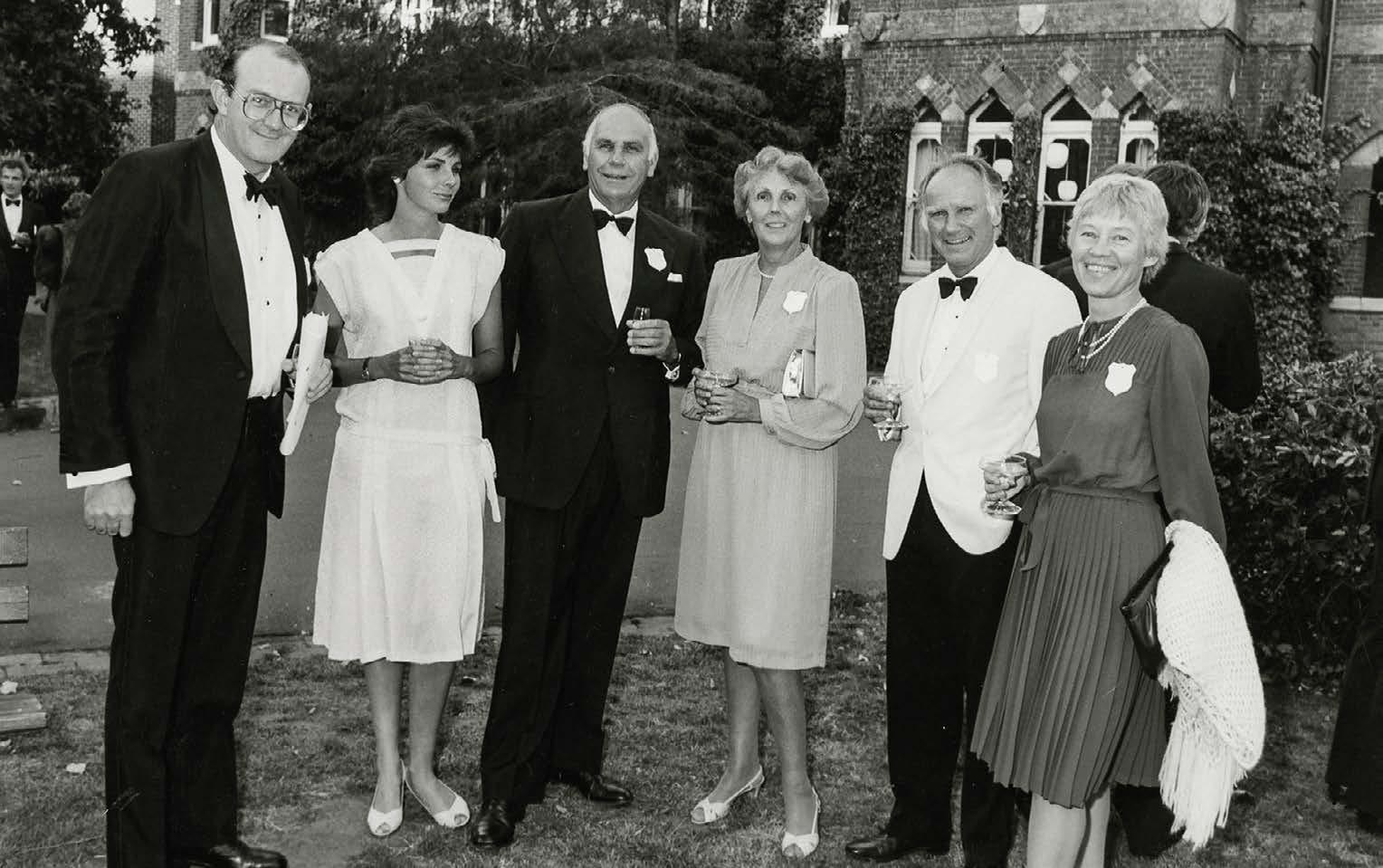


n ↑ 1983
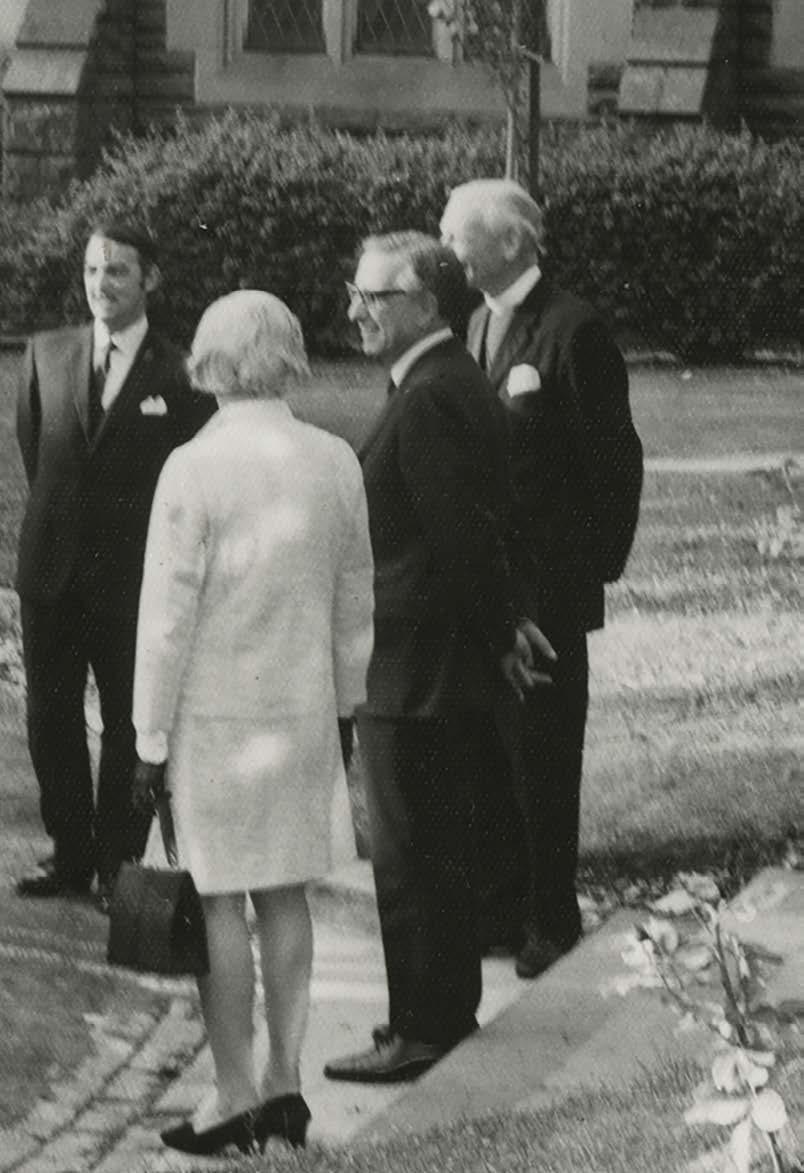
‘Dizzy’
n → 1989
Fresher
EVENTS ● 69 TRINITY TODAY
Tony Buzzard (TC 1960), Andrea Inglis (TC 1980), Sir Brian Inglis (TC 1946), Lady Leila Inglis, and John Johnson (TC 1950) and his wife, Marlies, at the Union of the Fleur-de-Lys Centenary Dinner in 1984.
Carlyon, Norman Carlyon (TC 1957), Louise Gourlay, John Gourlay (TC 1954), Heather Boyd and Ian Boyd (TC 1955) at the Fleur-de-Lys Gala Dinner in 1983.
breakfast on the Bulpadock.
THOSE WERE THE DAYS
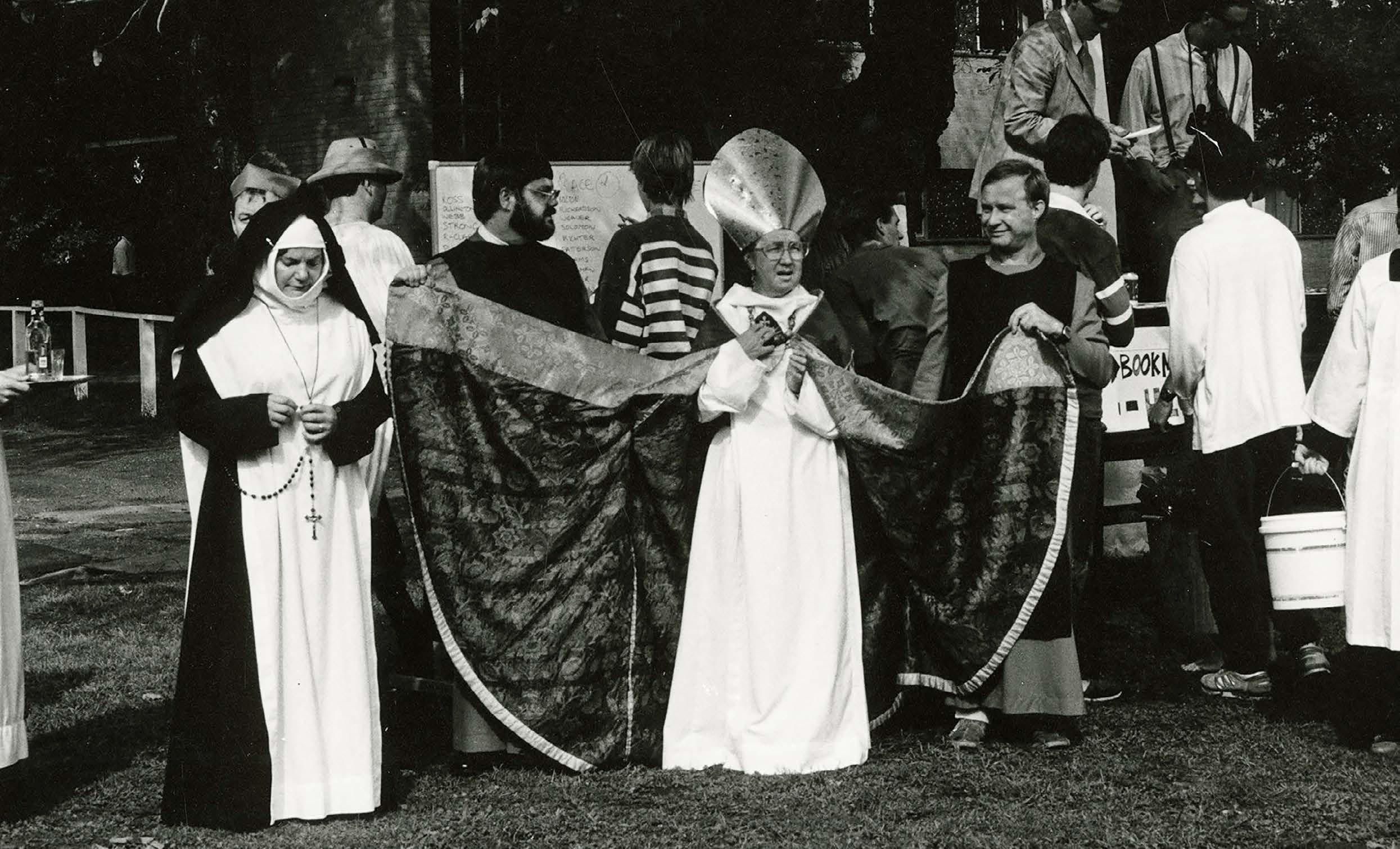
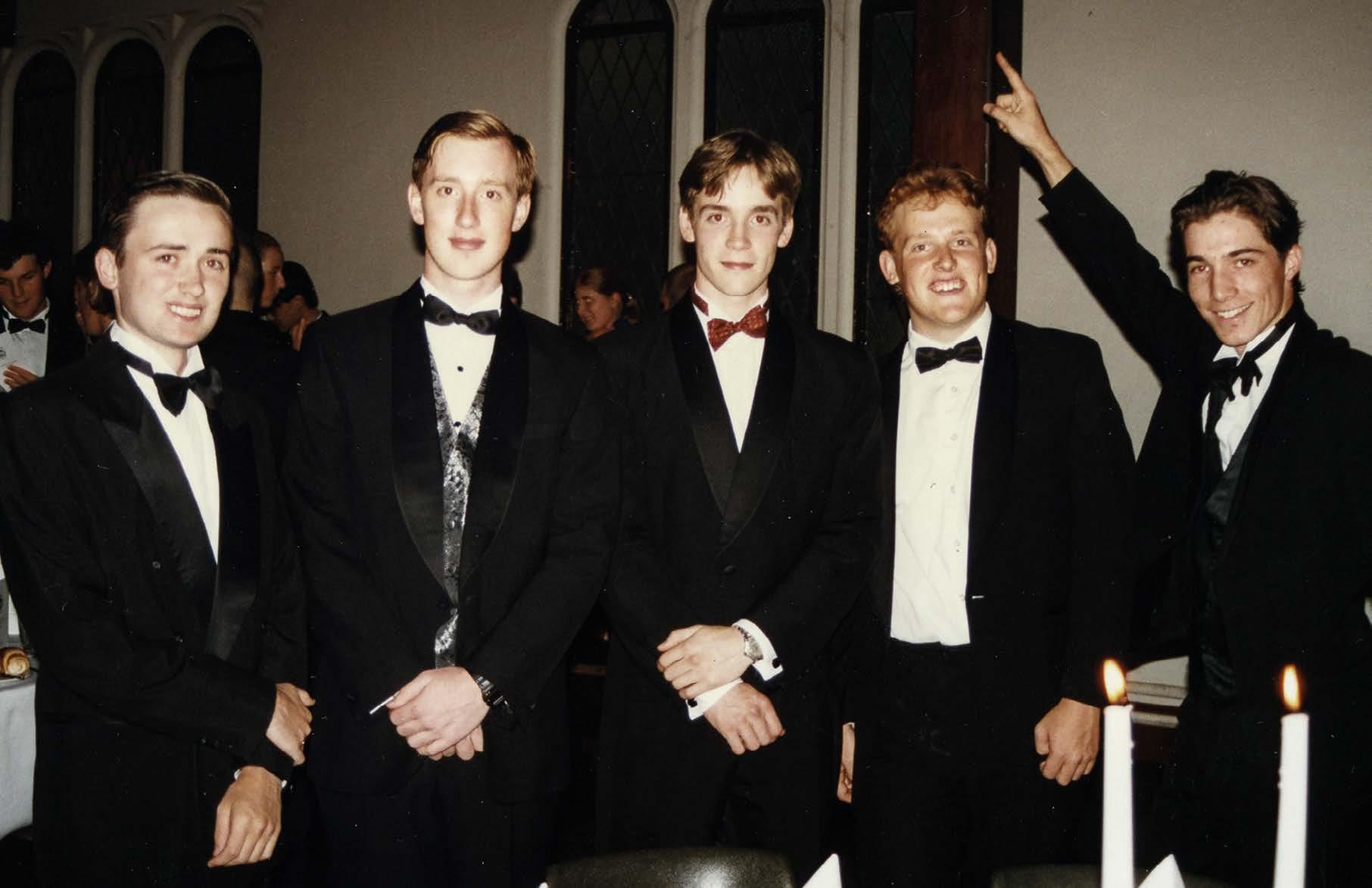
TRINITY TODAY ● 70 EVENTS
n ↑ 1989 The theologs at Juttoddie. n ← 1996 Students in the Dining
for Commencement Dinner.
Hall
n ← 2012

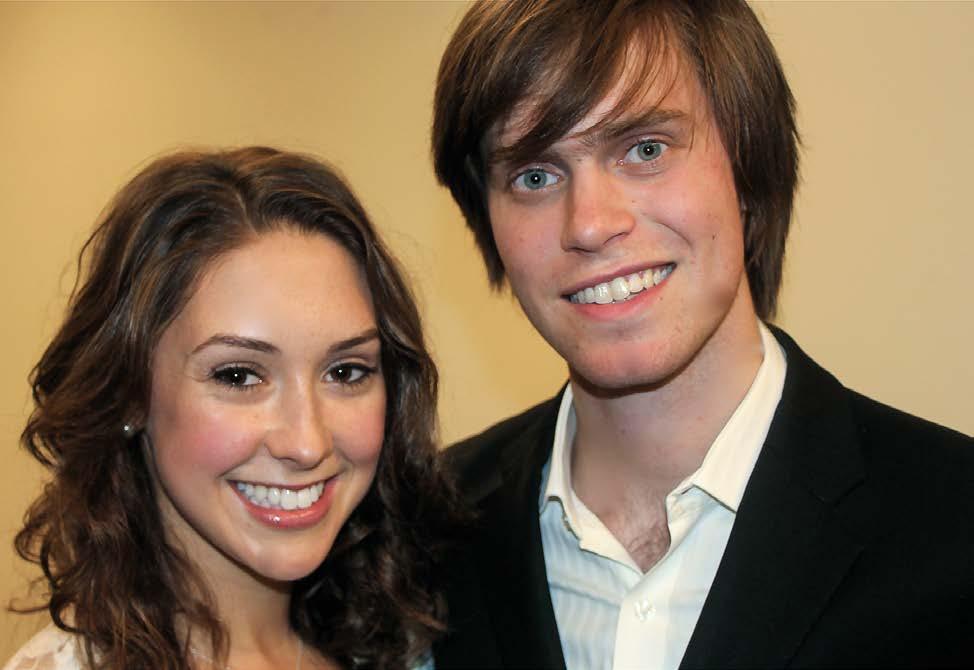
n → 2012
Foundation Studies Lunar New Year celebration.
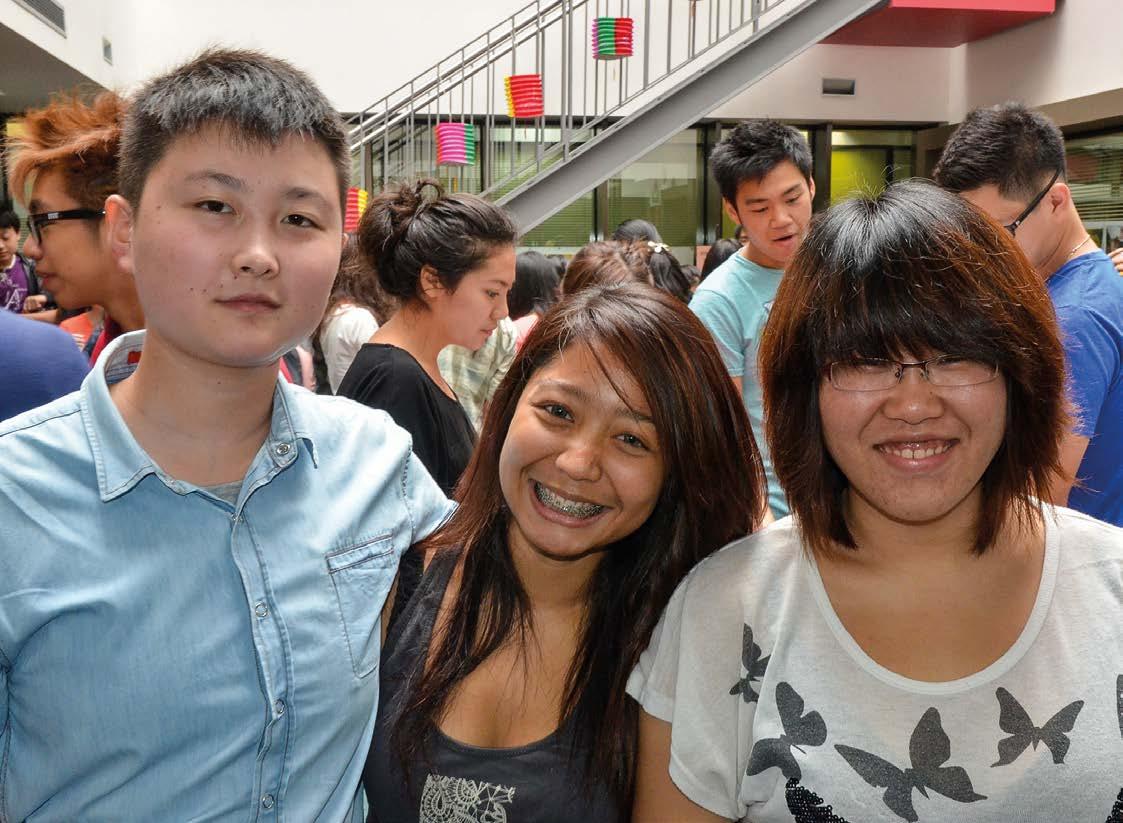
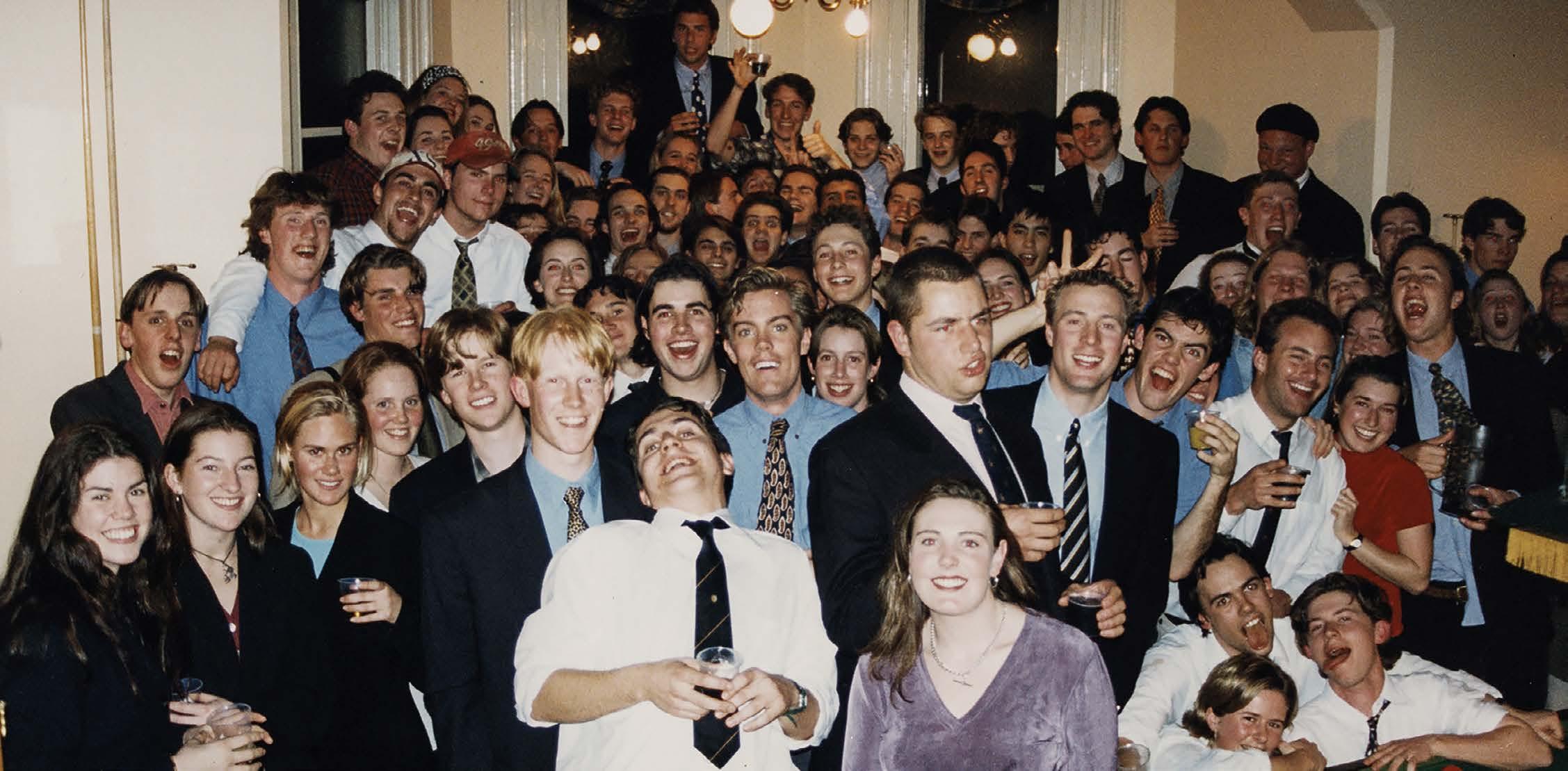

n ← 1996
n ↑ 1996
n ← 2010
EVENTS ● 71 TRINITY TODAY
Students gathered for the Billiards Room Night.
Chairman of the Trinity College Art Committee Sir Andrew Grimwade (TC 1949), Suzanne O’Connell and Lady Marsha Grimwade at the Art Patrons’ Dinner.
Natasha Robbins (TC 2010) and David Parncutt (TC 2009) at the Dean’s Dinner.
Jen Adler (TC 1995), Alice Radnor (TC 1995), Ange Arnold (TC 1994), Tara Hearn (TC 1995) and Anneli Knight (TC 1995) at the Trinity Ball.
THOSE WERE THE DAYS
n ↑ 2012
n ← 2015 Pathways School Big

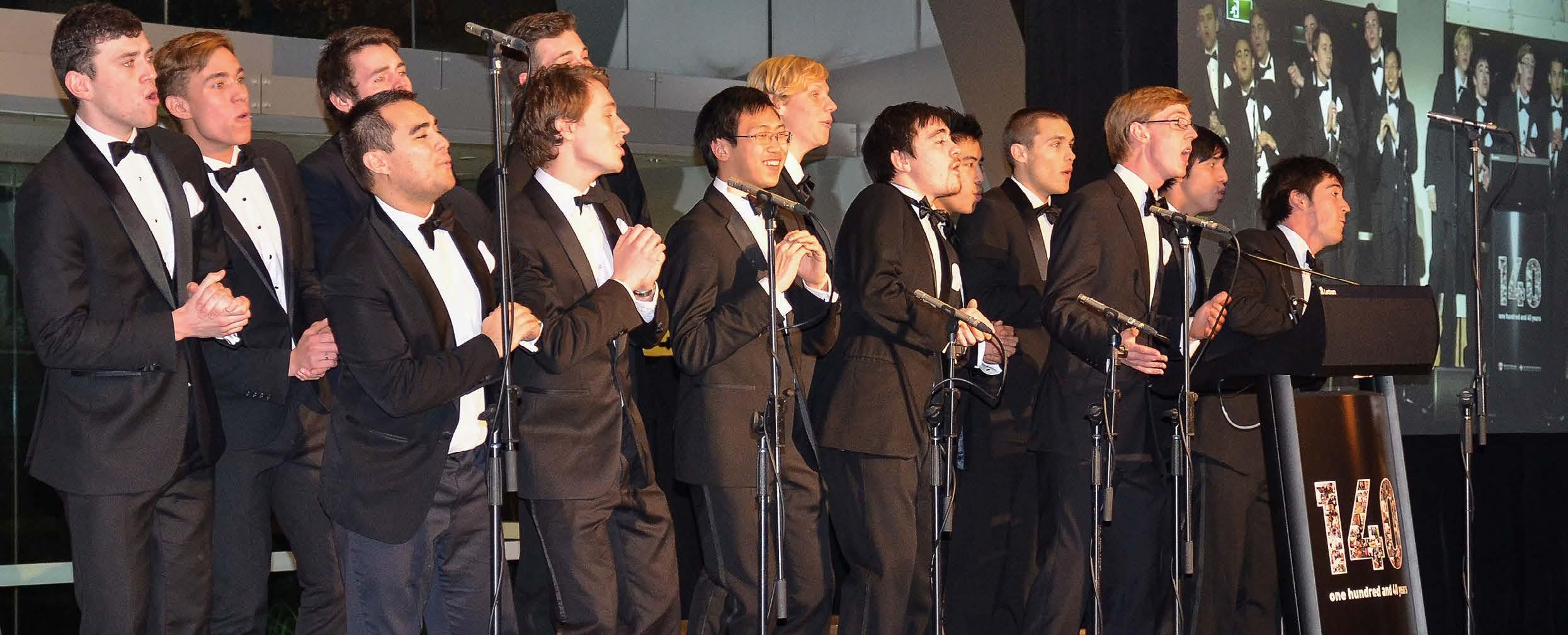

TRINITY TODAY ● 72 EVENTS
The Trinity Tiger Tones performing at the College’s 140th anniversary dinner.
Noise festival.
n ← 2015
n ↑ 2016
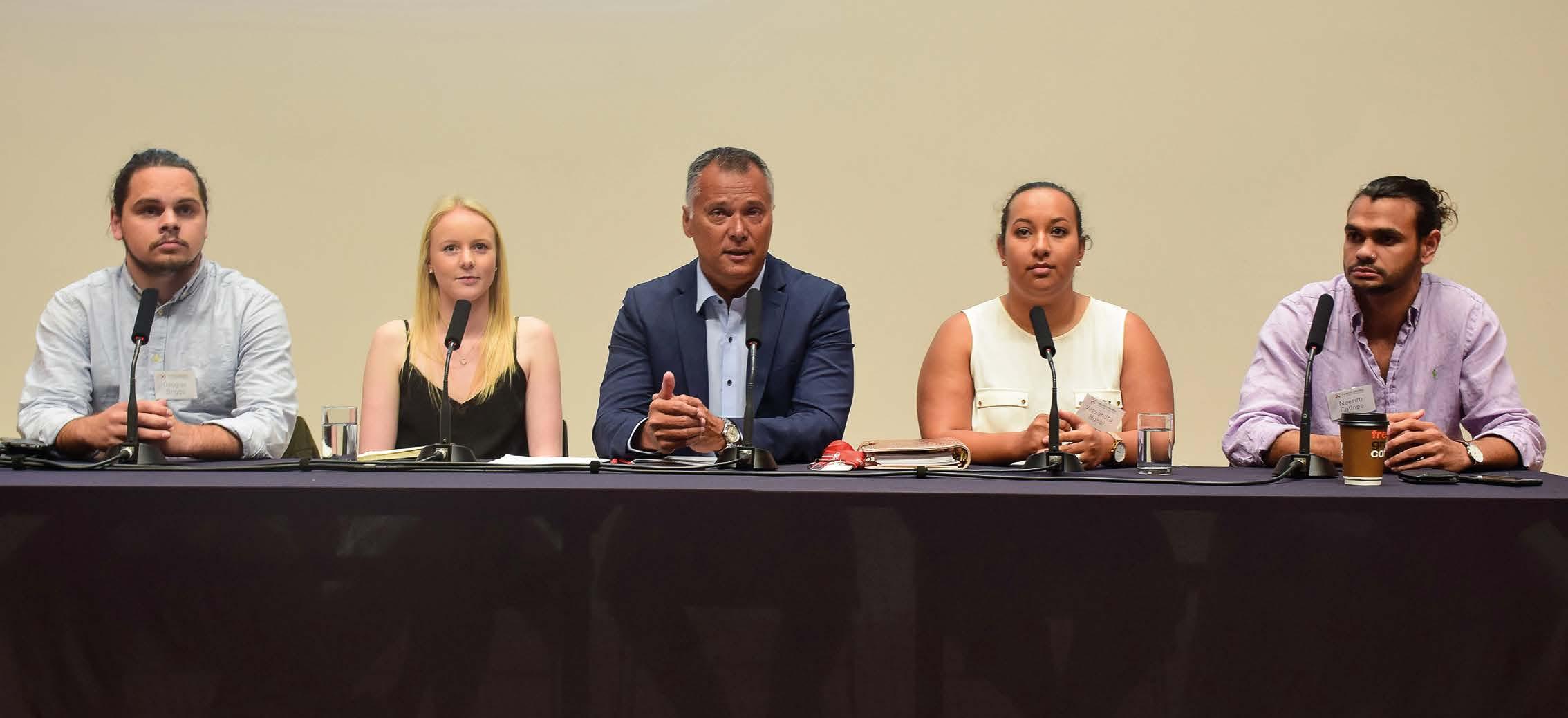
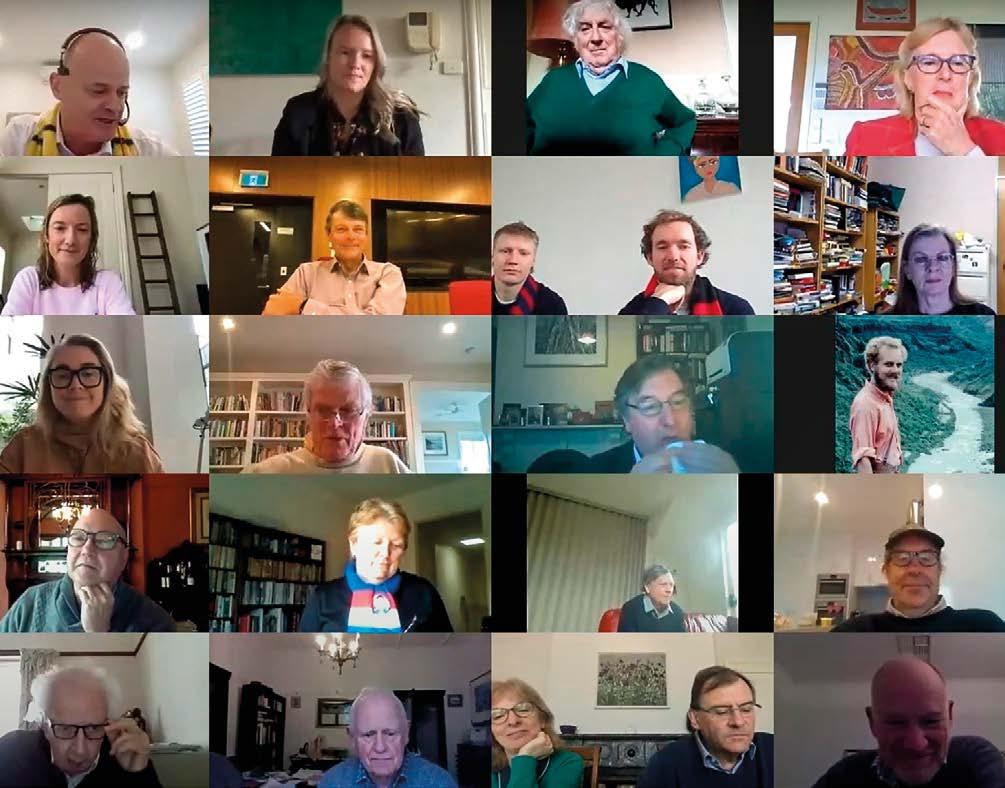
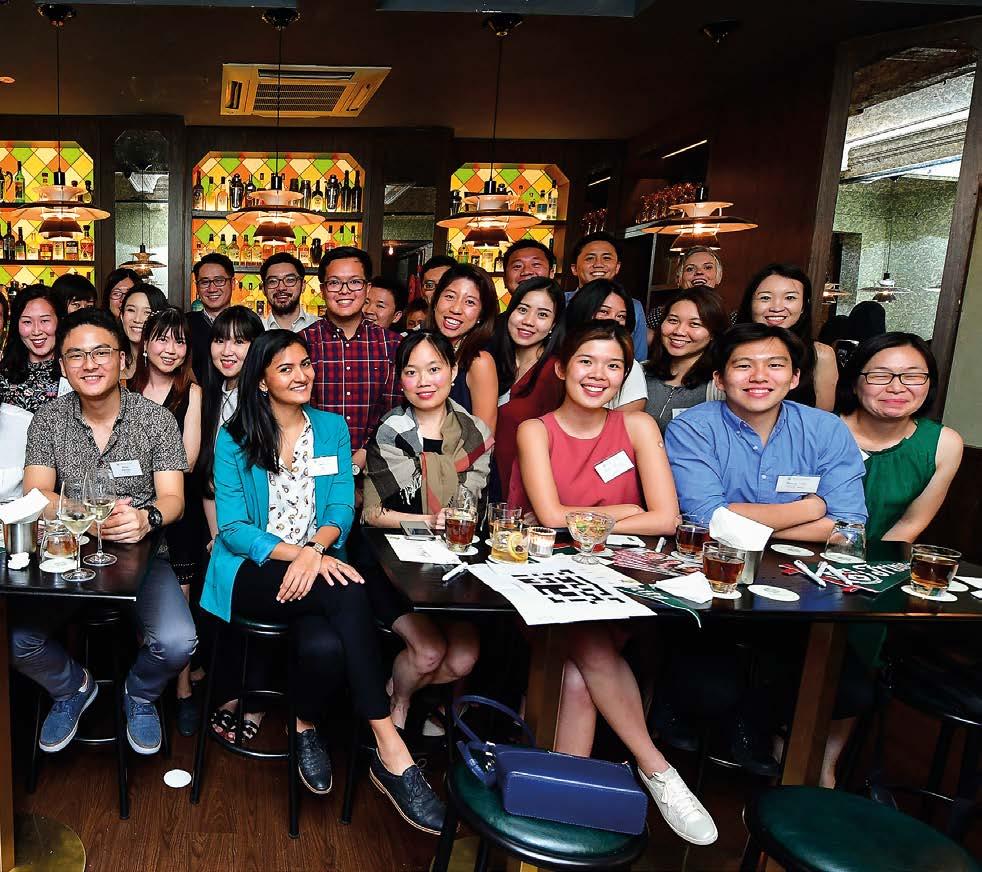
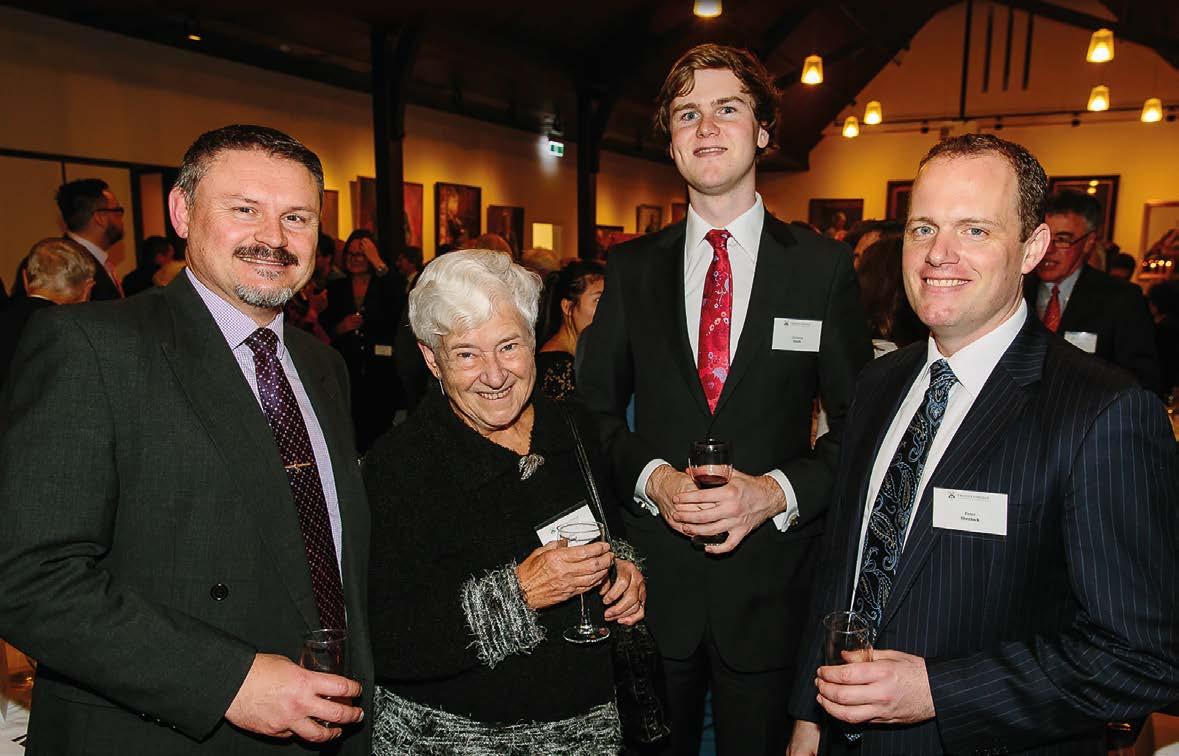
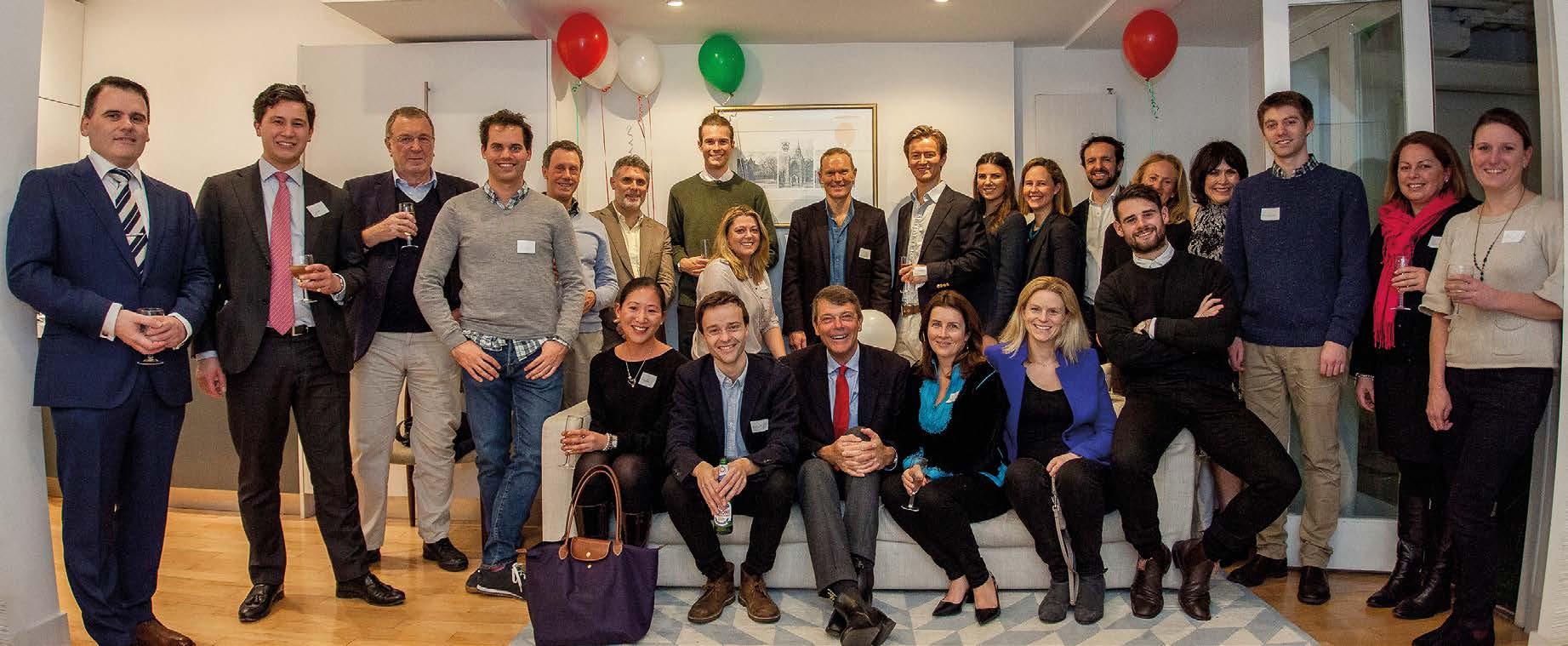
EVENTS ● 73 TRINITY TODAY
n
n ←
Doug Briggs (TC 2016), Eloise Bentley (TC 2013), Stan Grant, Alexandra Hohoi (TC 2015) and Neerim Callope (TC 2016) at the Trinity College Indigenous Higher Education Conference.
← 2017 London alumni gathering.
2019 Singapore alumni gathering.
Peter Campbell, Barbara Burge, Christian Smith and Peter Sherlock at the Archbishop’s Dinner.
n → 2020
The Cordner Oration AFL preliminary finals breakfast via Zoom.
THESE ARE THE DAYS 2022


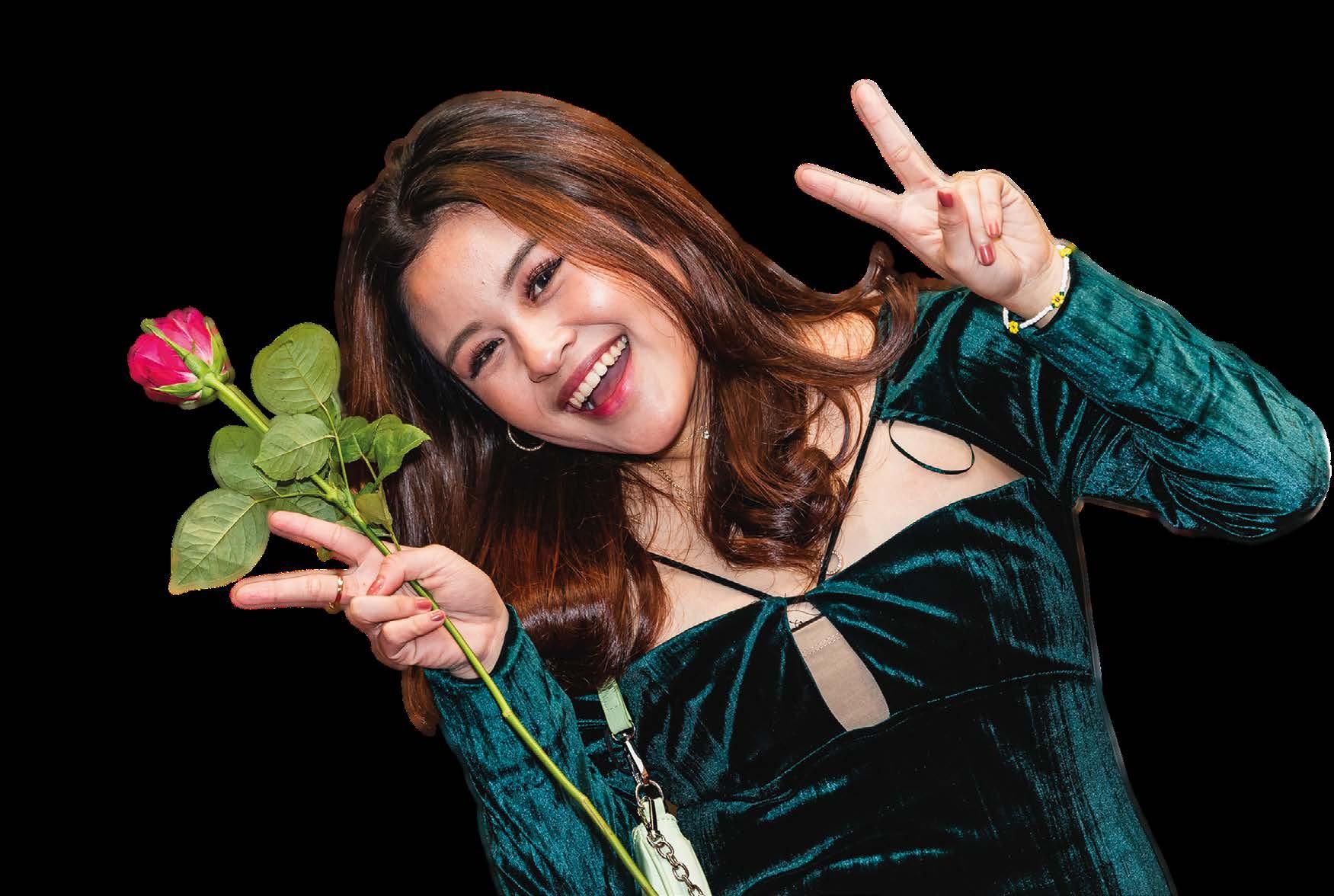
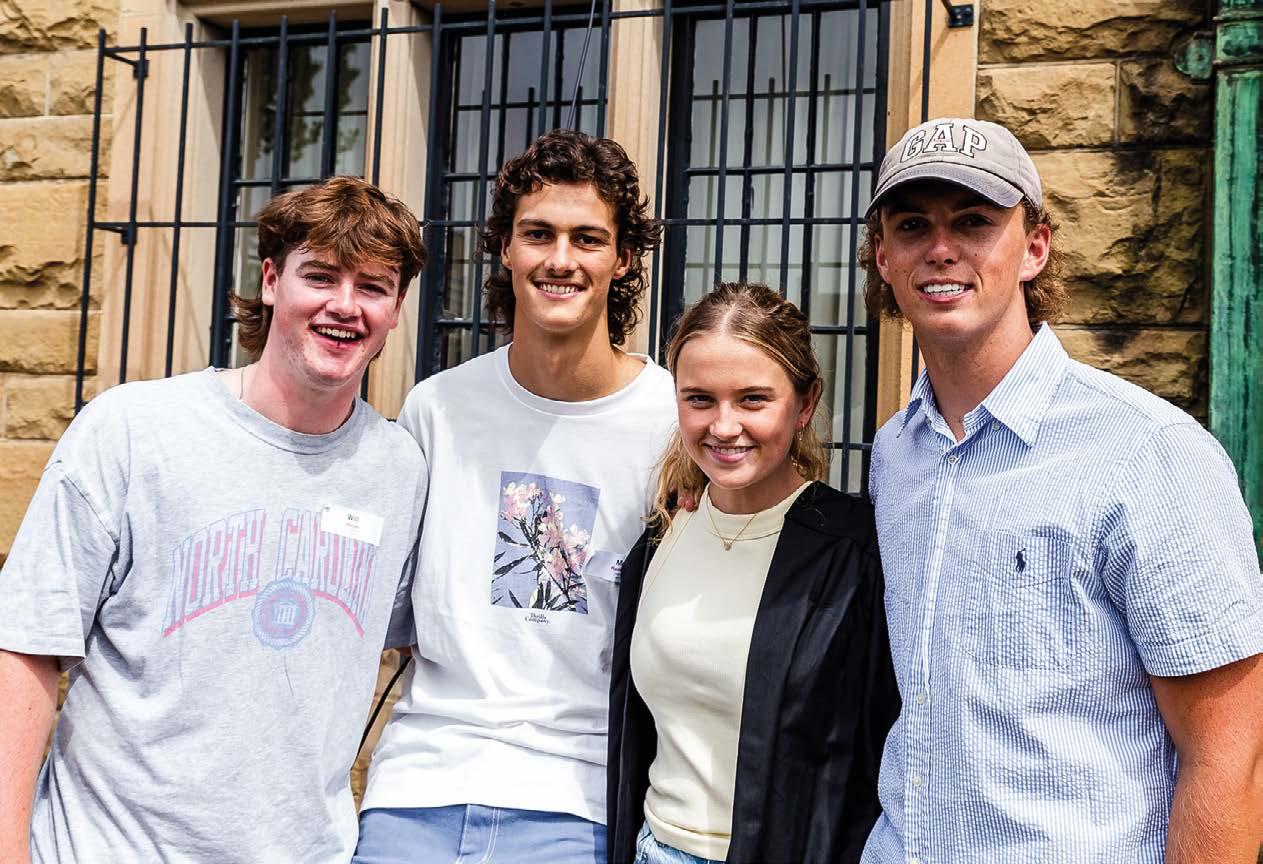
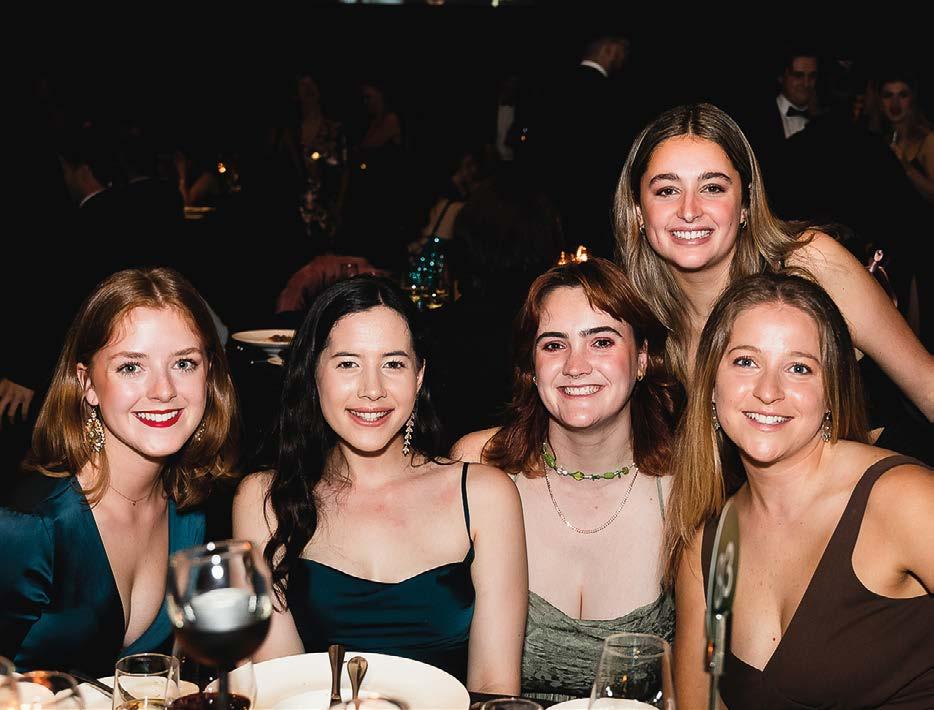
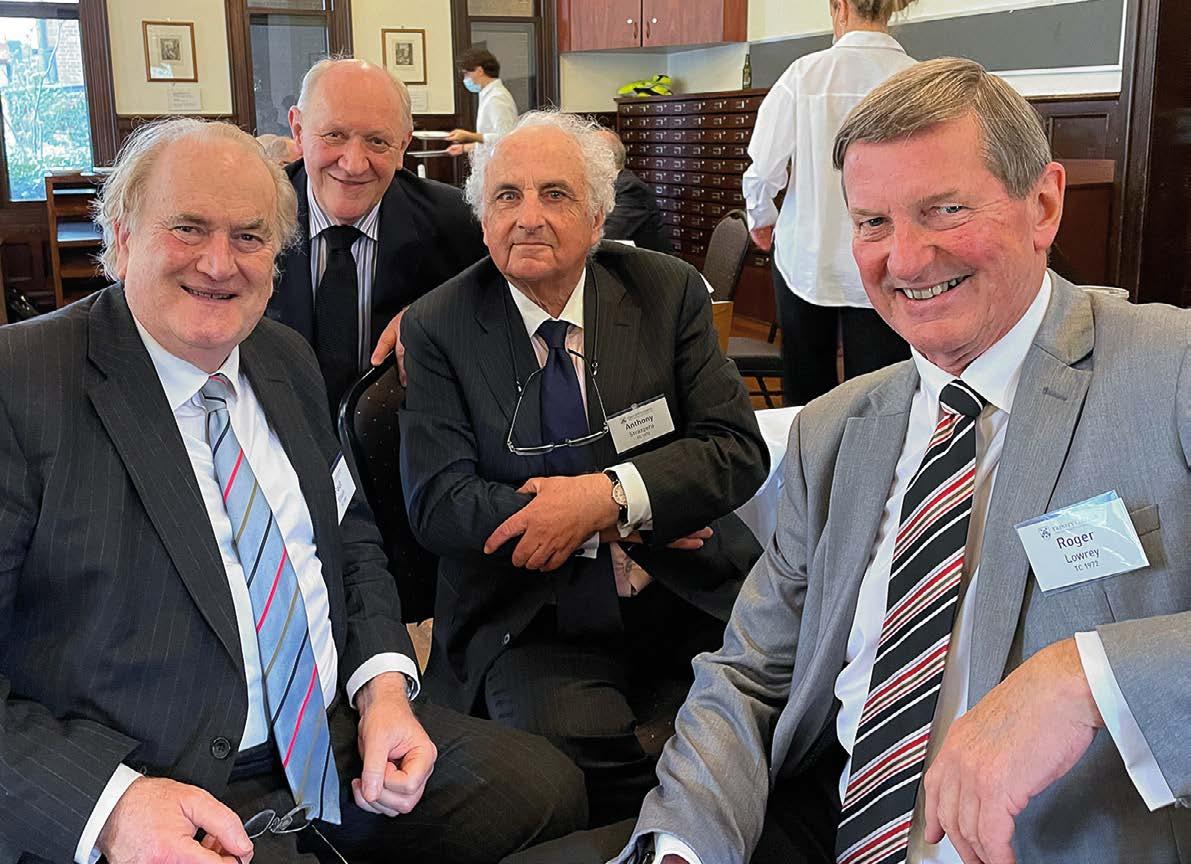
TRINITY TODAY ● 74 EVENTS
Paul Elliott (TC 1968), Terry Johansson (TC 1968), Anthony Strazzera (TC 1972) and Roger Lowrey (TC 1972) at the Seniors’ Lunch and 50-year reunion.
Will Harper (TC 2022), Max Ramsden (TC 2022), Gretel Larsen (TC 2021) and Jackson Streader (TC 2021) at Admissions Day.
Jael Sitte (TC 2021), Amy Cutter (TC 2020), Gabby McDonald (TC 2020), Harriet Grummet [TC 2021) and Bridget Lieberman (TC 2019) at Trinity’s gala dinner.


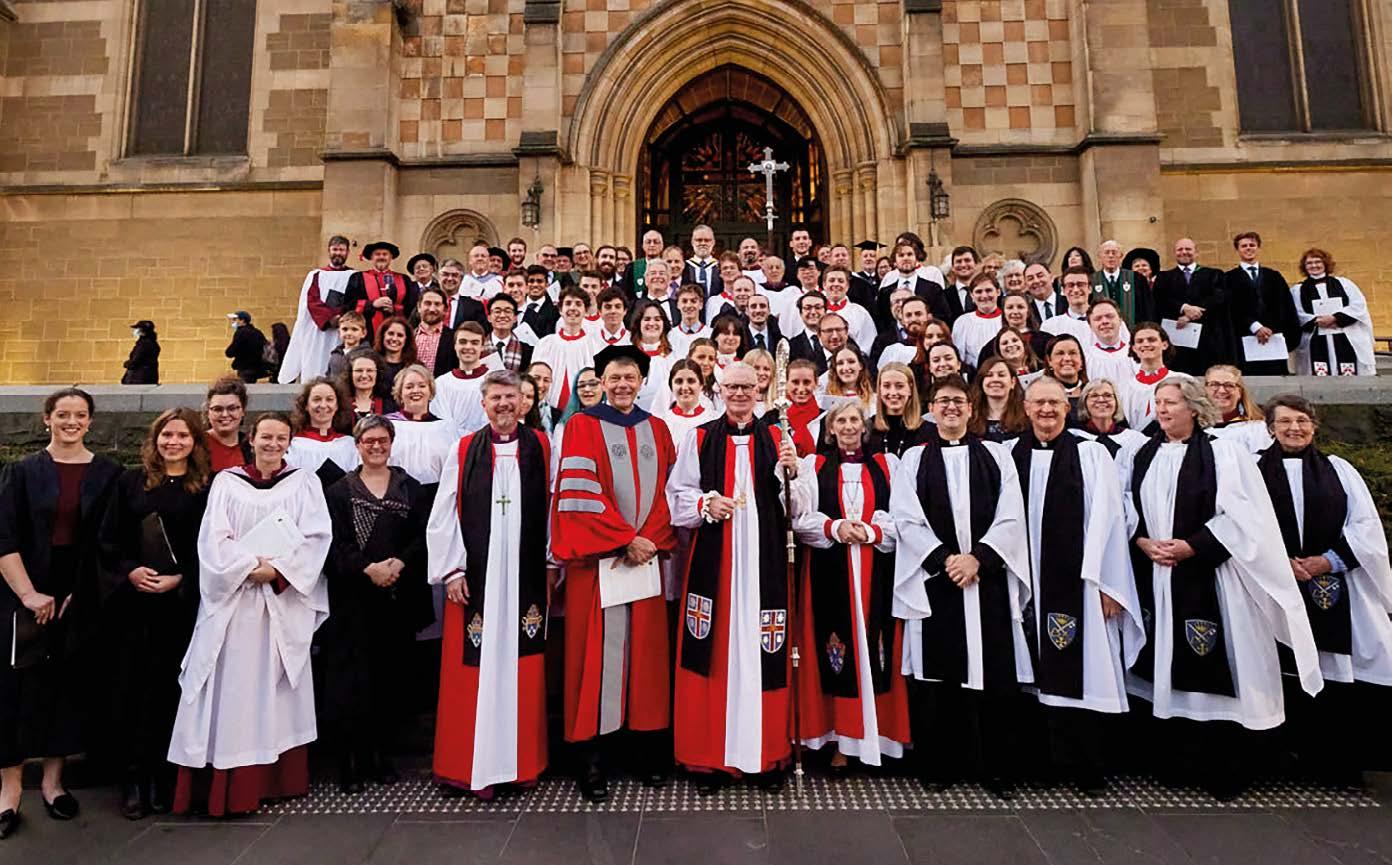

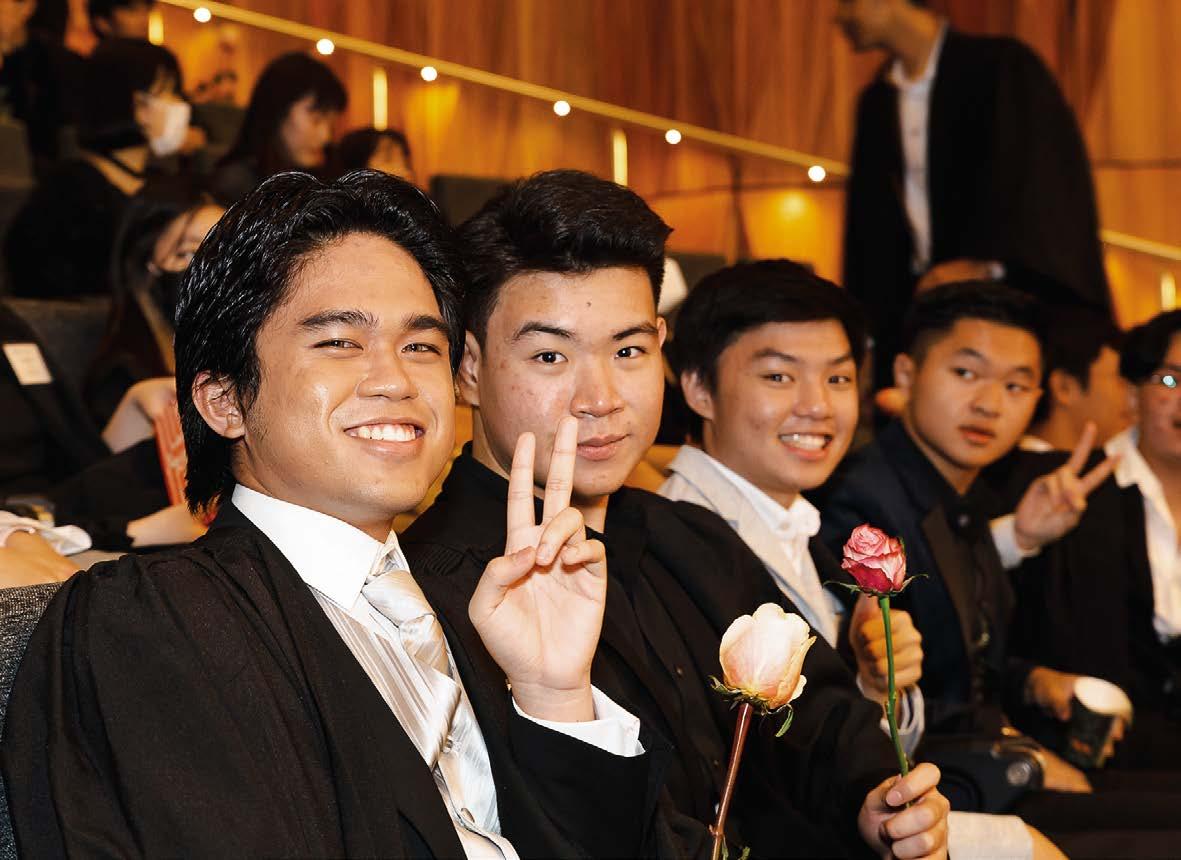
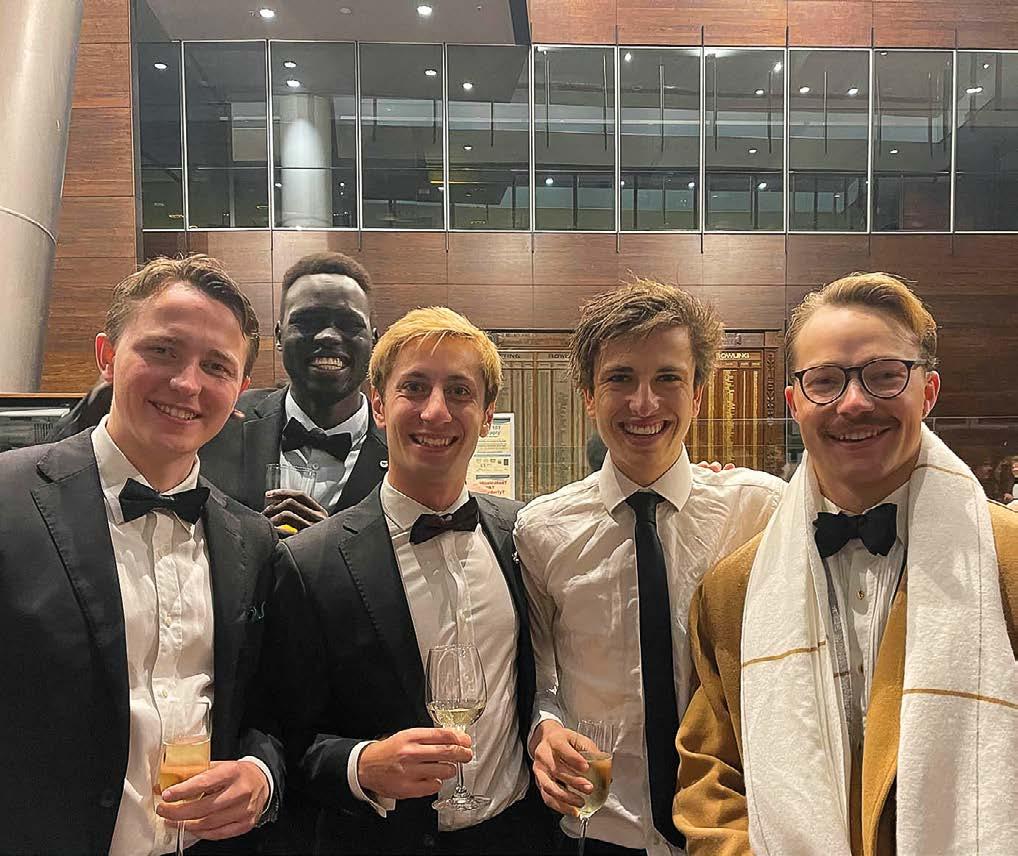
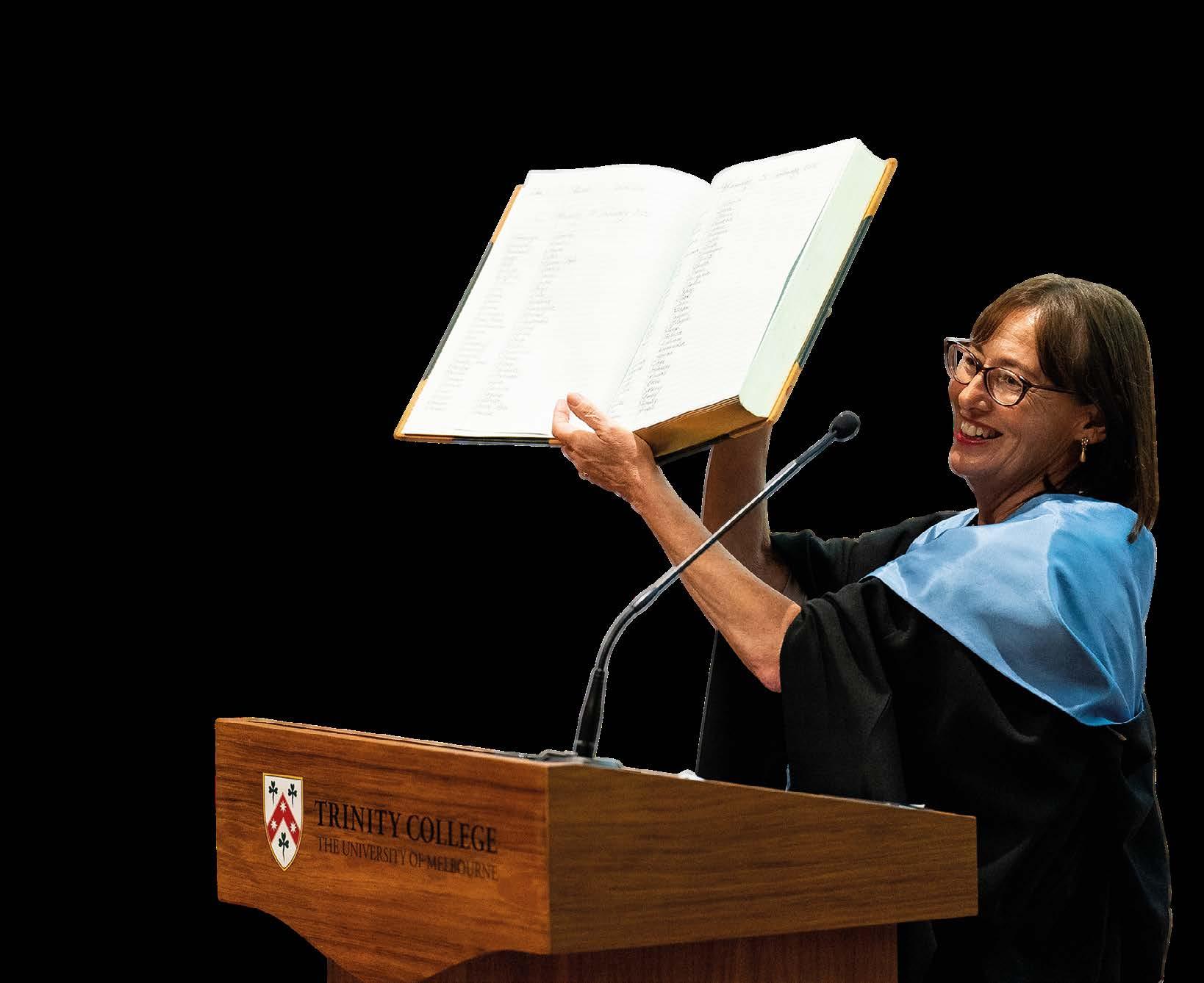
EVENTS ● 75 TRINITY TODAY
Pathways School 2020-21 alumni barbecue.
The Candystripes a cappella group take to the stage at our 150th gala dinner.
Residential College Dean Leonie Jongenelis at Admissions Day.
Abby Cox, Julian Smith (TC 1987), Brigitte Johnson (TC 1989) and Katrina Bromell celebrating at our 150th gala dinner.
A special Evensong to recognise our 150th anniversary at St Paul’s Cathedral.
Jude Panaguiton, Jason Wirawan, Enrich Wiguna and Heng Lean Lak (all TCFS 2021) at the Pathways School August Main and October Fast Track valedictory.
Riley Hanson (TC 2020), Akon Chol (TC 2020), Bartu Doruk (TC 2021), Ben Beischer (TC 2020) and Henry Edwards (TC 2018) at the student and recent alumni 150th anniversary ball at the MCG.
BRIAN ROBERTS (TC 1945)
29 July 1927 –7 August 2022
Brian Roberts was born on a soldier settler farm in Hopetoun. He joined Trinity College aged 17 and said the experience had a big impact on him, given his rural upbringing (even though he was ‘one of the poor students’ who started College life in the Wooden Wing).
Brian studied science at Melbourne University and worked in the paint industry after graduating. He then moved to England to work in the textile industry, and later returned to Australia where he became the general manager of Preservene Soap and ran a small business selling industrial adhesives.
Brian married June in the Trinity College Chapel in 1956 and the couple went on to have four children. His granddaughter Georgina (p. 66) followed in his footsteps to Trinity.
VALETE
ALAN CUTHBERTSON (Senior Fellow)
23 October 1929 –2 November 2021
Born in Glen Iris, Alan Cuthbertson became a prefect at Scotch College in 1947.

He studied medicine at the University of Melbourne and trained in surgery at the Cleveland Clinic in the US after doing postgraduate work in the United Kingdom.
He and his wife, Janet, had four children, one of whom, Andrew, joined Trinity in 1980.
Alan and Janet developed Murrindindi Vineyards in Victoria’s High Country, having planted vines on their cattle property in 1978.
Alan was a respected physician, particularly noted for his excellent surgical technique, and a long-serving Trinity College tutor in surgery.
HON. ROBERT (CLIVE) TADGELL AO KC
THE
(TC 1956, Senior Fellow)
15 March 1934 –14 July 2022
Clive Tadgell grew up in Melbourne and attended Brighton Grammar and Wesley College. Clive studied law at the University of Melbourne, signed the Victorian Bar roll in 1960, and went on to be appointed a justice of the Victorian Supreme Court in 1980. At Trinity College, Clive was known as an excellent debater and won the President’s Medal for Oratory.

Clive was committed to the Christian faith and was a supporter of the Trinity College Theological School. He served as Chancellor of the Anglican Diocese of Melbourne and President of the Appellate Tribunal of the Anglican Church of Australia. Clive and his wife, Christina, had two children, one of whom, Malcolm, is the student president at the Trinity College Theological School.
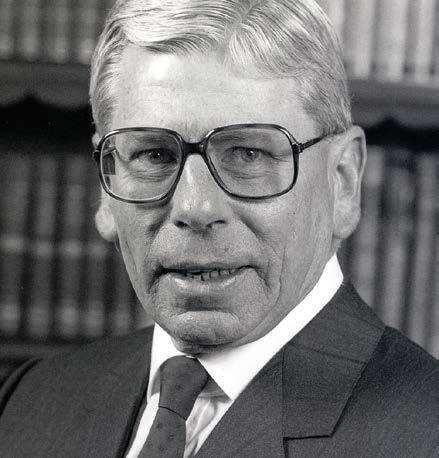
BRIAN LOTON AC (TC 1950, Senior Fellow)
17 May 1929 –29 March 2022
Brian Loton was born and raised in Western Australia. After leaving Hale School, he spent two years on his family’s property in the Swan Valley, then studied metallurgical engineering at the University of Melbourne, graduating in 1953. He joined BHP as a cadet in Newcastle and stayed with the company for his entire career. He rose to the position of CEO in 1984 and became chairman in 1992.
As a student at Trinity College, Brian was on the TCAC, and later became the president of the Fleur-de-Lys, holding the position from 1985–87.
Brian and his wife, Jill, had four children. His daughter Carolyn, son Warwick and grandchildren Lachlan and Jackie Kirwan attended Trinity.
ANGUS TRUMBLE (TC 1983, Fellow)

6 October 1964 –8 October 2022
Angus Trumble was born in Melbourne and attended Melbourne Grammar. He studied fine arts and history at the University of Melbourne, then moved to Italy, where he interned at the Peggy Guggenheim Collection.
He returned to Melbourne to serve as aide to the Governor of Victoria from 1987–91, then took up positions including curator at the Art Gallery of South Australia, senior curator at the Yale Centre of British Art (US), and director of the National Portrait Gallery. He was also a Fulbright scholar and an Honorary Research Fellow with the National Museum of Australia.
Angus was on Trinity’s Art Committee and was made a Fellow in 2022.
We are saddened to acknowledge the passing of the following alumni and friends of Trinity College.
Roger Keith Ackland (TC 1958)
Peter Noel Anderson (TCTS 1992)
John Noel Barron Bryson AM (TC 1955)
Dr John Carre-Riddell (TC 1948)
Robert Dalton Cooke (TC 1944)
John Adrian Cuming (TC 1950)
Margaret Dahlenburg (former TCFS staff member)
Kate Mackay Day (TC 1987)
Richard Hamilton Gardner (TC 1947)
The Reverend Dr Helen Barbara Granowski (TCTS 1990)
William James Henty (TC 1955)
Douglas Graham Hill (TC 1951)
Nigel Antony Jackson (TC 1958)
Dr Alan Scott Jenkins (TC 1967)

Dr Neil Robert Johnstone (non-res tutor)
Evan Lloyd Jones (TC 1951)
Dr Peter McKay Keddie (TC 1958)
Dr Donald Edward Kennedy (TC 1948)
Dr Leslie Clements Langford (TC 1950)
John Bryan Lawley (TC 1959)
Edward Peter Lincoln (TC 1953)
Malcolm Thomas MacLeod (TC 1954)
The Reverend Barry Neil Martin (TC 1958)
Valerie Miles (former TCFS staff member)
Edward William Muntz (TC 1950)
Joan Northrop (TC 1977)
Malcolm Mungo Steele Park (TC 1956)
Michael Pidgeon (TC 1961)
Richard Potter (TC 1947)
Dr Kenneth Stuchbery (TC 1953)
David Emlyn Liddon Thomas AM (TC 1958)
William John Traill (TC 1953)
Albert Arthur Twigg (TC 1951)
William Robert Van Valzah (TC 1952)
The Honourable Justice
Peter Norman Vickery (TC 1968)
David Neil Syme Walford (TC 1979)
Christopher Graham Wood (TC 1968)
Karen Margaret Workman (TCTS 2021)
Trinity College commissioned Harper & Charlie, the illustration agency famous for producing retro-style prints of iconic landmarks such as Flinders Street Station and Luna Park, to create a commemorative vintage print to celebrate Trinity’s 150th anniversary.
Head to our online store to view available sizes and purchase: shop.trinity.unimelb.edu.au

You can also purchase the book The Triumphs of Our Fleur-de-Lys: 150 years of Trinity College Melbourne.
Read more about the inspiration behind the print.






















































































 BY EMILY M c AULIFFE
BY EMILY M c AULIFFE














 In 1980, the men’s basketball team did a great job of accidentally representing all four eras of The Beatles.
In 1980, the men’s basketball team did a great job of accidentally representing all four eras of The Beatles.




















































































